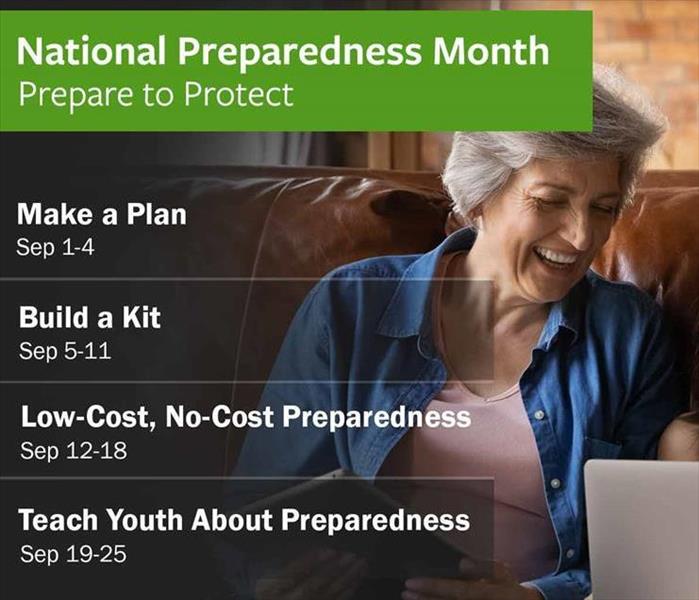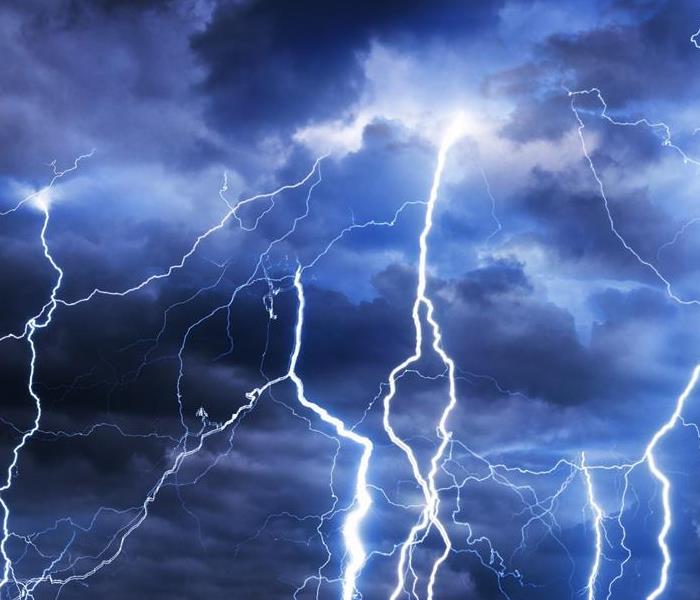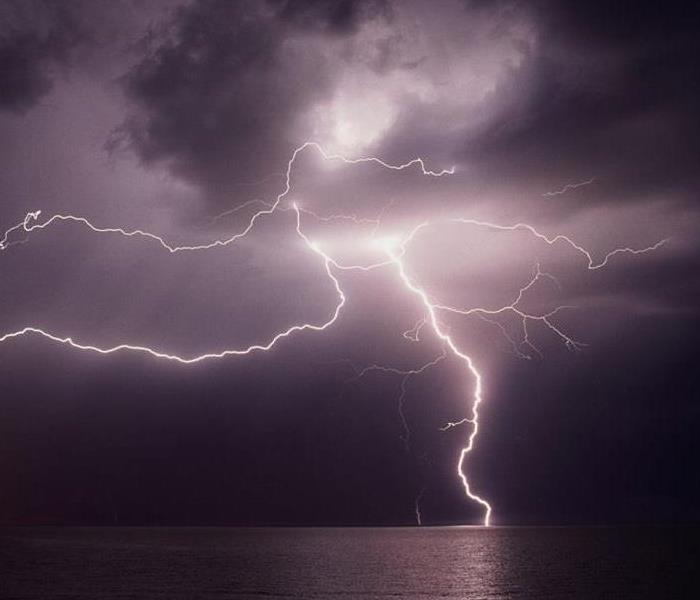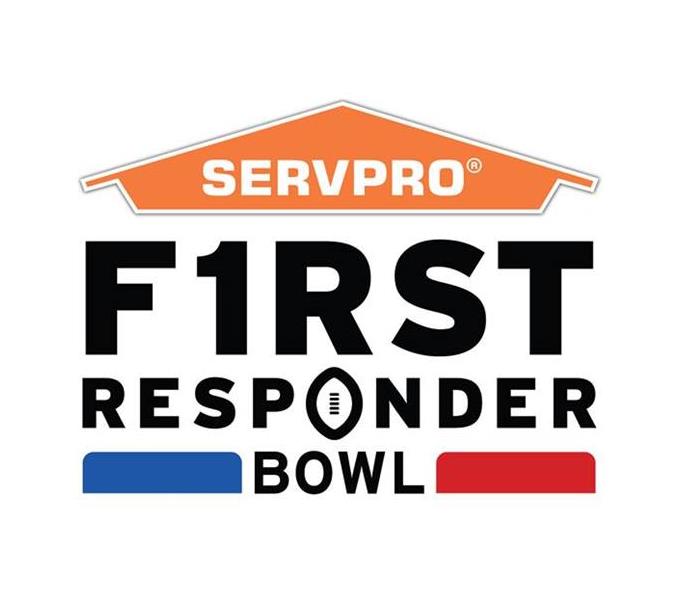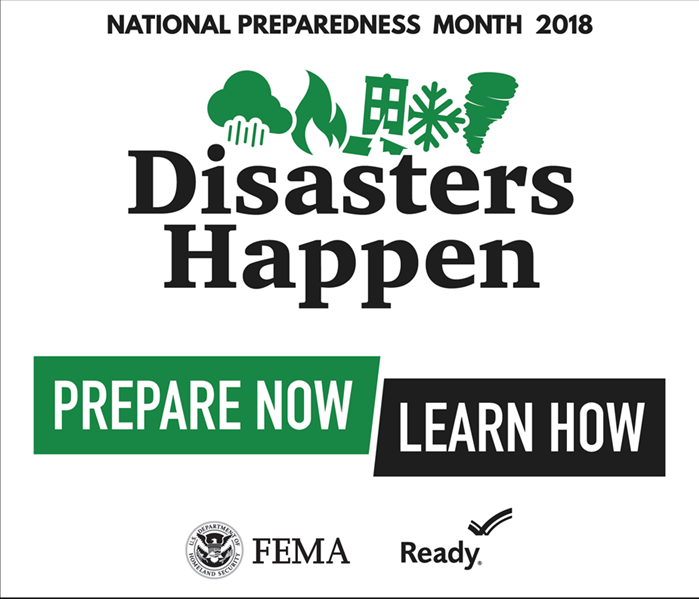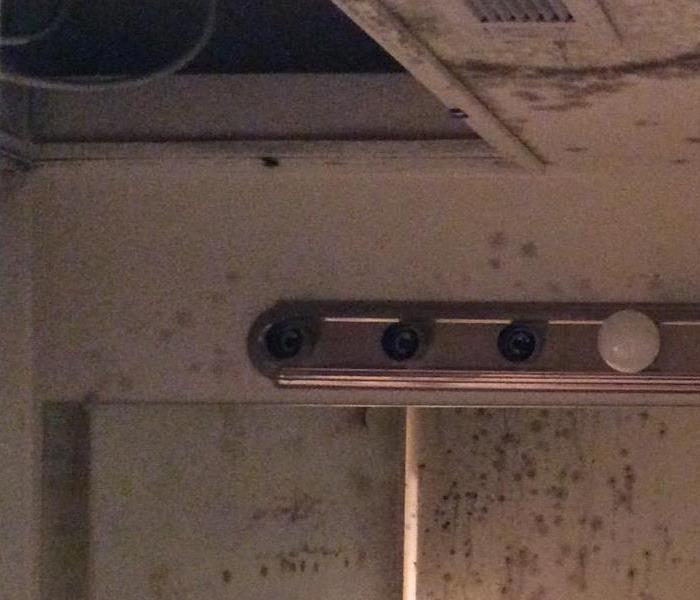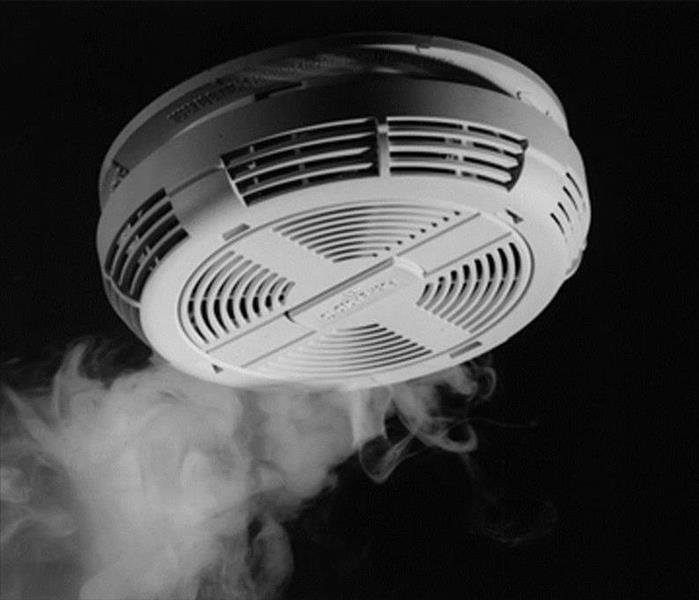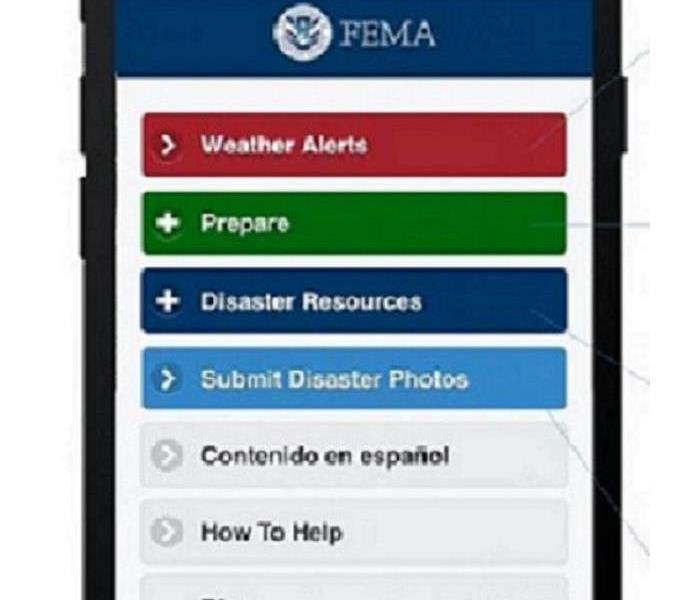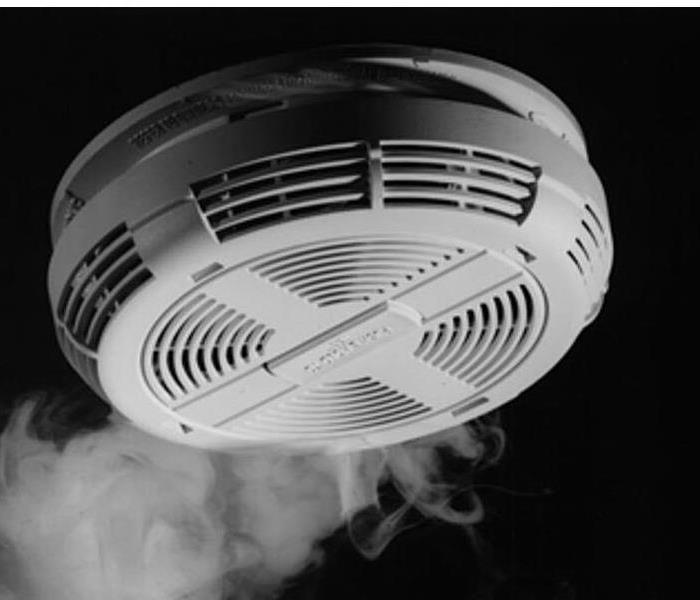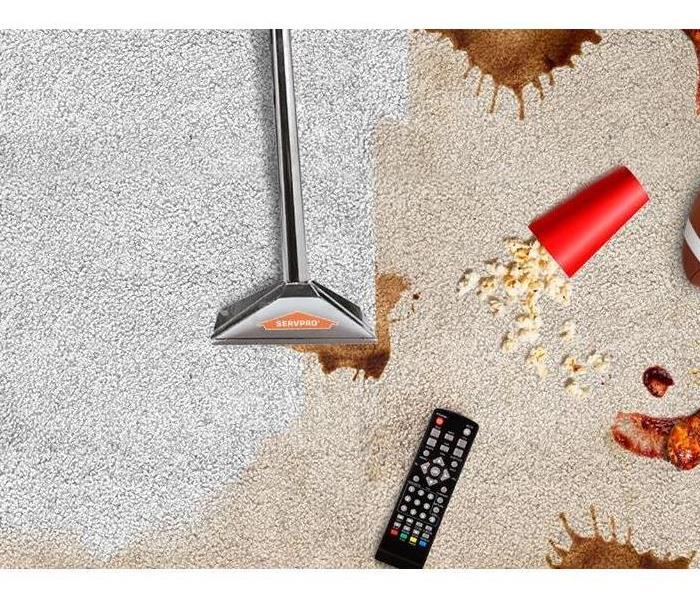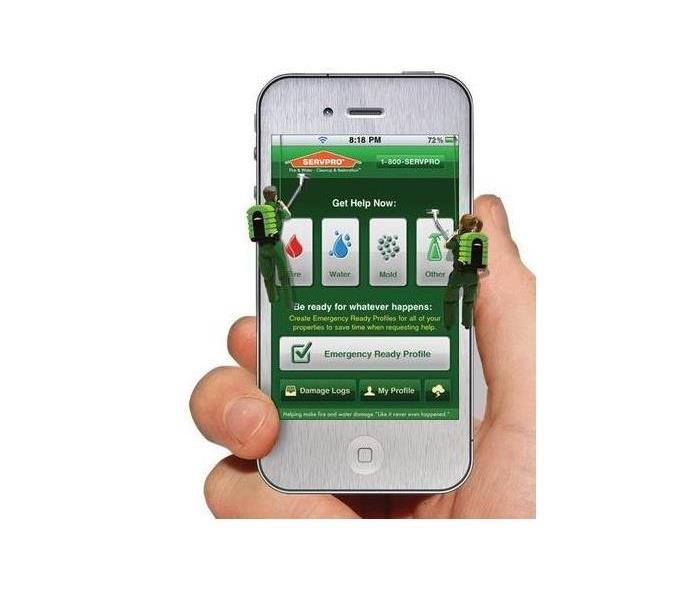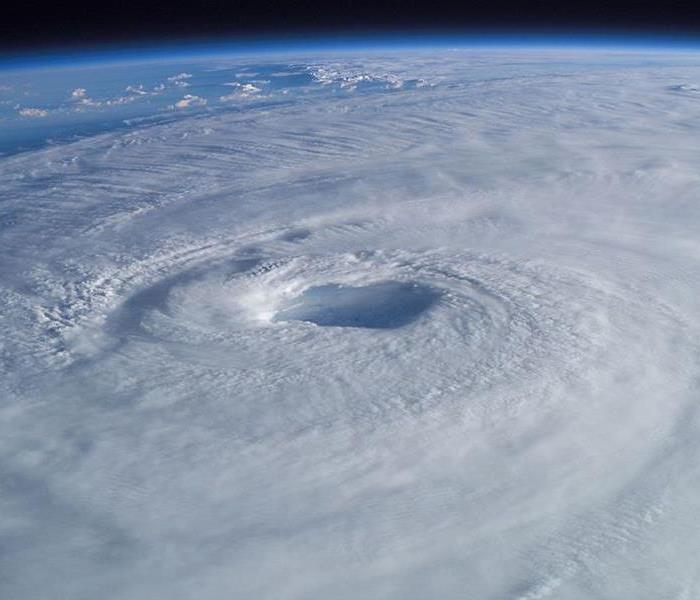Archived Blog Posts
How Is Sewer Damage Cleaned? Essential Steps You Don't Want To Skip
8/27/2022 (Permalink)
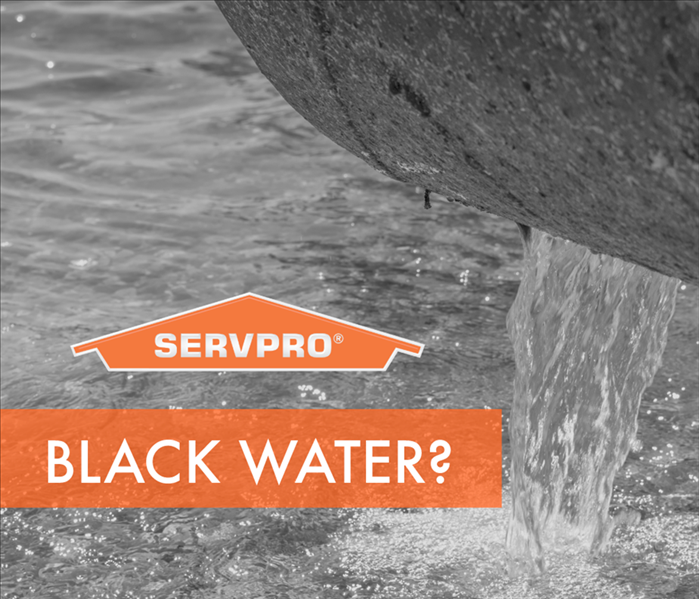 Don't let black water sit and linger.
Don't let black water sit and linger.
How Does Sewer Damage Get Cleaned? You Don't Want To Miss These Steps
Sewer cleanup requires more than a mop, towel and bucket of cleaner. This fluid, known as black water, consists of high levels of mold spores and bacteria, which can absorb into your floors and walls. To ensure your commercial space is sanitized thoroughly, following specific guidelines is imperative. The following are four steps you don't want to skip.
1. Discover the Cause of the Sewer Backup
Cut off the water supply to the bathroom and, before cleaning, locate the reason the overflow occurred. Common causes include blockages from hair, personal products and grease. Lines under the ground may also suffer corrosion or cracks, particularly from tree roots.
These issues are hard to see; therefore, call water restoration experts in Elizabeth, TX, to inspect the plumbing. They have innovative technology to scope the pipes and assist in the cleaning stages.
2. Assess Water Exposure
Sewer water is classified as category three contamination because it contains a host of organisms such as bacteria and mold. A group of specialists should examine the impacted space, gathering specimens of the air and materials. This information allows team members to establish a sewer cleanup plan specific to your company's needs.
Water migrates easily, spreading through the drywall, ceiling and floors. You may not realize the extent of dampness. Teams use moisture readers to pinpoint affected zones.
3. Minimize Secondary Damage
Water penetrates porous material, allowing organisms to migrate into your walls, floors and valuables. Before cleaning, concentrate on mitigating spore reproduction and structural rot.
Certified technicians evaluate your room's contents for concern. They remove unaffected pieces to avoid further harm. In addition, the flooded toilet delivered excess moisture and humidity. Extract that dampness efficiently using air movers and industrial dehumidifiers.
4. Sanitize and Restore
Wash and scrub down nonporous items using an antimicrobial treatment. Teams can use high-tech equipment to deodorize the location. Then, attention turns to rebuilding, returning the premises to proper working order.
Don't let black water sit and linger. Follow proper sewer cleanup protocols to ensure to reduce water and organism exposure.
How To Lower Your Business Interruption Insurance Claim
8/27/2022 (Permalink)
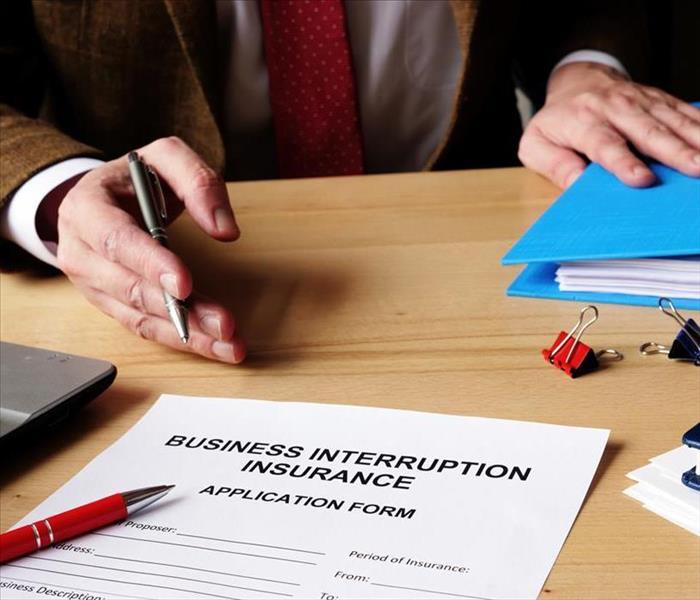 You can lower your business interruption insurance claim and get back on track.
You can lower your business interruption insurance claim and get back on track.
How To Reduce Your Insurance Claim for Business Interruption
If your building in Beaumont, TX, experiences a water-related incident such as flooding from a broken pipe, you may be forced to halt business operations until repair and restoration efforts are completed.
Business interruption insurance is designed to provide compensation for lost income during this time. The standard period of coverage is 30 days, but what if restoration efforts take longer than that?
There are many many factors that affect the duration of the restoration process, such as the extent of the water damage, the quality of restoration services rendered, and the effectiveness of communications with your insurance provider.
Here are several ways to promote a quick recovery and lower your business interruption claim.
1. Address Flooding Promptly
Flooding can damage just about anything in your building, including walls, ceilings, floors, equipment, and paper documents. If water is left to sit, mold growth can occur within a day or two, which will complicate restoration efforts and likely prolong the restoration process. If you address large water damage as soon as possible, you can shorten your building's recovery time.
2. Hire Professional Restoration Services
Water damage to commercial buildings often requires professional restoration services. It is important to contact a team of professionals quickly so that you can restore as much of your property as possible. The team will also be able to ensure that all water is removed so that you can avoid mold growth.
3. Keep Detailed Records
Take photos of every incidence of damage from multiple angles. Keep records of all communications with the restoration company and the insurance company. Inadequate record-keeping and ineffective communication can lead to a claims process that is longer than it needs to be.
Following these tips will help your business bounce back from water damage quickly. You can lower your business interruption insurance claim and get back on track.
Does an Adjuster Need To Inspect Damage Prior to Mitigation?
8/22/2022 (Permalink)
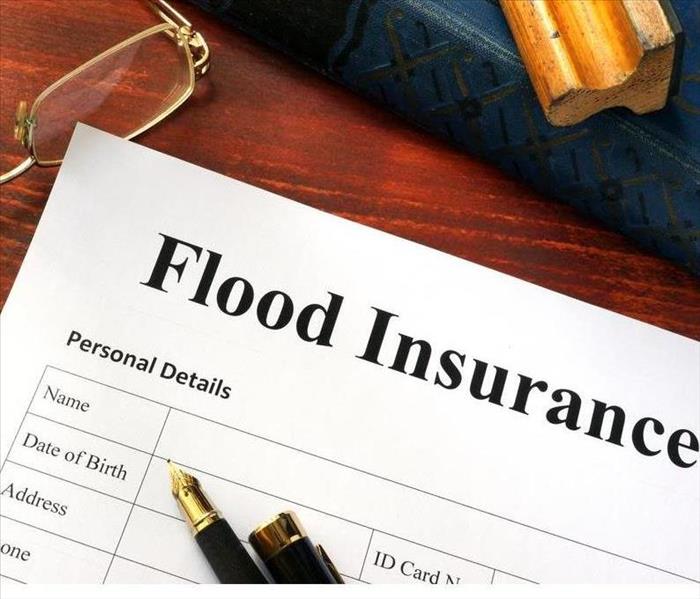 If an adjuster cannot see how bad the damage was, he or she may be less likely to settle a flood insurance claim for the full amount.
If an adjuster cannot see how bad the damage was, he or she may be less likely to settle a flood insurance claim for the full amount.
Is it necessary for an adjuster to inspect damage prior to mitigation?
Homeowners dealing with flood damage may wonder whether they should start mitigation before an adjuster arrives to assess losses. If there has recently been widespread flooding or severe weather in Beaumont, TX, adjusters may have a lengthy backlog. It can be worthwhile to mitigate damage as soon as possible. Here are a few pointers on starting mitigation for homeowners who plan to make a flood insurance claim.
Documentation Before Mitigation
A homeowner must capture the full extent of damage prior to mitigation. There are several useful forms of documentation:
• Photographs
• Video footage
• Professional estimates
This evidence will be necessary to support a flood insurance claim. Even if mitigation is underway when an adjuster arrives, proof of damage enables homeowners to obtain compensation for losses.
Provide Insurers With an Estimate
A professional estimate is also useful for making a claim. A one-stop damage mitigation and restoration company can provide a complete estimate. Insurers are more likely to accept an estimate calculated by a preferred vendor.
Schedule a Visit From an Adjuster
An adjuster will probably need to visit the property to process a claim. Homeowners should provide documentation and explain mitigation measures. Insurers require property owners to do everything in their power to limit primary damage and avoid secondary mold damage. Timely mitigation may make it easier to settle a claim.
It is crucial to document the worst of the damage caused by a flood or storm before taking mitigation measures. If an adjuster cannot see how bad the damage was, he or she may be less likely to settle a flood insurance claim for the full amount. Keep in mind that most standard homeowners policies exclude flood damage, and a separate flood policy is necessary. Relying on a company that provides both mitigation and restoration services will enable homeowners to give insurers a single estimate and expedite the claim process.
House Fire Facts
5/25/2022 (Permalink)
House Fire Facts
- House fires cause nearly 4,000 deaths and over 2,000 server injuries to Americans every year.
- Heat from a fire can reach over 1,100 degrees in less than 4 minutes.
- About 80% of civilian deaths are from house fires.
- Areas without fire in them can get up to 300 degrees, which is hot enough to melt plastics.
- Leading cause of fire deaths is careless smoking.
- A working smoke detector more than doubles the chance of survival in a house fire.
Causes of House Fires
- Faulty appliances/ wiring causes the greatest amount of house fires.
- Heating devices such as heaters, wood stoves, and fireplaces. Most fires start when something like furniture, boxes or clothing overheat from being placed to close to the heat source.
- Cigarettes being dropped onto furniture like beds, sofas, or chairs.
- Children playing with fire causes house fires every year.
For more information, visit Home Fire Facts | SF Fire Website (sf-fire.org).
What To Do Before a Hurricane
5/25/2022 (Permalink)
Evacuation
- If advised to evacuate, know where you will go and how you will get there.
- Plan before hand if you need help with transportation.
- Mobile, manufactured, trailer homes and recreational vehicles are not safe in high wind events.
Shelter
- Prepare to live without power, water, gas, phones, and internet for an extended period.
- Practice going to a designated safe shelter for high winds. The best shelter would be a small room with no windows on the lowest level that is least likely to flood.
- Flooding can happen quickly, so be prepared to evacuate fast if needed.
Stay Connected
- Sign up for free emergency alerts for your local government and monitor the local news and weather.
- Have a backup battery or a way to charge your cellphone.
- Have a battery powered radio in case of a power outage.
- Understand the difference in alerts-
- A WATCH means be prepared
- A WARNING means take action
- Plan for electrical needs including medical equipment. Talk to your doctor and plan for backup power.
Emergency Supplies
- Gather food, medicine, and water. Stores and pharmacies may be closed and create and Go-Kit and Stay-at-Home Kit.
- Go-Kit: At least 3 days of supplies you can carry with you. Include backup batteries and chargers for devices. (Cell phones, CPAP, wheelchair, etc.)
- Stay-at-Home Kit: At least 2 weeks of supplies.
- Have a 1-month supply of medicine and medical supplies in a childproof container.
- Keep personal, financial, and medical records safe and easy to access (hard copies or securely backed up on a form of technology). Consider keeping a card with medical information and dosages.
Protect your Home
Wind
- Secure or bring inside outdoor items like lawn furniture, trashcans, and anything that can be picked up by wind and hurt someone.
- Anchor objects that are unsafe to bring inside, like gas grills and propane tanks.
- Protect windows with permanent storm shutters or sheeting.
Flood
- Clean our drains, gutters, and downspouts.
- Stockpile protective materials like sandbags and plastic sheeting.
- Consider elevating heating systems, water heaters, and electric panels.
- Review insurance policies with your agency.
What To Do During and After a Hurricane
5/25/2022 (Permalink)
During a Hurricane
Evacuation
- If advised to evacuate, go quickly.
- Bring a Go-Kit: at least 3 days of supplies and batteries.
- Follow evacuation routes and do not take short cuts because they may be closed.
- Check with local officials for shelter locations. Download the Red Cross Emergency App to find shelters near you.
Protection from High Winds and Flooding
- Take shelter in a designated storm shelter or an interior room for high winds.
- Stay away from glass windows and doors.
- Move to higher ground before flooding begins.
- Never walk, swim, or drive through floodwater.
After a Hurricane
Staying Safe
- Wait for officials to say it is safe before going back home.
- Avoid fallen, drowned, or damaged powerlines and poles. They can electrocute you.
- Do not touch floodwaters because they may contain sewage, bacteria, and chemicals.
- If power is out, use battery powered light sources to reduce fire risks.
- Gasoline, propane, natural gas, or charcoal-burning devices inside enclosed spaces.
- Throw-out food that got wet or warm.
- Monitor local health department for information about drinking water safety, as flooding and hurricanes can make it unsafe.
Cleanup
- Wear appropriate protective equipment including gloves, googles, and boots.
- Clean and disinfect anything that got wet.
- Work with a partner when clearing heavy debris.
- Have the proper training before using equipment, like chainsaws.
Health
- Heart attacks are the leading cause of death after hurricanes from overworking.
- Check with doctors about refrigerated medicines.
- Eat healthy foods and get enough sleep to help deal with stress.
- Stress and anxiety after hurricanes are normal.
For more information, visit Hurricane Preparedness Checklist (redcross.org)
Watch vs. Warning
5/25/2022 (Permalink)
Severe Weather
Texas is known for the changing weather conditions. Severe weather like hurricanes, tornadoes, and lighting can hit at any instant. It is important to know the difference between a watch and a warning. Both can be issued by the National Weather Service. It can be released to a specific amount of time in certain areas.
Watch
A watch means the community should watch the sky because conditions make it possible for the development of severe weather. Keeping an eye on the weather and staying tuned to the local radio and televisions in case conditions worsen.
Warning
A warning indicates severe storms or tornadoes have been spotted or is indicated on a National Weather Service Radar. All of those within the designated areas should seek shelter and take cover immediately until the danger passes.
For more information, visit https://www.friscotexas.gov/333/Severe-Weather.
Portable Grill Safety
5/20/2022 (Permalink)
Food plays an important role in outdoor festivities throughout the year and portable grills make it possible to be away from home. While they are smaller, they still have risks. Here are some tips on how to be safe during your adventurous summer!
Environment
- Only grill where there are no fire restrictions in place. Check to make sure you are permitted to grill in the area.
- Check fire danger ratings in the area to check if weather or other factors make it dangerous to light a flame.
Safely Starting Charcoal
- Charcoal Chimney starters allow you to ignite the charcoal using newspaper. Use a long match to avoid burning your fingers when lighting the paper.
- Only use a lighter fluid intended for charcoal grills.
- Never add charcoal starter fluids to coals or kindling that has already been ignited.
- Never use gasoline or other flammable liquids except charcoal starter or lighter fluid to start a charcoal fire.
Cooking Safety
- Place the grill away from overhanging branches, foot traffic, lawn games, and play areas.
- Keep children and pets, anything that can burn, and oven mitts and towels at least 3 feet away from open flames and heat.
- Use long handled grilling tools to have clearance from you and the heat and grill.
- Never leave the fire unattended.
Disposing of Charcoal
- Douse the fire with water and make sure it is cold to the touch before leaving the area.
- Empty coals into a metal container with tight-fitting lid that is used to collect coal only. Place the container away from anything that can burn.
- Never empty coal directly into a trashcan.
- Store charcoal and starter fluids away from children and heat sources.
For more information, visit Outdoor cooking safety with portable grills | NFPA
Commercial Cleaning- Biohazards and Sewage
5/19/2022 (Permalink)
Biological and chemical containments can cause significant damage when not properly removed. Failure to correctly clean such substances contributes to unsafe and unhealthy environments. SERVPRO of Beaumont is trained and equipped with the necessary products to clean and dispose of biohazards correctly, according to OSHA and health regulations. Decontamination due to biohazard can not only be dangerous but emotional as well, and training and experience is key when choosing a cleanup company to achieve transforming your commercial buildings back into healthy and safe environments for you and your employees. SERVPRO of Beaumont provides cleanup and decontamination of the following:
- Sewage backups
- Crime scene residues
- Suicide/death accidents
- Homicide cleanups
- Blood cleanups
- Accident cleanups
- Hoarding scenes
- Animals waste/remains
- Chemical spills
- Tear gas cleanup
- Illegal Drug Manufacturing Labs
For more information on Commercial Biohazard Cleanups, call us today at (409) 212- 1977!
What To Do Until Help Arrives- Biohazard
5/19/2022 (Permalink)
Biohazard contaminants, like sewer backups and flood water, can cause extensive damage to your business. SERVPRO of Beaumont has the training and equipment to effectively and safely clean up and restore your business. But it is important to know what to do and what not to do, so here are some tips on what you can do until help arrives.
Safety
Your primary focus should be safety after any biohazard contamination.
- Is it safe to stay in the building?
- Minimize exposure to biological and chemical contaminants
- Flood water can contain sewage, pesticides, and other contaminants.
What to Do After Contamination
- Stay away from affected areas.
- Call emergency personnel if the situation is life-threatening.
- Treat ALL bodily fluids as if they are contaminants.
What Not to Do After Contamination
- Don’t use household vacuum to remove water.
- Don’t use appliances, televisions, or any electronics connected to potentially affected outlets.
- Don’t turn on ceiling fixtures if ceiling is wet and keep out of areas where the ceiling is sagging.
Biohazards should be treated as an emergency and SERVPRO of Beaumont has the specific training and expertise to safely remediate these contaminants.
For more information call SERVPRO of Beaumont now, at (409) 212- 1977.
Commercial Mold Remediation
5/17/2022 (Permalink)
A mold issue on your commercial property can create a significant amount of damage to the building. Mold growth can happen quickly in our region of the country. In Southeast Texas, mold is just about everywhere because of our high humidity levels, conditions that are ideal for mold to grow. If you suspect that your property may have a mold problem, call SERVPRO of Beaumont. We can quickly respond to your needs and work fast to get you back in business.
- 24 Hour Emergency Service
- Faster to Any Size Disaster
- A Trusted Leader in the Mold and Water Restoration Industry
- Highly Trained Mold and Water Damage Restoration Specialists
Certifications
- Applied Microbial Remediation Specialist
- Water Damage Restoration Technician
- Applied Structural Drying Technician
- Odor Control Technician
- Upholstery and Fabric Cleaning Technician
If you believe there is a mold problem in your building, call us today at (409) 212-1977!
National Flood Insurance Program
5/16/2022 (Permalink)
The National Flood Insurance Program policy covers direct physical losses to your belongings and structures after a flood event. The NFIP has two types of coverage: your home itself and your belongings. Here are some examples of what IS covered by your flood insurance policy:
Building Coverage
- Electrical and Plumbing Systems
- Water heater and furnaces
- Refrigerators, stoves, ovens, built-in appliances like dishwashers
- Permanently installed fixtures, such as carpeting, cabinets, paneling, and bookcases
- Window blinds
- Foundation walls, anchorage systems, and staircases
- Detached garages
- Fuel tanks, pumps and well water tanks, and solar energy equipment
Content Coverage
- Personal belongings like clothing, furniture, and electronic equipment
- Curtains
- Washer and Dryer
- Portable and window air conditioners
- Microwave oven
- Carpets not included in building coverage like carpet installed over wood floors.
- Valuable items like original artwork and furs (up to $2,500)
What isn’t covered by flood insurance?
Flood insurance is determined by the cause of flooding and only covers damages directly caused by the flooding. For example, losses caused by a sewer backup is covered if the backup is a direct result of flooding. Here are some examples of things not covered by insurance:
- Temporary housing and additional living expenses while the building being repaired is unable to be occupied
- Property outside of the insured building like wells, landscaping, decks and patios, fences, swimming pools, etc.
- Financial losses caused by business interruption
- Currency, precious metals, stock certificates and other valuable papers
- Cars and most self-propelled vehicles, including their parts
- Personal property kept in basements
For more information about your coverage talk to your insurance agent before hurricane season starts, and visit FloodSmart | What Does Flood Insurance Cover?
Preventing Water Damage to Foundations
5/9/2022 (Permalink)
The most efficient way to prevent and/or fix a problem is to hire a structural engineer to help, as there can be a wide range of solutions they can provide. However, there are some measures you can take on our own to prevent water damage to the structure’s foundation.
Checking the length of Downspouts
A downspout is a pipe that helps direct rainwater off your roof and away from the building. These need to be as far from your home’s foundation as possible. Without the correct length, the downspout’s purpose is essentially defeated.
Have an Outward- Sloping Landscape
The landscape of your home is very important. Ideally, the ground your home is built on should slope downward to prevent collection of water around your home.
Gutter Cleanup
Gutters around your home need to be free of debris so they should be cleaned as often as possible to prevent clogging.
For more information, visit House Foundation Water Damage: Signs, Causes & Prevention Guide (safeandsanitaryhomes.org)
Causes of Water Damage
5/9/2022 (Permalink)
There can be multiple causes of water damage to a home’s foundation. Water damage can result due to one or more of these likely causes:
- Underground & surface water
- Trees to close to the building
- Poor drainage
- Unstable soil
Underground Water
There are 2 types of underground water: natural occurring and plumbing installations. Natural occurring water includes springs close to or beneath the home. The presence of underground springs may be caused by proximity of pods or other bodies of water. Artificial underground water alternately is created from plumbing installations that pass below a home. Leaks from installations may also affect your home’s foundation.
Surface Water
Surface water combined with the improper evaluation of the landscape causes damage from rain. Rain fall is expected to be directed away from the home by an outward slope of the landscape, but when a home is not graded correctly, it is likely to have pools of water form in your yard. Surface water can also collect around the home and can result in absorption through the foundation.
Tree Proximity
Trees are usually desirable to have around homes because of the benefits they produce but can turn out to be a hassle when they are too close to the structure. The roots of a tree extend outward to try and find water and nutrients. This can affect underground installations like sewer lines, plumbing, and drains. This results in clogging that can contribute to water damage.
Poor Drainage
The roof’s draining system is a vital structure to your home because they guide water down and away from the structure. However, when gutters and downspouts get clogged, water damage is likely to occur.
Unstable Soil
Certain soils are more compact than others and better for building structures on. Loose soil is more likely to cause significant structural problems from cracks and result in water damage because of easy flooding.
Signs of Water Damage
5/2/2022 (Permalink)
Water Damage - Foundation
Many times, homeowners are forced to deal with moisture issues that can weaken a structure's foundation. This moisture can also lead to issues like mold growth, termites, peeling paint, buckled wooden floors, and water stains on walls.
Signs of Water Damage
When there is water damage, the signs aren’t always obvious. They can be subtle or prominent depending on the scale and conditions of the damage. To the untrained eye, the signs aren’t quickly recognized until the problems worsen.
- Cracks in sheetrock
- Caulking disintegrating or pulling away from exterior surfaces surrounding fixtures and tubs
- Presence of ants within or around your home
- Difficulty closing or opening doors
- Cracks in stone or brick fireplace
- Window difficult to close
- Raised or cracked sections of floors
- Ceiling joints may be raised in addition to the possibility of nails pulling out of sheetrock
- Appearance of cracks in brick mortar
For more information visit, House Foundation Water Damage: Signs, Causes & Prevention Guide (safeandsanitaryhomes.org)
Is your business prepared for a disaster?
4/28/2022 (Permalink)
Here is how the SERVPRO of Beaumont & Orange/Nederland/Lumberton can help:
The SERVPRO® Emergency READY Profile® (ERP) will help ensure you are “Ready for whatever happens.” In the event of an emergency, the Emergency READY Profile can help minimize business interruption by having an immediate plan of action in place for your facility. The Emergency Ready Profile (ERP) is a comprehensive smart phone app that can document information that contains critical information about your business, including emergency contacts, shut-off valve locations, insurance information, utility contacts and priority areas. Call SERVPRO® of Beaumont & Orange/Nederland/Lumberton to set up your free Emergency READY Profile®!
The Emergency Ready Profile® app can be downloaded on Apple, Google Play and Android Platforms!
Call today at (409)-212-1977!
For Immediate Service in Beaumont, Call SERVPRO!
4/28/2022 (Permalink)
SERVPRO of Beaumont provides 24-hour emergency service and is dedicated to being faster to any-sized disaster in Beaumont. We can respond immediately to your emergency and have the expertise to handle your restoration or cleaning needs.
- 24-Hour Emergency Service
- Faster to Any-Sized Disaster
- Highly Trained Restoration Technicians
- A Trusted Leader in the Restoration Industry
- Locally Owned and Operated
- Advanced Restoration and Cleaning Equipment
Have Questions? Call Us 24/7 – 409-212-1977
Residential Services
Whether your Beaumont home needs emergency flood damage, or your upholstery cleaned, you can depend on us. Our technicians have extensive cleaning and restoration training and can make your property look its best. Learn more about our residential services:
- Water Damage Restoration
- Fire Damage Restoration
- Mold Remediation
- Storm Damage Restoration
- Cleaning Services
- Building/Reconstruction Services
Commercial Services
There's never a convenient time for fire or Water damage to strike your Beaumont commercial property. Every hour spent cleaning up is an hour of lost revenue and productivity. So, when the need arises for professional cleaning or emergency restoration services, we have the training and expertise to respond promptly with highly trained technicians to get your property back to business. Learn more about our commercial services: Beaumont, TX Water, Fire & Mold Damage Cleanup and Restoration (SERVPRObeaumont.com)
- Commercial Water Damage Restoration
- Commercial Fire Damage Restoration
Health Care Cleanup
4/27/2022 (Permalink)
At SERVPRO - our team members are trained in achieving the highest possible sanitation standards. Our technicians are adept in their understanding of ICRA guidelines and are trained to work in high-risk areas such as operating rooms, ICU, etc., while always complying with HIPPA regulations. We work with environmental and infection control specialists to make sure all necessary health and safety requirements are met. Our main priority is to allow you to focus on your patients and facilities quickly and safely, regardless of the size or scope of the disaster. We understand that your time is crucial for yourself and the patients in the facility’s care. Our ample experience in the healthcare industry allows us to offer a variety of services to the following:
- Hospitals
- Assisted Living Centers
- Outpatient Surgical Centers
- Hospice Facilities
- Rehab Facilities
- Medical Office Building
Commercial Cleaning Services
4/27/2022 (Permalink)
With SERVPRO’s commercial cleaning services, you won’t have to worry about the common wear and tear of your buildings or offices. When grit/grime, moisture, and odor overwhelm a standard janitorial service, call SERVPRO of Beaumont. You can rely on us to make your workspace the cleanest it’s ever been.
SERVPRO of Beaumont will get it done right the first time with our:
- Award-Winning Training
- Nearly 50 Years of Experience
- Proprietary Cleaning Products
Specialty Cleaning Services
SERVPRO offers a broad scope of cleaning services - from bloodborne pathogens to mold to fire/water restoration. Our technicians have specialized training and products to effectively clean your business and make it "Like it never even happened." We can do it all:
- Air ducts & HVAC
- Biohazard
- Carpet & Upholstery
- Odor Removal
Sewage - Trauma and Crime Scene
And much more - Call us today at 409-212-1977!
Fire Pit Safety
4/27/2022 (Permalink)
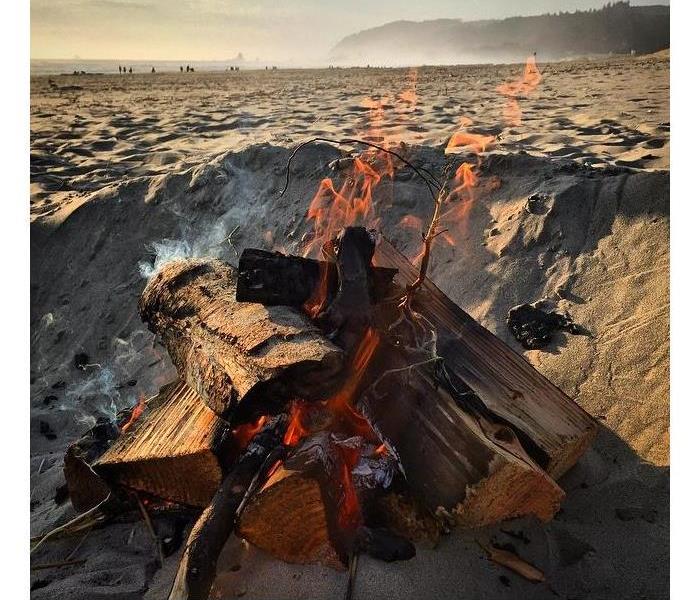 An example of a homemade firepit.
An example of a homemade firepit.
Spring is here, summer is right around the corner, and it's time for camping and trips to the sandy beaches. Bonfires are the best part but can also be the most dangerous. There are at least 5,300 injuries a year related to outdoor firepits that send people to the ER, according to 2017 Consumer Product Safety Commission. A 2019 study found that 19 years old and younger suffered 10,951 burns related to fire pits between 2006 and 2017. So, here are some tips on how to play it safe this summer! S’mores not required (but surely recommended):
- Place your pit far from houses and other structures that can burn.
- Avoid bushes, trees, fencing, electrical wires, etc., and anything vulnerable to heat.
- Ideal placement is in the middle of a backyard or a clearing (at least 10-foot buffer zone around the pit).
- Try to avoid windy and wooden decks- clear foliage underneath at least twice the pits perimeter.
- Always place a spark screen on top after the pit is built and keep water on hand to douse the flames.
- Stay away from soft wood like cedar and pine, as they tend to spark and smoke. Get hardwoods like ash, hickory, and oak.
- Wood should be dry and not rotten. You can check by cutting the wood in half and using a moisture meter.
- To douse the fire, spread our coals and ash into the thinnest layer possible and set the nozzle on a hose to a wide spray. Never just pour a bucket of water, as it will create a hard crust on top and have hot embers still burning underneath.
Don’t forget to skewer marshmallows on the end of a long, fire-safe metal rod or grill fork with a heatproof handle to avoid getting burned! SERVPRO of Beaumont wishes you a fun filled and safe summer!
For more information, visit Fire Pit Safety Advice - Consumer Reports
Classes of Fires & Fire Extinguisher Types
4/27/2022 (Permalink)
Classes of Fires
Class A: Solid ordinary combustibles like paper, wood, cloth, and plastics.
Class B: Flammable liquids like alcohol, ether, gasoline, and grease. These are extinguished by smothering, which is cutting off the oxygen supply from a fire.
Class C: Electrical Equipment, home appliances, and wiring. This requires a nonconductive extinguishing agent that prevents injury from electrical shock. DO NOT USE WATER.
Class D: Certain flammable metallic substances like sodium and potassium.
Fire Extinguishers
Fire extinguishers are classified by type A, ABC, BC, or K. It is important to use the correct type on the specific fire to avoid injury. Using the wrong type could cause electrical shock, explosion, and spread of the fire. Portable fire extinguishers are good for putting out small fires but are not useful on large spreading fires.
Types of Extinguishers
Type A: Pressurized water and can be used on Class A fire ONLY. Can cause spread or electrical sock if used on the wrong class.
Type ABC: Dry chemicals that can be used on all classes of fires.
Type BC: Carbon Dioxide that can be used on electrical and chemical fires.
Type K: Used in kitchens on grease fires.
For more information, visit Classes of Fires & Fire Extinguishers - Environmental Health & Safety - Los Angeles, CA (uclahealth.org).
Beaumont Residents: We Specialize in Flooded Basement Restoration!
4/25/2022 (Permalink)
A basement can flood at any time, although flooding most often occurs during heavy rainfall. Basements are inherently prone to flooding because they are the lowest level of a building and are normally built partly or entirely below ground level. There are a number of reasons why your [[City or County Name]] basement could flood, including:
- A blocked or failed sewer lateral pipe
- Heavy rain causes surface water to pool around your home
- Storm sewer backup
- Sanitary sewer backup
- Foundation drainage failure
- Water supply-line break or hot-water tank failure
- And many more
Have Questions about Basement Flooding?
Call Today - 409-212-1977
If flood water is not handled quickly and properly, it can jeopardize your health and safety, and cause severe damage to your home’s structure. Remember, the longer you wait, the worse the problem will get.
The bottom line: a flooded basement can jeopardize your health, safety, and your home’s integrity. It’s worth making a call to SERVPRO of [[Franchise Name]] and let our trained, professional crews handle the situation safely and correctly. We have earned the trust of hundreds of homeowners, business owners, and property professionals.
We are Flooded Basement Specialists:
- We are Available 24 hours/7 days per week
- We’re a Preferred Vendor to many National Insurance Companies
- We Bill The Insurance Directly – One Less Thing For You To Worry About
- Our Technicians are Highly-Trained in Water Restoration Techniques
- We use s500 IICRC Restoration Standards
- Advanced Inspection and Extraction Equipment
Basement Flooded? Call Us Today – We’re Ready To Help 409-212-1977
What to check for AFTER a fire!
4/21/2022 (Permalink)
MOST IMPORTANT
- Stay out of buildings surrounded by water and/or dangling electricity lines. Report it to the power company.
- Contact your insurance company and do not throw out any damaged items until an extensive inventory is taken.
Structural Damage
- Check for important damage on the outside of your home first. Look for foundation cracks, damaged gas and power lines, and support beams, etc.
- Damage on the outside can mean you have serious damage on the inside of your home.
- If your doors are jammed shut it could mean that it is providing support for the rest of your home, and you should find a different way to enter the building.
- If you smell gas or hear a hissing sound, you should immediately leave the property and call the fire department and utility provider as soon as you are a safe distance away.
- Propane tank systems should be completely turned off and need to be checked by a professional before use.
- Take photographs of the damage and keep all receipts - you may need these for insurance claims.
Utilities and Major Systems
- If you see sparks from broken or frayed wires or smell hot insulation, turn off the electricity at the fuse box.
- If there is water around your fuse box or a flipped breaker it is best to call a licensed electrician.
- Flipped breakers may indicate damage inside the home.
- If you suspect water and sewage lines are damaged, turn off your water at the main.
- If you have a heating oil tank it should be turned off and inspected by a professional.
Checking Your Home After A Fire | American Red Cross
Continuing Education
4/21/2022 (Permalink)
SERVPRO of Beaumont offers continued education classes for many industry professionals. The programs offered are used to provide and improve the knowledge of these professionals on emergency mitigation. They are offered as both credited and non-credited CE courses.
Who is it offered to?
- Insurance Agents
- Insurance Adjusters
- Real Estate Professionals
- Franchise Staff
Courses Included in Program
- Water Damage Restoration
- Fire Damage Restoration
- Understanding Mold in the Restoration Industry
- Restorative Drying for Loss Control
- Mitigation Awareness Response Seminar (non-credit)
Training for our Staff
All team members have access to tailored, web-based training. Our online training program is a self-paced coaching series for our employees. It has video presentations, support material, knowledge tests, and certification training to keep our restoration professionals up to date on industry standards.
When Storms or Floods hit Beaumont, SERVPRO is ready!
4/20/2022 (Permalink)
SERVPRO ofBeaumont specializes in storm and flood damage restoration. Our crews are highly trained and we use specialized equipment to restore your property to its pre-storm condition.
Faster Response
Since we are locally owned and operated, we are able to respond quicker with the right resources, which is extremely important. A fast response lessens the damage, limits further damage, and reduces the restoration cost.
Resources to Handle Floods and Storms
When storms hit Orange County, we can scale our resources to handle a large storm or flooding disaster. We can access equipment and personnel from a network of 1,650 Franchises across the country and elite Disaster Recovery Teams Beaumont, TX Large Storm and Flooding Cleanup (SERVPRObeaumont.com) that are strategically located throughout the United States.
Have Storm or Flood Damage? Call Us Today 409-212-1977
Are You Covered?
4/20/2022 (Permalink)
Water damage can unexpectedly become a problem for anyone at any time. Usually for a variety of reasons, but not an easy fix without the right insurance and help. Water damages usually cannot be solved in the same way, so it is important to know what is covered under homeowners’ insurance.
Two Policies?
Most homeowners’ policies will cover most water damages, but does not include damages made from outside factors, like floods. Most flood-prone areas will not be covered under homeowners’ insurance and will have a separate policy for flood damages specifically. Usually, insurance policies will cover water damage brought on by emergencies such as a burst pipe or a broken HVAC but will not cover things like overflowing gutters that were neglected and not cleaned that directed water into your home. Be sure to check you are covered for floods before the heavy rains, with either your homeowners’ policy or get separate coverage for flood damages before the problems occur. A yearly check-in with your insurance to review policy limits and coverage is recommended as it ensures that you know the full extent of your coverage in case of an emergency.
Call as Soon as Possible
Calling your insurance company as soon as the incident occurs is very important. The longer you let the water damage sit creates a greater percentage of ending up with more problems, like mold. It is crucial that you are prompt in contacting and filing an insurance claim to ensure that you receive the financial support you need.
Winter Holiday Fire Facts
12/8/2021 (Permalink)
Christmas Trees
- Between 2015-2019, U.S. fire departments responded to an average of 160 home fires. These fires started due to Christmas tress.
- Electrical distribution or lighting equipment was involved in almost half of home Christmas tree fires.
- In nearly one-fifth of Christmas tree fires, some type of heat source, such as a candle or equipment, was too close to the fire.
Holiday Decorations
- U.S. fire departments responded to an average of 790 home fires per year that began with decorations, excluding Christmas trees.
- One in five home decorations fires occurred in December.
- Year-round, more than one-third of home decoration fires were started by candles. Cooking started 19% of decoration fires, 12% involved electrical distribution and lighting equipment, heating equipment was involved in 11%, 8% were intentionally set and smoking materials started 7% of fires.
Holiday Cooking
- Thanksgiving is the peak day for home cooking fires, followed by Christmas Day and Christmas Eve.
- Cooking equipment was involved in one of every five home decoration fires. This can happen when a decoration is left on or too close to a stove or other cooking equipment.
Happy Thanksgiving! Remember... Safety First
11/16/2021 (Permalink)
Safety Before the Feast
Each November, families gather to celebrate Thanksgiving by preparing a delicious feast, but if you don’t practice safe cooking habits, your happy holiday could quickly become hazardous in a blink of an eye. According to the NFPA, cooking is the main cause of home fires and injuries, with the Thanksgiving holiday being the peak day for cooking-related fire emergencies. Review the following safety tips to help ensure a safe holiday.
- Never leave cooking food unattended. Stay in the kitchen while frying, grilling, or broiling food.
- Check food regularly while cooking and remain in the home while kitchen equipment is in use. Use a timer as a reminder that the stove or oven is on.
- Keep small children away from the cooking area. Enforce a “kid free zone” and make them stay at least three feet away from the stove or oven.
- Keep anything flammable like potholders, oven mitts, wooden utensils, paper or plastic bags, food packaging and towels away from the stove, oven or other appliances in the kitchen that generate heat.
- Do no wear loose clothing or dangling sleeves while cooking.
- Clean cooking surfaces on a regular basis to prevent grease build up.
- Purchase a fire extinguisher to keep in the kitchen year-round.
We want to wish everyone a safe and Happy Thanksgiving and holiday season!
Our Service Response Times
11/8/2021 (Permalink)
Did you know that SERVPRO has service response guidelines for water damage? We follow the guidelines 1-4-8. Our SERVPRO team realizes how important it is to be “Faster to Any Size Disaster.” Our team also emphasizes the importance of communication.
- Within ONE hour from notice of a loss, SERVPRO of Beaumont will contact you to arrange for services.
- Within FOUR hours of a loss notification, SERVPRO of Beaumont will be on-site to start mitigation services (if necessary).
- Within EIGHT hours, a verbal briefing of the scope will be communicated to you by our SERVPRO staff.
Do you have water damage in your home or business? Contact the SERVPRO of Beaumont today— (409) 212-1977!
**Exceptions may apply under certain conditions, such as a local catastrophic event or storm situation**
Severe Weather Safety
10/11/2021 (Permalink)
Severe weather can happen at any time, anywhere. Each year, Americans cope with an average of the following intense storms:
- 10,000 severe thunderstorms
- 5,000 floods or flash floods
- 1,000 tornadoes
- 2-3 land falling deadly hurricanes
Knowing your risk of severe weather, taking action, and being an example are just a few steps you can take to be better prepared to save your life and assist in saving the lives of others.
Know Your Risk. The first step to becoming weather-ready is to understand the type of hazardous weather that can affect where you live and work, and how the weather could impact you, your business and your family. Check the weather forecast regularly, obtain NOAA Weather Radio, and learn about Wireless Emergency Alerts. Severe weather comes in many forms, and your shelter plan should include all types of local hazards.
Take Action. Take the next step in severe weather preparedness by creating a communications plan for your home and business. Keep important papers and valuables in a safe place.
Be an Example. Once you have taken action to prepare for a severe weather, share your story with co-workers, family, and friends on Facebook or Twitter. Your preparedness story will inspire others to do the same.
National Preparedness Month 2021
9/3/2021 (Permalink)
September is National Preparedness Month. NPM is recognized each September to promote family and community disaster planning now and throughout the year. The 2021 theme is “Prepare to Protect. Preparing for disasters is protecting everyone you love.”
The first week of September is all about “Make a Plan”. Be sure to talk to your friends and family about how you will communicate before, during and after a disaster. Make sure to update your plan based on the CDC recommendations due to the coronavirus.
The second week of September is “Build a Kit”. Gather supplies that will last several days after a disaster for everyone living in your home. Don’t forget to consider the unique needs of each person or pet may have in case you have to evacuate quickly.
The third week of September focuses on “Low-Cost, No-Cost Preparedness”. After Hurricane Laura, our area recognizes how important it is to prepare for a disaster. It is important to know the risk of disasters in our area and check over your insurance coverage. Learn how to make your home stronger in the face of storms and other common hazards and act fast if you receive a local warning or alert.
The last week of September is “Teach Youth About Preparedness”. Talk to your kids about preparing for emergencies and what to do in case you are separated. Reassure them by providing information about how they can get involved.
For more information go to ready.gov/September
Disasters Don’t Wait. Make Your Plan Today.
Fire Escape Plan
9/3/2021 (Permalink)
An average of 353,100 homes experience a structural fire each year (NFPA). Once the smoke alarm sounds, a fire can spread quickly, leaving only a minute or two to escape. That’s why it is so important to have a home escape plan.
Start by drawing a map for your home and follow these guidelines from the National Fire Protection Association:
- Plan two way to escape from each room
- Make sure all doors and windows leading outside open easily
- Identify secondary route—a window onto an adjacent roof or a collapsible ladder from upper-story windows
- If you live in a multi-story building, plan to use the stairs—never the elevator
- Designate an outside meeting place that is a safe distance from the house where everyone should meet
Got Mold?
7/30/2021 (Permalink)
Microscopic mold spores naturally occur almost everywhere, both outdoors and indoors. This makes it impossible to remove all mold from a home or business. Therefore, mold remediation reduces the mold spore count back to its natural or baseline level. Some restoration businesses advertise “mold removal” and even guarantee to remove all mold, which is a fallacy. Consider the following mold facts:
- Mold is present almost everywhere, indoors and outdoors.
- Mold spores are microscopic and float along in the air and may enter your home through windows, doors, or AC/heating systems or even hitch a ride indoors on your clothing or a pet.
- Mold spores thrive on moisture. Mold spores can quickly grow into colonies when exposed to water. These colonies may produce allergens and irritants.
- Before mold remediation can begin, any sources of water or moisture must be addressed. Otherwise, the mold may return.
- Mold often produces a strong, musty odor and can lead you to possible mold problem areas.
- Even higher-than-normal indoor humidity can support mold growth. Keep indoor humidity below 45 percent.
Facts About Lightning
7/6/2021 (Permalink)
Lightning is one of the leading causes of weather-related fatalities. Though the odds of being struck by lightning in a given year are only around 1 in 500,000, some factors can put you at greater risk for being struck.
Here are a few lightning safety tips:
- Be aware. Check the forecast before participating in outdoor activities. If it calls for thunderstorms, postpone your trip or activity, or make sure adequate safe shelter is available.
- Go indoors. Remember the phrase, “When thunder roars, go indoors.” Find a safe enclosed shelter when you hear thunder. Safe shelters include homes, offices, shopping centers, and hard-top vehicles with the windows rolled up.
- Avoid windows, doors, porches and concrete. Do not lie on concrete floors and avoid leaning on concrete walls. Lighting can travel through any metal wires or bars in concrete walls or flooring.
- Avoid water. Do not bathe, shower, wash dishes, or have any other contact with water during a thunderstorm because lightning can travel through a building’s plumbing.
Commercial Duct Cleaning
5/26/2021 (Permalink)
Want to improve your air quality?
Duct cleaning can help!
The ventilation system is often the biggest culprit in poor indoor air quality, but you can help change that! Inspecting the ductwork in your facility should be a high priority. In most cases, the HVAC system has been operating for some time without much attention. Dirty ducts can circulate odors, contaminants such as mold, and irritating dust throughout your building.
A routine part of SERVPRO of Beaumont & Orange/Nederland/Lumberton’s service is inspecting the HVAC and ductwork. Keeping the HVAC and ductwork clean can potentially extend the lifespan of the equipment by allowing it to operate at peak condition, which may help you save money. Duct cleaning may not always be necessary. SERVPRO will inspect your ductwork and make recommendations about the best way to address any indoor air quality concerns. This inspection can help you save money and provide peace of mind on the health of your HVAC system and ductwork.
For more information on commercial duct cleaning, contact SERVPRO of Beaumont & Orange/Nederland/Lumberton today!
May is National Building Safety Month!
5/26/2021 (Permalink)
This month is the 41st year of recognizing May as National Building Safety Month. “The International Code Council, its 64,000 members, and a diverse partnership of professionals from the building construction, design and safety communities come together with corporations, government agencies, professional associations, and nonprofits to promote building safety through proclamations, informational events, legislative briefings and more. We come together to support Building Safety Month because we understand the need for safe and sustainable structures where we live, work and play.” – ICC Website
The theme for 2021 is “Prevent, Prepare, Protect. Building Codes Save.” with a focus on safer communities over the five weeks in May. One of the topics highlighted during the fourth week of the month is “Disaster Preparedness”. The public may not be aware how codes and code officials improve and protect the places where we live, learn, work, worship, and play, and this month can certainly improve that awareness and educate communities on this topic!
https://www.iccsafe.org/advocacy/building-safety-month/2021-building-safety-month/
Preventing Water Damage
5/26/2021 (Permalink)
A small amount of water soaking into your floors, walls or cabinets is all it takes to cause damage in your home or business. A study of closed water damage insurance claims identified plumbing pipes and drain systems as the leading cause of interior water damage. The following tips can help you minimize the risk in your home or business.
- Proper Maintenance — majority of insurance claims were caused by corroded, rusty, or frozen pipes. Maintaining these in your home or business can help prevent any future damage.
- Look for an increase in your monthly water bill—pipes with leaks can cause your water to bill to increase.
- Rust stains, moisture in the walls or on the floor are all potential indicators of plumbing issues.
- If you are on a sewer system or you are located below street level — contact a plumbing professional to install a backflow prevention into your sewer system.
- Make sure to plant trees away from lateral drain lines to prevent roots from damaging pipes.
- NEVER pour grease down the drain.
Source: www.disastersafety.org
Drying & Dehumidification
5/26/2021 (Permalink)
The first step to any water damage is removing the standing water. Even though your floors and walls may look dry at first glance; they are still wet to the touch. Most building materials, like drywall and wood, are porous and will retain significant water. The retained water will cause these materials to warp, swell, or break down and can also cause damage.
SERVPRO of Beaumont & Orange/Nederland/Lumberton will manipulate the temperature and relative humidity to remove the remaining moisture. We use specialized equipment, including industrial air movers and dehumidifiers, to remove water retained by building materials and other hard-to-access moistures. Our SERVPRO professionals carefully monitor the progress using moisture meters until the materials return to acceptable drying goals.
Our SERVPRO of Beaumont & Orange/Nederland/Lumberton professionals are trained and certified according to the Institute of Inspection Cleaning and Restoration Certification (IICRC) guidelines specifically in Water Restoration. SERVPRO also incorporates its own Employee Certification Trainings in Water Damage as well. Our SERVPRO team members are highly trained and ultimately Here to Help!
Determining the Category of Water Damage
5/26/2021 (Permalink)
IICRC S500 Standard Reference Guide for Professional Water Damage Restoration defines three categories of water. Category refers to the type of water affecting the structure.
- A Category I loss is where water originates from a sanitary water source and does not pose substantial risk from dermal, ingestions or inhalation exposure.
- A Category II loss is when water contains a significant contamination and has the potential to cause discomfort or sickness if contacted or consumed by humans. Category II water can contain potentially unsafe levels of microorganisms or nutrients for microorganisms.
- Examples: Discharge from dishwashers or washing machines, overflows from washing machines, overflows from toilet bowls on the room side of the trap with some urine.
- Category III water is grossly contaminated and can contain pathogenic, toxigenic, or other harmful agents and can cause significant adverse reactions to humans if contacted or consumed.
- Examples: Sewage, flood water, and other contaminated water entering or affecting the indoor environment, such as wind-driven rain from hurricanes, tropical storms, or other weather-related events.
Have questions about water damage? Contact the SERVPRO of Beaumont & Orange/Nederland/Lumberton today at (409) 729-2800.
The Professionals!
5/26/2021 (Permalink)
Water damage can happen at any time. SERVPRO of Beaumont & Orange/Nederland/Lumberton handles water damage every day and realizes that prompt action is key in the event of any disaster. Our SERVPRO technicians are trained in the proper techniques to inspect a home or business and assess the damage after a disaster. We use technology that is designed to determine the amount of moisture in an affected area, iPads to document the findings, and the proper placement of air movers and dehumidifiers to ensure proper drying. Our SERVPRO Professionals understand water damage and have the proper training and equipment to take care of all of your water damage needs 24/7, 365 days a year!
Have questions about water damage? Contact SERVPRO of Beaumont & Orange/Nederland/Lumberton today— (409) 729-2800!
Summer Safety
5/26/2021 (Permalink)
SERVPRO is “Ready for whatever happens.”
You Can Be Too This Summer
Each year, families and friends across the country enjoy the summer months with barbecues, camping trips, or by cooling off in a pool or lake. To enjoy these occasions, it is important to keep safety top of mind to ensure you have fun in the sun.
According to a recent study by the U.S. Consumer Product Safety Commission, fireworks were involved with an estimated 10,000 injuries treated in U.S. hospital emergency departments during calendar year 2019. Another 19,700 are injured by charcoal/wood-burning and propane grill fires. A grill should always be supervised when in use. Keep children and pets a safe distance from the grilling area to prevent accidental burns or tipping of the grill.
Grills also cause an average of 10,600 home structure or outdoor fires. “These fires caused an annual average of 170 civilian injuries and $149 million in direct property damage,” according to the National Fire Protection Association (NFPA).
If you enjoy lounging by the pool or going for a boat ride to cool off from the summer sun, make sure you exercise caution, especially when children are present. Only swim in the approved areas and always supervise children when near the water.
The summer season should be a time to make memories and enjoy the great outdoors. Do not become a statistic. Take precautions to prevent these events from putting a damper on your summer months.
Celebrate summer safety and consider the following tips, provided by the Nation Fire Protection Association, to keep you and your family safe all summer long.
- When using a charcoal grill, only use starter fluids designed for barbecue grills; do not add fluid after the coals have been lit.
- When using a gas grill, ensure the hose connection is tight, check hoses for leaks. Applying soapy water to the hoses will easily and safely reveal any leaks.
- When camping, always use a flame-retardant tent and set up camp far away from the campfire.
- Always build a campfire downwind from the tent area. Clear vegetation and dig a pit before building your fire. Extinguish the fire before going to sleep or leaving the campsite.
- Store liquid fire starter (not gasoline) away from your tent and campfire and only use dry kindling to freshen a campfire.
Your local SERVPRO Franchise Professionals wish you a safe and happy summer!
Every Second Counts
5/26/2021 (Permalink)
Every second counts during a fire. Fire experts agree; people have as little as two minutes to escape a burning home before it’s too late to get out. In a matter of moments, a small flame can become a major fire, making it critical to be prepared and have an escape plan in place. The American Red Cross suggests that families have a developed and practice a home fire escape plan. Here are a few suggestions to help you and your family to develop an emergency escape plan:
- Draw a map of each level — Show all doors and windows. Find two ways to get out of each room. Make sure that all doors and windows that lead outside open easily.
- Consider escape ladders — This is something to consider for sleeping areas on the second and third floors. Only purchase collapsible escape ladders evaluated by a recognized testing laboratory. Store them near the window where they will be used.
- Choose an outdoor meeting place — Make sure the meeting place is a safe distance in front of your home, where everyone can meet after they have escaped. Make sure to mark the location of the meeting place on your escape plan.
- Teach children — Teach them how to escape on their own in case you cannot help them. Plan for everyone in your home, with special considerations for elderly or disabled individuals.
- Practice makes perfect — Practice your fire escape plan during the day and at nighttime, at least twice a year.
Click this link to download your personal PDF copy of their Home Fire Escape Plan:
https://www.redcross.org/content/dam/redcross/get-help/fire-safety/Home-Fire-Escape-Plan-English-Spanish.pdf
SERVPRO's Disaster Recovery Team
5/26/2021 (Permalink)
Did you know that SERVPRO has a specialized storm team and large loss response network to provide the resources to your property when others cannot? In the event of a disaster, SERVPRO professionals have the resources to relocate crews with equipment to take care of all of our customer’s needs. SERVPRO strategically places mobilization teams across the country to travel when needed to support in recovery after large storm events such as hurricanes. Our job as water damage restoration professionals is to limit the amount of business interruption. We understand that fast mitigation is key to getting your business back up and running. SERVPRO provides the resources in the event of a large storm event to make sure that the right equipment, procedures and training are in place to ensure that the structure is dry the first time and saves you time and money.
Do you have questions about how SERVPRO of Beaumont & Orange/Nederland/Lumberton can help you prepare for a disaster? Contact us today at (409) 729-2800!
The FEMA App
5/26/2021 (Permalink)
Be prepared to weather any storm with the FEMA App. This app allows you to get National Weather Service alerts for up to five locations to keep you informed on-the-go. It also has information on what to do before, during, and after different disasters. Amid an emergency, the app can give you directions to open shelters nearby, help you locate someone to talk to at a Disaster Recovery Center, and let you share images of damage and recovery efforts to help first responders and emergency managers. This app is available to download for free for iOS and Android at the Apple Store and on Google Play.
https://www.fema.gov/about/news-multimedia/mobile-app-text-messages - click this link for more info!
2021 Hurricane Season
5/26/2021 (Permalink)
2021 Hurricane Season
The National Oceanic and Atmospheric Administration (NOAA) is expecting an above-normal 2021 Atlantic hurricane season. The outlook is predicting a 60% chance of an above-normal season. The Atlantic hurricane season runs from June 1st through November 30th.
"With hurricane season starting on June 1, now is the time to get ready and advance disaster resilience in our communities," said FEMA Administrator Deanne Criswell. “Visit Ready.gov and Listo.gov to learn and take the steps to prepare yourself and others in your household. Download the FEMA app to sign-up for a variety of alerts and to access preparedness information. Purchase flood insurance to protect your greatest asset, your home. And please encourage your neighbors, friends and coworkers to also get ready for the upcoming season.”
During the 2021 hurricane season, NOAA’s Atlantic Oceanographic and Meteorological Laboratory will deploy its largest array of air and water uncrewed systems to gather data designed to help improve hurricane intensity forecasts and forecast models. New drones will be launched from NOAA Hurricane Hunter aircraft that will fly into the lower part of hurricanes, and in the ocean, sail drones, hurricane gliders, global drifters, and air-deployable technology — called ALAMO floats — will track various parts of the life cycle of tropical storms.
Source:
https://www.noaa.gov/media-release/noaa-predicts-another-active-atlantic-hurricane-season#:~:text=For%202021%2C%20a%20likely%20range,ranges%20with%20a%2070%25%20confidence.
Commercial Property Management
5/24/2021 (Permalink)
SERVPRO of Beaumont & Orange/Nederland Lumberton is here to help 24/7, 365 days a year. We recognize many of our local property managers have many duties and the last thing anyone wants to think about is a disaster to one of their properties.
So how can SERVPRO help?
SERVPRO has service response guidelines to help ensure timely mitigation which can reduce job cost, completion time and inconvenience to the tenant.
- Within ONE hour from notice of loss, SERVPRO of Beaumont & Orange/Nederland/Lumberton will contact you to arrange for service.
- Within FOUR hours, SERVPRO of Orange/Nederland/Lumberton will be on-site to start mitigation services (if necessary).
- Within EIGHT hours, a verbal briefing of the scope of services will be communicated to the adjuster by our SERVPRO team.
Contact our SERVPRO of Beaumont & Orange/Nederland/Lumberton team today with any questions you may have or how we can help service your properties today.
Portable Fire Extinguishers
4/28/2021 (Permalink)
As a business owner, it is required to have portable fire extinguishers throughout your business. These are handy in the event of a small fire in your business. However, in the event a fire arises; do you know how to use one?
Portable fire extinguishers can be life and property saving tools when used correctly. In order to operate an extinguisher, the National Fire Protection Association (NFPA) suggests remembering the word PASS:
- Pull the pin. Hold the nozzle pointing away from you and release the locking mechanism.
- Aim low. Point the extinguisher at the base of the fire.
- Squeeze the lever slowly and evenly.
- Sweep the nozzle from side to side.
Be sure to read the instructions on the fire extinguisher and become familiar with them before a fire breaks out. Remember, extinguishers do have limitations. It is also important to ensure that you have the correct type of extinguisher for your facility.
To find more information on choosing the appropriate class of extinguisher, please visit the NFPA website at nfpa.org.
Commercial Document Restoration
4/28/2021 (Permalink)
Did you know that the SERVPRO of Beaumont can help restore documents after a water or fire loss at your place of business? SERVPRO provides document restoration services. We can dry, clean, sterilize, deodorize, destroy and offer digitization services of all your important documents. The SERVPRO document restoration team members are trained and certified in HIPPA compliance. This certification protects the privacy and security of certain health information.
- Drying-Process in which an item containing moisture is frozen and dried using vacuums and pressures to achieve sublimation.
- Cleaning- Onsite cleaning. This is cleaning each document front and back to remove debris and any surface particulates.
- Sterilization- Gamma Irradiation is a process that is used for disinfecting and decontamination documents or other consumer goods.
- Deodorization- Once paper has been wet, an odor can begin to form. By letting SERVPRO deodorize your documents, the odor can be reduced and sometimes eliminated completely.
- Destruction- We offer certified destruction of documents.
- Digitization- Digitizing documents makes them easier to access as well as making storage of these files easier. We use state of the art equipment to turn paper copies into digital files.
Have questions about SERVPRO’s document restoration? Contact us today! - (409) 729-2800
When Water Damage Strikes
4/28/2021 (Permalink)
The first 24 hours following a water loss are the most important in preventing secondary or permanent damage. Within four hours of receiving a loss notification, SERVPRO of Beaumont/Orange/Nederland/Lumberton will be on site to help ensure a water damage is handled by completing the following steps.
Inspection
SERVPRO professionals will inspect affected areas to determine the extent of water damage and will review the inspection with you to answer any questions before beginning the work.
Emergency Services
Our SERVPRO professionals will take steps to help protect your home or business, as well as personal property and other contents, from further damage by extracting the excess water and preparing the area for drying. They will explain the needed emergency services to you step-by-step.
Monitoring
To help ensure your home or business and belongings are dried to appropriate industry standards, one of our SERVPRO professionals will monitor the drying process. The updates will be consistently communicated with you.
Restoration Services
The SERVPRO of Beaumont & Orange/Nederland/Lumberton can repair structural materials, reinstall carpets, and clean affected areas of your property and contents. A final walk-through of the jobsite will be conducted with you to help ensure the property was returned to its preloss condition.
What To Do Until Help Arrives
4/28/2021 (Permalink)
Many of us do not know the first steps to take in the event of water damage in our homes. SERVPRO® has over 50 years of leadership and training in cleanup and restoration services. SERVPRO® has put together a “Do” and “Do Not” list to help in the event of water damage in your home.
Water Damage from Clean Water
DO:
- Shut off the source of the water as quickly as possible.
- Turn off any circuit breakers for wet areas of the building when access to the breaker box is safe from electrical shock.
- Remove as much excess water as possible by mopping & blotting.
- Wipe excess water from wood furniture after removing lamps and tabletop items.
- Place aluminum foil or wood blocks between furniture legs and wet carpet.
- Remove any documents, computers and other materials that are valuable or sensitive to moisture.
DO NOT:
- Enter rooms with standing water where electrical shock hazards are at risk.
- Enter affected areas if electrical outlets, switches or circuit breakers are exposed to water/
- Leave books, newspapers. Magazines or other colored items on wet carpets or floors to cause staining.
- Leave oriental rugs or other colored rugs on wet wall-to-wall carpets to cause staining.
- Use your household vacuum cleaner to remove excess water. This could cause electrical shock or damage the vacuum cleaner.
- Use TVs or other appliances while standing on wet carpets or floors.
- Turn on ceiling fixtures if the ceilings are wet or enter rooms where ceilings are sagging from retained water.
Smoke Alarms
4/28/2021 (Permalink)
Smoke alarms save lives. Smoke alarms that are properly installed and maintained play a vital role in reducing fire deaths and injuries.
Here is what you need to know!
- A closed door may slow the spread of smoke, heat and fire. Install smoke alarms in every sleeping room and outside each separate sleeping area. Install alarms on every level of the home.
- Smoke alarms should be interconnected. When one sounds, they all sound.
- Larger homes may need extra smoke alarms.
- Be sure to test your smoke alarms at least once a month. Press the test button to be sure that the alarm is working.
- Today’s smoke alarms are more technologically advanced to respond to a multitude of fire conditions yet mitigate false alarms.
- When a smoke alarm sounds, get outside and stay outside.
- Replace all smoke alarms in your home every 10 years.
Types of Smoke
4/28/2021 (Permalink)
Did you know that there are different types of smoke? Each type of smoke can cause a wide array of damages to your home in the event of a fire. The damage resulting from a fire can be complicated due to the different types of smoke.
- Wet Smoke (Plastic and Rubber): Low heat, smoldering, pungent odor, sticky, smeary. Smoke webs are more difficult to clean.
- Dry Smoke (Paper and Wood): Fast-burning, high temperatures; heat rises, therefore smoke rises.
- Protein Fire Residue (Produced by the evaporation of material rather than from a fire): Virtually invisible, discolors paints and varnishes, extreme pungent odor.
- Fuel Oil Soot (Furnace Puff Backs): While “puff backs” can create havoc for homeowners, SERVPRO of Orange/Nederland/Lumberton can, in most cases, restore the contents and structure quickly.
- Other Types (Tear gas, fingerprint powder, and fire extinguisher residue): Special loss situations require special care.
SERVPRO of Beaumont & Orange/Nederland/Lumberton is trained and certified in Fire & Smoke Damage Restoration. Our knowledge helps restore your home back to preloss condition.
Faster To Any Disaster
4/28/2021 (Permalink)
Flooding and water emergencies don’t have to wait for regular business hours and neither do we. SERVPRO of Beaumont & Orange/Nederland/Lumberton provides emergency cleaning and restoration services 24 hours a day, 7 days a week—including all holidays.
Faster to Any Size Disaster
Flooding and water damage is very invasive. Water quickly spreads throughout your home and gets absorbed into floors, walls, furniture and more. SERVPRO of Orange/Nederland/Lumberton arrives quickly and starts the water extraction process almost immediately. This immediate response helps to minimize the damage and the cleaning and restoration costs.
Need Emergency Service? Call us 24/7 - (409) 729-2800
Water Damage Timeline
Within Minutes:
- Water quickly spreads throughout your property, saturating everything in its path.
- Water is absorbed into walls, floors, upholstery and belongings.
- Furniture finishes may bleed, causing permanent staining on carpets.
- Photographs, books, and other paper goods start to swell and warp.
Hours 1-24:
- Drywall begins to swell and break down.
- Metal surfaces begin to tarnish.
- Furniture begins to swell and crack.
- Dyes and inks from cloth and paper goods spread and stain.
- A musty odor appears.
48 Hours to 1 Week:
- Mold and mildew may grow and spread.
- Doors, windows, and studs swell and warp.
- Metal begins to rust and corrode.
- Furniture warps and shows signs of mold.
- Paint begins to blister.
- Wood flooring swells and warps.
- Serious biohazard contamination is possible.
More than 1 Week:
- Restoration time and cost increases dramatically; replacing contaminated materials and structure rebuilding may be extensive.
- Structural safety, mold growth, and biohazard contaminants pose serious risks to occupants.
IICRC Certified Firm
4/28/2021 (Permalink)
SERVPRO of Beaumont is an IICRC firm. The Institute of Inspection, Cleaning and Restoration Certification (IICRC) creates the standards for the restoration industry and provides training and certification to restoration companies. IICRC Certified Firms have the right to display the IICRC Certified Logo.
IICRC Certified Firms must:
- Present accurate information to consumers and conduct business with honesty and integrity.
- Require a technician on all jobs who has been formally trained and passed all required tests.
- Require a continuing education program to keep technicians up to date on the latest changes in the industry.
- Maintain liability insurance to protect all parties in the event of an accident.
- Maintain a written compliant policy and agree to Better Business Bureau or similar arbitration to resolve disputes and accept the conclusions and recommendations of arbitration.
The IICRC Develops the Standards for the Restoration Industry.
The IICRC has been the driving force in establishing the main industry standards and reference guides for professional carpet cleaning, water damage restoration and mold remediation. There IICRC standards take years to develop and require the coordination of experts in the field: manufacturers, industry organizations, insurance professionals, training schools, contractors, and public health professionals.
Every five years, the standards are reviewed and updated. The water damage restoration field changes rapidly with advancements in technology and science, and therefore the standards must evolve to keep pace.
Storm Preparedness
4/28/2021 (Permalink)
It is important to learn the types of disasters or emergencies that may likely occur in our area. These events can range from affecting only you and your family, like a home fire or medical emergency, to those affecting your entire community like a hurricane or flood.
- Identify how local authorities will notify you during a disaster and how you will get information, whether through local radio, TV or NOAA Weather Radio stations or channels.
- Know the difference between weather alerts such as watches and warnings and what actions to take in each.
- Know what actions to take to protect yourself during disasters that may occur in areas where you travel or have moved recently. For example, if you travel to a place where earthquakes are common and you are not familiar with them, make sure you know what to do to protect yourself should one occur.
- When a major disaster occurs, your community can change in an instant. Loved ones may be hurt and emergency response is likely to be delayed. Make sure that at least one member of your household is trained in first aid and CPR and knows how to use an automated external defibrillator (AED).
Plan Ahead
4/22/2021 (Permalink)
Did you know May 2nd is Wildfire Community Preparedness Day?
Over 58,000 wildfires last year in the United States alone have caused 8.8 million acres to be burned. Four of the most destructive and deadliest, the Camp, Carr, Hill and Woosley Fires, together caused at least 96 fatalities and over 12.5 billion dollars of property loss.
Wildfire Community Preparedness Day helps raise awareness of wildfire risks and encourages action in the community to help people take an active role in creating safer environments.
Help reduce your community’s wildfire risk by participating in a local event for Wildfire Community Preparedness Day. To see a project map to locate local events or for more information and resources to host your ow even, visit wildfireprepday.org.
Be Prepared with an ERP
4/22/2021 (Permalink)
Is your business prepared for a disaster?
Here is how the SERVPRO of Beaumont & Orange/Nederland/Lumberton can help:
The SERVPRO® Emergency READY Profile® (ERP) will help ensure you are “Ready for whatever happens.” In the event of an emergency, the ERP can help minimize business interruption by having an immediate plan of action in place for your facility. The Emergency Ready Profile (ERP) is a comprehensive smart phone app that can document information that contains critical information about your business, including emergency contacts, shut-off valve locations, insurance information, utility contacts and priority areas. Call SERVPRO® of Beaumont & Orange/Nederland/Lumberton to set up your free Emergency READY Profile®!
The Emergency Ready Profile® app can be downloaded on Apple, Google Play and Android Platforms!
The Behavior of Smoke
12/18/2020 (Permalink)
The damage to your property following a fire can often be complicated due to the unique behavior of smoke. There are two different types of smoke: wet and dry. As a result, there are different types of soot residue after a fire.
SERVPRO of Beaumont technicians are thoroughly trained in fire cleanup and restoration and know the different types of smoke and their behavior patterns. Knowing this information is viral to proper restoration. Before restoration begins, our SERVPRO professionals will survey the loss to determine the extent of impact from fire, smoke, heat and moisture on the building materials and its contents. The soot will then be tested to determine which type of smoke damage occurred. Pretesting determines the proper cleaning method.
Kitchen Cautions
12/18/2020 (Permalink)
Each year, around the holidays, families gather to celebrate by preparing a delicious feast. However, not everyone practices safe cooking habits.
According to the National Fire Protection Agency, cooking fires are the number one cause of homes fires and injuries. The leading cause of fires in the kitchen is unattended cooking. It's important to be alert to prevent holiday cooking fires.
- Be on alert! If you are sleepy or have consumed alcohol, do not use the stovetop or oven.
- Stay in the kitchen while you are frying, grilling, boiling or broiling.
- Keep anything that can catch fire, like oven mitts, wooden utensils, food packaging or hand towels, away from the stove top.
If you have a cooking fire, consider the following safety protocols to help keep you and your family safe.
- Just get out! When you leave, close the door behind you to help contain the flames.
- Call 9-1-1 or local emergency number after you get out safely.
Here at SERVPRO of Beaumont, we want to wish you and your family a safe and happy holidays!
Safety First Before the Feast
11/5/2020 (Permalink)
Safety Before the Feast
Each November, families gather to celebrate Thanksgiving by preparing a delicious feast, but if you don’t practice safe cooking habits, your happy holiday could quickly become hazardous in a blink of an eye. According to the NFPA, cooking is the main cause of home fires and injuries, with the Thanksgiving holiday being the peak day for cooking-related fire emergencies. Review the following safety tips to help ensure a safe holiday.
- Never leave cooking food unattended. Stay in the kitchen while frying, grilling, or broiling food.
- Check food regularly while cooking and remain in the home while kitchen equipment is in use. Use a timer as a reminder that the stove or oven is on.
- Keep small children away from the cooking area. Enforce a “kid free zone” and make them stay at least three feet away from the stove or oven.
- Keep anything flammable like potholders, oven mitts, wooden utensils, paper or plastic bags, food packaging and towels away from the stove, oven or other appliances in the kitchen that generate heat.
- Do no wear loose clothing or dangling sleeves while cooking.
- Clean cooking surfaces on a regular basis to prevent grease build up.
- Purchase a fire extinguisher to keep in the kitchen year-round.
We want to wish everyone a safe and Happy Thanksgiving and holiday season.
Update on 2020 Hurricane Season
9/23/2020 (Permalink)
2020 has been an eventful year in general. However, it seems that the hurricane season has proven itself to be just as eventful. The 2020 Atlantic Hurricane season has been so active this year that the number of named storms has already exceeded the number of official names. In September, the 21st hurricane name on the list was used. Since Wilfred was used, all other named storms will now “Go Greek”. The National Oceanographic and Atmospheric Administration (NOAA) stated that Atlantic storms never use Q, U, X, Y, Z names.
The NOAA also stated that this is only the second time that the Greek alphabet has been used to name storms. The first was during the 2005 hurricane season. The hurricane names list is rotated every six years unless they are attached to a storm that proves to be deadly or destructive. In most recent years, Harvey (2017) which affected our area significantly has been retired.
National Preparedness Month 2020
9/5/2020 (Permalink)
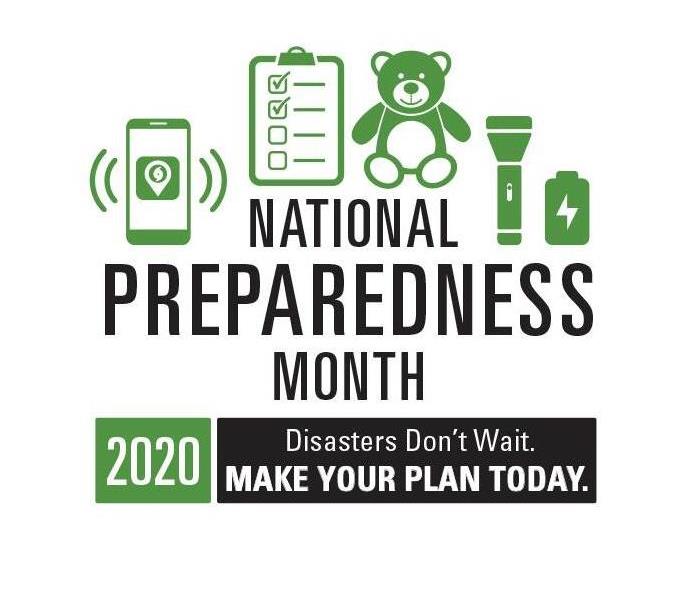 Disasters Don't Wait. Make Your Plan Today.
Disasters Don't Wait. Make Your Plan Today.
September is National Preparedness Month. NPM is recognized each September to promote family and community disaster planning now and throughout the year. As our nation continues to respond to COVID-19, there is no better time to be involved this month.
The first week of September is all about making a plan. Be sure to talk to your friends and family about how you will communicate before, during and after a disaster. Make sure to update your plan based on the CDC recommendations due to the coronavirus.
The second week of September is focused on building a kit. Gather supplies that will last several days after a disaster for everyone living in your home. Don’t forget to consider the unique needs of each person or pet may have in case you have to evacuate quickly.
The third week of September focuses in on preparing for disasters. After Hurricane Laura, our area recognizes how important it is to prepare for a disaster. It is important to know the risk of disasters in our area and check over your insurance coverage. Learn how to make your home stronger in the face of storms and other common hazards and act fast if you receive a local warning or alert.
The last week of September is all about education. Talk to your kids about preparing for emergencies and what to do in case you are separated. Reassure them by providing information about how they can get involved.
Disasters Don’t Wait. Make Your Plan Today.
Smoke Alarms
9/5/2020 (Permalink)
Smoke alarms save lives. Smoke alarms that are properly installed and maintained play a vital role in reducing fire deaths and injuries.
Here’s what you need to know!
- A closed door may slow the spread of smoke, heat and fire. Install smoke alarms in every sleeping room and outside each separate sleeping area. Install alarms on every level of the home.
- Smoke alarms should be interconnected. When one sounds, they all sound.
- Larger homes may need extra smoke alarms.
- Be sure to test your smoke alarms at least once a month. Press the test button to be sure that the alarm is working.
- Today’s smoke alarms are more technologically advanced to respond to a multitude of fire conditions yet mitigate false alarms.
- When a smoke alarm sounds, get outside and stay outside.
- Replace all smoke alarms in your home every 10 years.
We are Cleaning Experts
7/31/2020 (Permalink)
SERVPRO is Here to Help during this time of need
During this unprecedented time caused by the global pandemic of coronavirus, this is a reminder to our customers that we are specialists in cleaning services, and we adhere to the highest cleaning and sanitation standards.
Specialized Training
We are prepared to clean and disinfect your home or business, according to protocols set forth by the Centers for Disease Control and Prevention. We have years of experience in dealing with biological contaminants, and we will go beyond the scope of work that regular janitorial staff perform on a daily basis.
The CDC encourages cleaning of high-touch surfaces such as counters, tabletops, doorknobs, light switches, bathroom fixtures, toilets, phones, keyboards, tablets and tables. Other spaces mentioned in the CDC’s guidance for commercial spaces include:
- Kitchen/Food Areas
- Bathrooms
- Schools/Classrooms
- Offices
- Retail Spaces
- Water Fountains
- Shelving/Racks
- Sales Counters
- Carpets and Rugs
- Stair Handrails
- Elevator Cars
- Playground Equipment
- Fitness Equipment
Specialized Products
The CDC recommends usage of a labeled hospital-grade disinfectant with claims against similar pathogens to the coronavirus. Multiple products in the SERVPRO product line carry the EPA-approved emerging pathogens claims. While there is currently no product tested against this particular strain of the coronavirus, we are following all guidelines as provided by the CDC and local authorities.
Call Today for a Proactive Cleaning
If your home or business needs deep cleaning services, call the experts today – SERVPRO of Beaumont, 409-212-1977
Hurricane Season in Southeast Texas
7/23/2020 (Permalink)
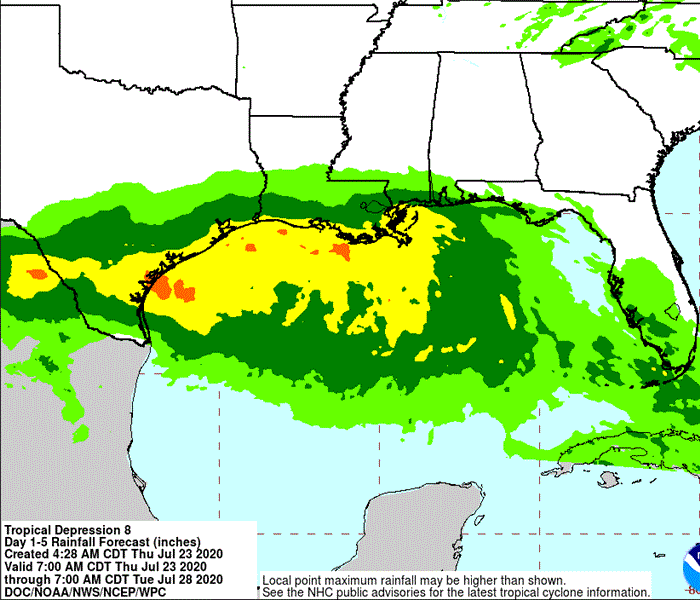 The NHC is predicting rainfall along the Texas coast.
The NHC is predicting rainfall along the Texas coast.
In our area, we are all constantly keeping our eye on the Gulf. We realize that at any time a tropical depression or storm system can quickly develop. This week we are keeping an eye on Tropical Depression Eight to see if it develops into a hurricane and what this can mean for Southeast Texas.
According to the National Hurricane Center, a tropical depression has wind speed less than 39 MPH. The NHC has issued some key messages regarding this depression. It is expected to strengthen and could bring tropical-storm-force winds to portions of the Texas coast. It is also expected to produce heavy rains across portions of Louisiana and Southern Texas. These rains could result in flash flooding.
Remember in the event of flooding while driving, its always best to turn around and not drown.
Stay safe Southeast Texas!
Fire Escape Plan
6/26/2020 (Permalink)
A home fire is reported every 88 seconds. Once the smoke alarm sounds, a fire can spread quickly, leaving only a minute or two to escape. That’s why it is so important to have a home escape plan.
Start by drawing a map for your home and follow these guidelines from the National Fire Protection Association:
- Plan two way to escape from each room
- Make sure all doors and windows leading outside open easily
- Identify secondary route—a window onto an adjacent roof or a collapsible ladder from upper-story windows
- If you live in a multi-story building, plan to use the stairs—never the elevator
- Designate an outside meeting place that is a safe distance from the house where everyone should meet
IICRC Certified Firm
6/26/2020 (Permalink)
SERVPRO of Beaumont is an IICRC firm. The Institute of Inspection, Cleaning and Restoration Certification (IICRC) creates the standards for the restoration industry and provides training and certification to restoration companies. IICRC Certified Firms have the right to display the IICRC Certified Logo.
IICRC Certified Firms must:
- Present accurate information to consumers and conduct business with honesty and integrity.
- Require a technician on all jobs who has been formally trained and passed all required tests.
- Require a continuing education program to keep technicians up-to-date on the latest changes in the industry.
- Maintain liability insurance to protect all parties in the event of an accident.
- Maintain a written compliant policy and agree to Better Business Bureau or similar arbitration to resolve disputes, and accept the conclusions and recommendations of arbitration.
The IICRC Develops the Standards for the Restoration Industry
The IICRC has been the driving force in establishing the main industry standards and reference guides for professional carpet cleaning, water damage restoration and mold remediation. There IICRC standards take years to develop and require the coordination of experts in the field: manufacturers, industry organizations, insurance professionals, training schools, contractors and public health professionals.
Every five years, the standards are reviewed and updated. The water damage restoration field changes rapidly with advancements in technology and science, and therefore the standards must evolve to keep pace.
Certified: SERVPRO Cleaned
6/25/2020 (Permalink)
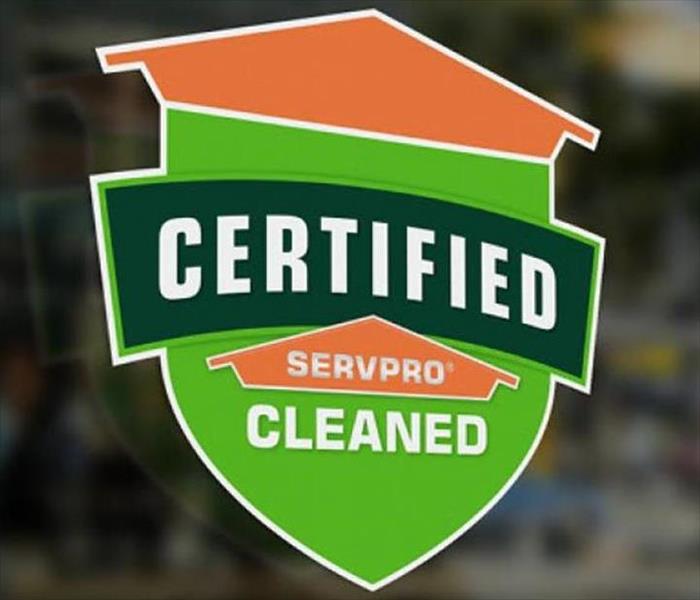 Certified: SERVPRO Cleaned--a defensive cleaning program
Certified: SERVPRO Cleaned--a defensive cleaning program
Being open for business is just the beginning of our new journey forward. Employees may be hesitant to return to work and customers may wonder whether the businesses they patronize are safe. The COVID-19 pandemic has changed what it means to be clean. Are you ready to communicate to your customers and employees that you’ve chosen a higher standard of clean for all Americans? Are you ready to be Certified: SERVPRO Cleaned?
Certified: SERVPRO Cleaned is a defensive cleaning program that SERVPRO offers to commercial locations to address the current COVID-19 global pandemic. This is a level of clean that goes far beyond janitorial or carpet cleaning. This is proactive viral pathogen cleaning. When you choose Certified: SERVPRO Cleaned, you, your employees, your customers and your community can rest assured that you’ve selected a higher cleaning standard—you are Certified: SERVPRO Cleaned.
As the #1 choice in cleanup and restoration*, we stand on over 50 years of experience and expertise to help your business become Certified: SERVPRO Cleaned. Beyond fire & water, SERVPRO professionals are trained and experienced in biohazard decontamination and chemical spills always adhering to the cleaning and decontamination standards set by the Centers for Disease Control and Prevention and local authorities.
From formulating and creating our proprietary cleaning products, like SERVPROXIDE™, at our headquarters in Gallatin, TN, to taking the utmost care while disinfecting, we will help ensure you and your business are set up to inspire customer confidence as the economy begins to reopen.
To schedule your Certified: SERVPRO Cleaned consultation—Contact the SERVPRO of Beaumont today (409) 212-1977!
* #1 Choice in cleanup & restoration based Commercial Attitude & Usage Tracking study. Polling 816 commercial business decision makers on first choice for future needs related to cleanup & restoration work. Study conducted by C&R Research: October 2019
Certified: SERVPRO Cleaned means professionally trained SERVPRO franchises perform the requested cleaning, sanitizing and disinfection services according to proprietary SERVPRO protocols and recognized industry and CDC standards with EPA approved cleaning products to deliver a SERVPRO certified cleaning experience. Each SERVPRO franchise is independently owned and operated.
Flood Safety Tips
6/23/2020 (Permalink)
Each year, more deaths occur due to flooding than any other hazard related to thunderstorms. The most common flood deaths occur when a vehicle is driven into hazardous floodwater.
Here are some steps you can take to prepare for a flood:
During a Flood Watch or Warning:
- Gather emergency supplies
- Listen to local radio or television station for updates
- Have immunization records handy (store immunization records in a waterproof container)
- Prepare an emergency food and water supply. Store at least 1 gallon of water per day for each person and each pet. It is important to store at least a 3-day supply.
- Bring in outdoor possessions (lawn furniture, grills, trash cans) or tie them down securely.
- If evacuation becomes necessary: turn off all utilities at the main power switch and close the main gas valve.
- Leave areas subject to flooding: low spots, canyons, washes, etc.
After Flooding Occurs:
- Avoid driving through flooded areas and standing water.
- Do not drink flood water or use it to wash dishes, brush teeth, or wash/prepare food.
- If you evacuated: return to your home only after local authorities to find out if your water is safe for drinking and bathing.
- When in doubt, throw it out! Throw away any food and bottled water that comes/may have come in contact with floodwater.
- Prevent carbon monoxide (CO) poisoning. Use generators at least 20 ft from any doors, windows, or vents.
Disaster Recovery Team
6/10/2020 (Permalink)
SERVPRO has answered the call to help in storm situations. We have developed a specialized storm and large response network to provide the resources needed in the event of a disaster. With an unmatched national footprint of over 1,500 franchises, SERVPRO’s Storm Response can provide trained crews faster to any disaster and can be on-site within a few hours to help reduce the future damage that water can cause. SERVPRO Disaster Recovery Team has the right equipment, procedures and training to help ensure the structure is dry the first time, saving you time and money. Ultimately, our goal is to restore first and replace only when necessary and helps limit the time your property is inconvenienced. Regardless of the size of the disaster, you want results for your business or your property.
Service Response Guidelines
6/9/2020 (Permalink)
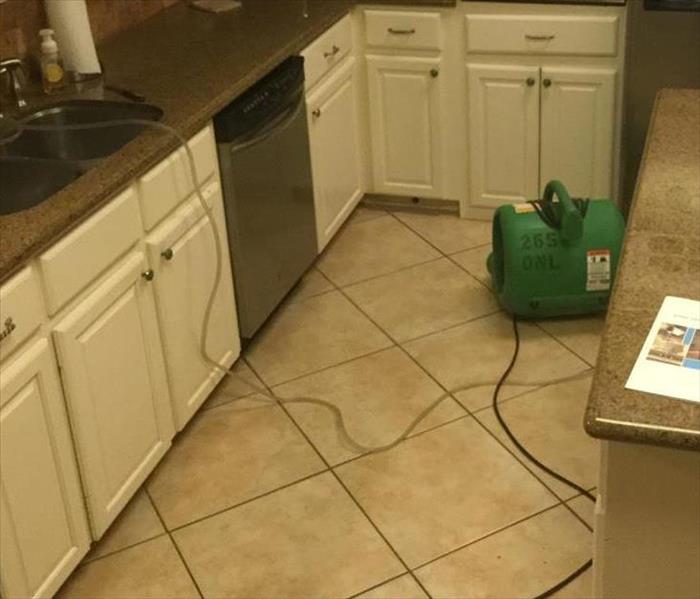 A refrigerator supply line busted causing water damage throughout the kitchen.
A refrigerator supply line busted causing water damage throughout the kitchen.
Did you know that SERVPRO has service response guidelines for water damage? We follow the guidelines 1-4-8. Our SERVPRO team realizes how important it is to be “Faster to Any Size Disaster.” Our team also emphasizes the importance of communication.
- Within ONE hour from notice of a loss, SERVPRO of Beaumont will contact you to arrange for services.
- Within FOUR hours of a loss notification, SERVPRO of Beaumont will be on-site to start mitigation services (if necessary).
- Within EIGHT hours, a verbal briefing of the scope will be communicated to you by our SERVPRO staff.
Do you have water damage in your home or business? Contact the SERVPRO of Beaumont today— (409) 212-1977!
**Exceptions may apply under certain conditions, such as a local catastrophic event or storm situation**
Water Damage from Contaminated Water
6/8/2020 (Permalink)
Contaminated water also described as “black water” and is grossly unsanitary. Black water can also be described as Category 3 water in water restoration terms. This category includes water sources from sewage, seawater, rising water from rivers or streams, ground surface water or standing water.
If you experience water damage from contaminated water, here are some Dos and Don’ts:
Do:
- Avoid all contact with sewage and items contaminated by sewage
- Wash your hands thoroughly after contact with contaminated items.
Don’t:
- Spread contaminated water by walking unnecessarily on damaged or wet areas.
- Turn on the HVAC system if there is a possibility of spreading contaminated air
- Use household fans to dry the structure and spread contaminates
- Use products for personal hygiene and cleanliness if exposed to the contaminated areas
Have more questions about contaminated water, contact the SERVPRO of Beaumont today!
Top Tips for Fire Safety
6/5/2020 (Permalink)
 Test your smoke alarms to make sure they are functioning properly.
Test your smoke alarms to make sure they are functioning properly.
Did you know that if a fire starts in your home you may have as little as two minutes to escape? During a fire, early warning from a working smoke alarm plus a fire escape plan that has been practiced regularly can save lives. Here are some more tips to keep your loved ones safe in the event of a fire:
Top Tips for Fire Safety
- Install smoke alarms on every level of your home, inside bedrooms and outside sleeping areas.
- Test smoke alarms every month. If they’re not working, be sure to change the batteries.
- Talk with your family about a fire escape plan and practice the plan twice a year.
- If a fire occurs in your home, remember GET OUT, STAY OUT and CALL FOR HELP. Never go back inside for anything or anyone.
Hurricane Watch vs. Warning
6/5/2020 (Permalink)
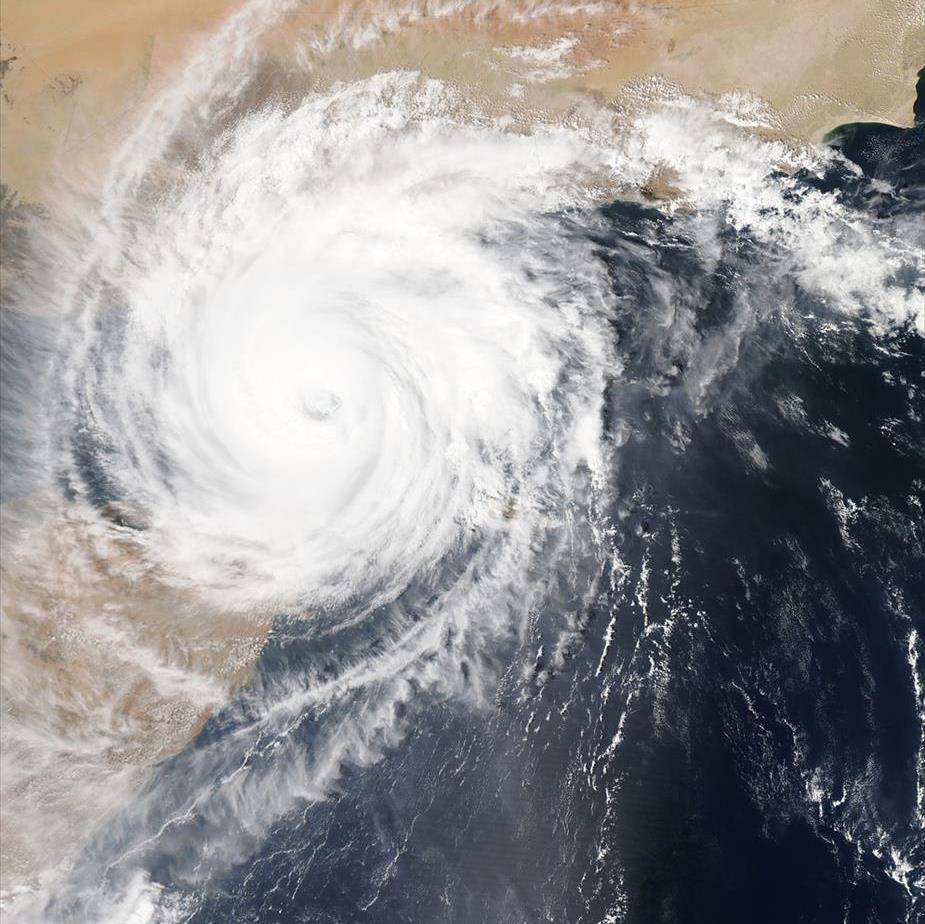 Hurricanes can cause devastating damage if you are not prepared.
Hurricanes can cause devastating damage if you are not prepared.
It is important to know the difference between a hurricane “watch” and “warning.” The National Weather Service has alerts on TV, radio, and online in the event of a hurricane.
- A hurricane watch means hurricane conditions (sustained winds of 74 mph or higher) are possible in a stated area. Experts announce hurricane watches 48 hours before they expect tropical-storm-force winds (sustained winds of 39 to 73 mph) to start.
- A hurricane warning is more serious. It means that hurricane forced winds are expected in a stated area. Experts issue these warnings 36 hours before tropical-storm-force winds are expected in the area to give people enough time to prepare for the storm.
For more information about hurricane watches and warnings. Check out the National Weather Service’s Hurricane Center.
Be Proactive
6/3/2020 (Permalink)
For a business owner, a worst-case disaster scenario involving fire or water damage can seem unthinkable until it suddenly becomes a reality. In the aftermath of a disaster, a quick response time by a disaster recovery company such as SERVPRO can help minimize property damage.
Owners need to have a quick and convenient emergency disaster plan that connects them with vendors, necessary contacts, and pertinent information when disaster strikes. The SERVPRO Emergency Ready Plan (ERP) is a respected industry tool during a disaster event. An ERP is so valuable, that in the midst of the confusion and panic that often surround a disaster, an owner or manager can be provided with a sense of calm and clarity in reaching out for an expert for help.
Contact the SERVPRO of Beaumont today to schedule your FREE Emergency Ready Plan—(409) 212-1977!
2020 Hurricane Season
6/2/2020 (Permalink)
The National Oceanic and Atmospheric Administration (NOAA) is expecting an above-normal 2020 Atlantic hurricane season. The outlook is predicting a 60% change of an above-normal season. The Atlantic hurricane season runs from June 1st through November 30th.
The NOAA states that the combination of several climate factors is driving the strong likelihood for an above-normal activity in the Atlantic this year. The El Nino Southern Oscillation (ENSO) conditions are expected to either remain neutral or to trend toward La Nina, which means there will not be an El Nino present to suppress hurricane activity. Also, warmer-than-average sea surface temperature in the tropical Atlantic Ocean and Caribbean Sea, coupled with reduced vertical wind shear, weaker tropical Atlantic trade winds and an enhanced west African monsoon all increase the likelihood for an above-normal hurricane season.
During the 2020 hurricane season, the NOAA and the U.S. Navy will deploy a fleet of autonomous diving hurricane gliders to observe conditions in the tropical Atlantic Ocean and Caribbean Sea in areas where hurricanes have historically traveled and intensified.
Source:
https://www.noaa.gov/media-release/busy-atlantic-hurricane-season-predicted-for-2020
Certified: SERVPRO Cleaned – a defensive cleaning program
5/28/2020 (Permalink)
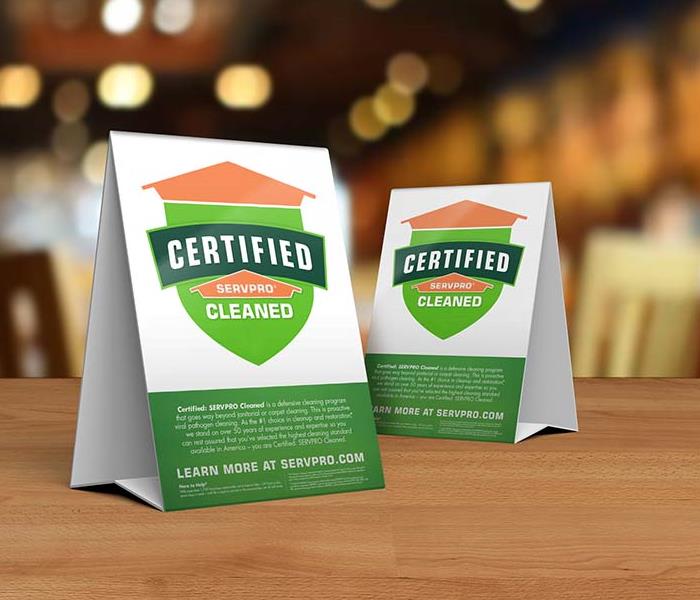 Our defensive cleaning program gives your business a way forward by providing your employees and customers ongoing safety and assuredness.
Our defensive cleaning program gives your business a way forward by providing your employees and customers ongoing safety and assuredness.
Let us help you get back to business
As our communities re-open, we’re all moving back toward a new kind of normal. The expectations of visitors, customers, and employees who come into our establishments have evolved, and staying safe and well is a top concern. The global COVID-19 pandemic has changed what it means to be clean, and we’ve developed a program to help your business meet the new higher standard of clean that is now expected.
Certified: SERVPRO Cleaned is a defensive cleaning program we’re offering to businesses and commercial locations to address the current COVID-19 pandemic. This proactive viral pathogen cleaning program goes well beyond janitorial or carpet cleaning. By choosing Certified: SERVPRO Cleaned, you, your employees, your customers, and your community can rest assured that you’ve selected a higher cleaning standard – you are Certified: SERVPRO Cleaned.
Extensive training and specialized products
As the #1 choice in cleanup and restoration*, we stand on more than 50 years of experience and expertise to help your business become Certified: SERVPRO Cleaned. Beyond fire & water, SERVPRO professionals are trained and experienced in biohazard decontamination and chemical spills – always adhering to the cleaning and decontamination standards set by the Centers for Disease Control and Prevention and local authorities.
From formulating and creating our proprietary cleaning products, like SERVPROXIDE, at our headquarters in Gallatin, TN, to taking the utmost care while disinfecting, we will ensure you and your business are set up to inspire consumer confidence as the economy continues to reopen.
3 C’s – Consult, Clean, and Certify
When the stakes are this high, you want a partner who has developed an industry leading, proprietary training program, cleaning solutions, and remediation processes over decades. We’ve cleaned up some of the most challenging biohazards imaginable. Certified: SERVPRO Cleaned reflects our unique experiences and capabilities. The program is grounded with our unique 3 C’s: Consult, Clean, and Certify.
- Consult – Every business is different, which is why you’ll be assigned a Cleaning Protocol Consultant who understands your business and will create a cleaning program to meet your specific needs. This program will be developed based on your business type, size of space, amount of high frequency touchpoints, foot traffic and congestion points.
- Clean – Based on your specific business needs, your location will undergo a thorough, deep clean, using exclusive cleaning products, according to protocols set forth by the CDC. Our employees have years of experience, and we will go beyond the scope of work that regular janitorial staff perform. Cleanup procedures generally include cleaning of porous and non-porous surfaces, disinfecting of non-porous surfaces, cleaning and disinfecting of equipment, tools, and/or supplies used for cleanup process, and disposal of hazardous materials. In the event of a suspected or confirmed COVID-19 event, we will be there cleaning within 24 hours to ensure you get back to business as quickly as possible.
- Certify - Once your business location has been Certified: SERVPRO Cleaned, you will gain access to proprietary signage, digital emblems, and other collateral that communicates that you’ve selected a higher standard of clean available to help protect your employees and customers. And because we add the day, month, and year to that proprietary stamp of clean, your guests will know that not only did you choose Certified: SERVPRO Cleaned, but that your location is being cleaned regularly at this standard.
Call today for a Certified: SERVPRO Cleaned consultation
We’re Here to Help – 24 hours a day, seven days a week – until life is back to normal in the communities we all call home.
Call SERVPRO of Beaumont today at 409-212-1977 for your Certified: SERVPRO Cleaned consultation.
* #1 Choice in cleanup & restoration based Commercial Attitude & Usage Tracking study. Polling 816 commercial business decision makers on first choice for future needs related to cleanup & restoration work. Study conducted by C&R Research: October 2019
Certified: SERVPRO Cleaned means professionally trained SERVPRO franchises perform the requested cleaning, sanitizing and disinfection services according to proprietary SERVPRO protocols and recognized industry and CDC standards with EPA approved cleaning products to deliver a SERVPRO certified cleaning experience. Each SERVPRO franchise is independently owned and operated.
When Water Damage Strikes
3/27/2020 (Permalink)
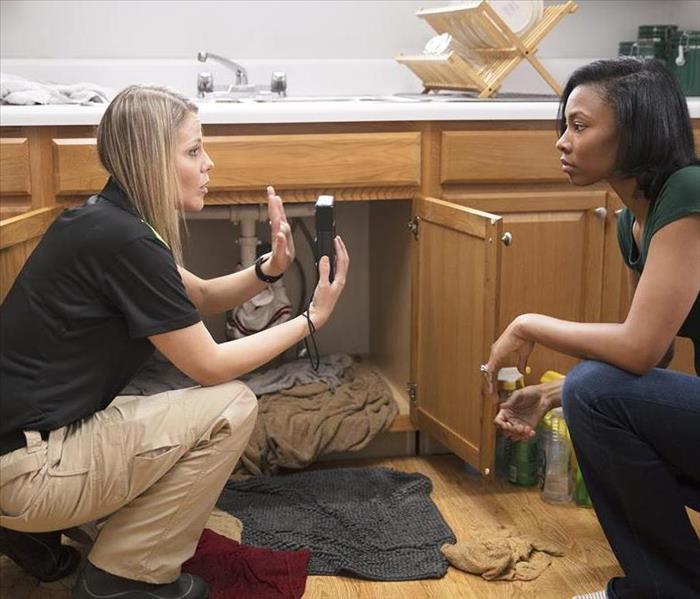 SERVPRO of Beaumont/Orange/Nederland/Lumberton can explain the steps needed to take in the event of a water loss.
SERVPRO of Beaumont/Orange/Nederland/Lumberton can explain the steps needed to take in the event of a water loss.
The first 24 hours following a water loss are the most important in preventing secondary or permanent damage. Within four hours of receiving a loss notification, SERVPRO of Beaumont/Orange/Nederland/Lumberton will be on site to help ensure a water damage is handled by completing the following steps.
Inspection
SERVPRO professionals will inspect affected areas to determine the extent of water damage and will review the inspection with you to answer any questions before beginning the work.
Emergency Services
Our SERVPRO professionals will take steps to help protect your home or business, as well as personal property and other contents, from further damage by extracting the excess water and preparing the area for drying. They will explain the needed emergency services to you step-by-step.
Monitoring
To help ensure your home or business and belongings are dried to appropriate industry standards, one of our SERVPRO professionals will monitor the drying process. The updates will be consistently communicated with you.
Restoration Services
The SERVPRO of Beaumont/Orange/Nederland/Lumberton can repair structural materials, reinstall carpets, and clean affected areas of your property and contents. A final walk-through of the jobsite will be conducted with you to help ensure the property was returned to its preloss condition.
Be Informed
3/17/2020 (Permalink)
It is important to learn the types of disasters or emergencies that may likely occur in our area. These events can range from affecting only you and your family, like a home fire or medical emergency, to those affecting your entire community like a hurricane or flood.
- Identify how local authorities will notify you during a disaster and how you will get information, whether through local radio, TV or NOAA Weather Radio stations or channels.
- Know the difference between weather alerts such as watches and warnings and what actions to take in each.
- Know what actions to take to protect yourself during disasters that may occur in areas where you travel or have moved recently. For example, if you travel to a place where earthquakes are common and you are not familiar with them, make sure you know what to do to protect yourself should one occur.
- When a major disaster occurs, your community can change in an instant. Loved ones may be hurt and emergency response is likely to be delayed. Make sure that at least one member of your household is trained in first aid and CPR and knows how to use an automated external defibrillator (AED).
Faster to Any Size Disaster
3/13/2020 (Permalink)
Flooding and water emergencies don’t have to wait for regular business hours and neither do we. SERVPRO of Beaumont/Orange/Nederland/Lumberton provides emergency cleaning and restoration services 24 hours a day, 7 days a week—including all holidays.
Faster to Any Size Disaster
Flooding and water damage is very invasive. Water quickly spreads throughout your home and gets absorbed into floors, walls, furniture and more. SERVPRO of Orange/Nederland/Lumberton arrives quickly and starts the water extraction process almost immediately. This immediate response helps to minimize the damage and the cleaning and restoration costs.
Need Emergency Service? Call us 24/7—(409) 212-1977
Water Damage Timeline
Within Minutes:
- Water quickly spreads throughout your property, saturating everything in its path.
- Water is absorbed into walls, floors, upholstery and belongings.
- Furniture finishes may bleed, causing permanent staining on carpets.
- Photographs, books, and other paper goods start to swell and warp.
Hours 1-24:
- Drywall begins to swell and break down.
- Metal surfaces begin to tarnish.
- Furniture begins to swell and crack.
- Dyes and inks from cloth and paper goods spread and stain.
- A musty odor appears.
48 Hours to 1 Week:
- Mold and mildew may grow and spread.
- Doors, windows, and studs swell and warp.
- Metal begins to rust and corrode.
- Furniture warps and shows signs of mold.
- Paint begins to blister.
- Wood flooring swells and warps.
- Serious biohazard contamination is possible.
More than 1 Week:
- Restoration time and cost increases dramatically; replacing contaminated materials and structure rebuilding may be extensive.
- Structural safety, mold growth, and biohazard contaminants pose serious risks to occupants.
Top Tips for Fire Safety
3/13/2020 (Permalink)
Did you know that if a fire starts in your home that you may have as little as two minutes to escape? During a fire, early warning and detection from a working smoke alarm plus a fire escape plan can save lives.
- Install smoke alarms on every level of your home, inside bedrooms and outside sleeping areas.
- Test smoke alarms every month. If they're not working, be sure to change out the batteries.
- Talk with family members about a fire escape plan and practice the plan twice a year.
- If a fire does occur in your home, make sure to GET OUT, STAY OUT and CALL FOR HELP. Never go back inside for anything or anyone.
If you need help after a home fire, your local Red Cross can assist.
Improving Air Quality
3/9/2020 (Permalink)
The ventilation system is often the biggest culprit in poor indoor air quality, but you can help change that! Inspecting the ductwork in your home or business should be a high priority. In most cases the HVAC system has been operating for some time without much attention. Dirty ducts can circulate odors, contaminants such as mold, and irritating dust throughout your home or business. Keeping the HVAC and ductwork clean can potentially extend the lifespan of the equipment by allowing it to operate at peak condition, which may help save you money. Duct cleaning may not always be necessary. SERVPRO of Beaumont/Orange/Nederland/Lumberton will inspect the ductwork and make recommendations about the best way to address any indoor air quality concerns. This inspection can help save you money and provide peace of mind on the health of your ductwork.
Have questions about air duct cleaning? Contact the SERVPRO of Beaumont/Orange/Nederland/Lumberton today!
SERVPRO's Duct Cleaning System:
3/9/2020 (Permalink)
- The air duct cleaning process begins by using patented equipment, including a roto-scraper, which automatically adapts to the duct’s shape and diameter while traveling through the duct, removing debris and filth before vacuuming begins.
- Next, a powerful push-pull air delivery and collection system transfers the debris from the ducting to a 16-gallon container.
- Air is then filtered through a HEPA filtration system, removing 99.97% of the particles in the airstream. HEPA filters capture debris and keep the indoor environment clean.
- An optional process, a sealant or coating product may be sprayed to address odor or microbial concerns.
- Filters will either be cleaned or replaced to remove odor and dirt.
For more information on duct cleaning, contact the SERVPRO of Beaumont/Orange/Nederland/Lumberton today!
Keeping Your Home Safe From Fire
3/2/2020 (Permalink)
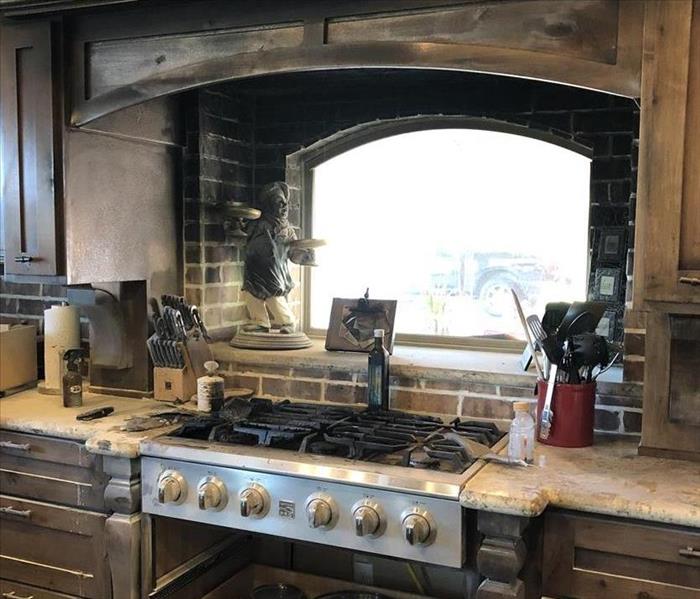 Damaged kitchen due to cooking fire.
Damaged kitchen due to cooking fire.
Cooking is the number one cause of home fires. Here are some steps you can take to prevent a cooking fire. Each year from 2014-2016, fire departments in the United States responded to an estimated average of 188,800 cooking fires in residential buildings.
- Remember to stay in the kitchen when you are frying, grilling or boiling food.
- If you do have to step away from the kitchen, turn off the burner.
- Keep things that can burn away from your cooking area.
- Turn pot handles toward the back of the stove so they won’t get bumped.
If disaster does strike in your home, contact the SERVPRO of Beaumont/Orange/Nederland/Lumberton today (409) 212-1977.
For more information about preventing cooking fires and other fire hazards in your home. Check out www.usfa.fema.gov
Emergency Water Damage Tips
2/20/2020 (Permalink)
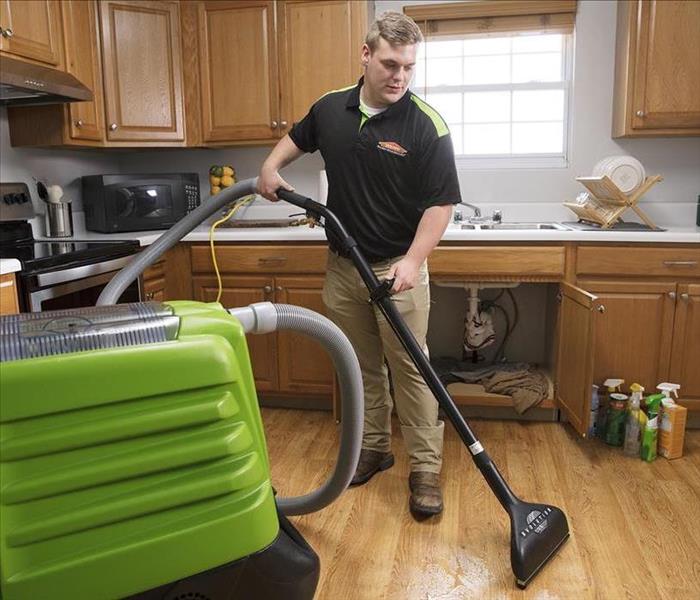 Emergency water extraction from damaged kitchen.
Emergency water extraction from damaged kitchen.
- Shut off the water source, if possible or contact a qualified professional to stop the water source.
- Turn-off circuit breakers for wet areas of the building when access to the power distribution panel is safe from electrical shock.
- Remove as much excess water as possible by mopping and blotting
- Place aluminum foil or word blocks between furniture legs and wet carpeting
- Move any paintings, art objects, computers, documents and other sensitive valuables to a dry place.
- Do not enter affected areas if electrical outlets, switches, circuit breakers, or electrical equipment are exposed to water. Always avoid electrical shock hazards.
- Do not use your household vacuum to remove water! This could cause electrical shock and cause damage to the vacuum.
- Do not turn on ceiling fixtures if the ceiling is wet or enter the room where ceilings are sagging from retained water.
Have questions regarding water damage? Contact the SERVPRO of Beaumont/Orange/Nederland/Lumberton today!
Fire Extinguisher Use
2/14/2020 (Permalink)
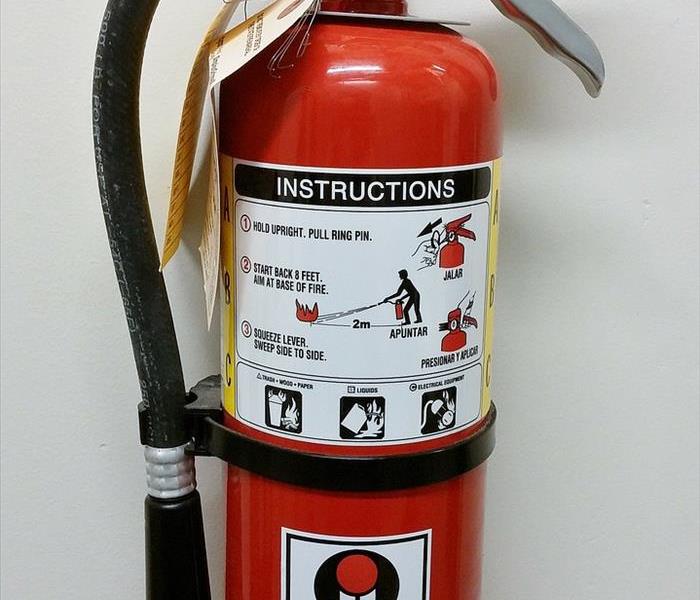 Fire extinguisher showing instructions on proper use.
Fire extinguisher showing instructions on proper use.
It is important to know the locations and the type of fire extinguishers that you have in your workplace prior to using one. Make sure that you read the operating instructions and warnings found on the fire extinguisher label. Not all fire extinguishers look alike!
When it is time to use an extinguisher on a fire, just remember PASS!
Pull the pin.
Aim the nozzle or hose at the base of the fire from the recommended safe distance.
Squeeze the operating lever to discharge the fire extinguishing agent.
Sweep the nozzle or hose from side to side until the fire is out. Move forward or around the fire area as the fire diminishes. Watch the area for re-ignition.
Have extinguisher dust covering your business? SERVPRO of Beaumont/Orange/Nederland/Lumberton can help! Contact us today
Winter Heating Hazards
12/19/2019 (Permalink)
The winter season is here and with it comes shorter days and lower temperatures. No matter where you live, winter brings a change in the weather. In effort to keep our homes and workplaces cozy, many people use alternative hear sources like fireplaces, portable space heaters, and wood burning stoves. Did you know, heating equipment is a leading cause of home fire deaths? According to the National Fire Protection Association, heating equipment fires cause an estimated $1 billion in direct property damage annually. Keep the following safety tips in mind to help reduce your risk of heating-related fire.
- Keep anything flammable at least three feet away from heating equipment, like the furnace, fireplace, wood stove, or a portable space heater. Have a three foot “kid friendly zone” around open fires and space heaters.
- Make sure the fireplace has a sturdy screen to stop sparks from flying into the room. Ashes should be cool before putting them in a metal container. Keep the container a safe distance away from your home.
- Remember to turn portable heaters off when leaving the room or going to bed.
- Always use the right kind of fuel, specified by the manufacturer, for fuel burning space heaters.
- Have heating equipment and chimneys cleaned and inspected every year by a qualified professional.
- Have a qualified professional install stationary space heating equipment, water heaters or central heating equipment according to the local codes and manufacturer’s instructions.
- Test smoke alarms monthly.
50% of all residential heating-related fires are reported during the months of December, January, and February.
Mold Problems?
12/13/2019 (Permalink)
Microscopic mold spores naturally occur almost everywhere, both outdoors and indoors. This makes it impossible to remove all mold from a home or business. Therefore, mold remediation reduces the mold spore count back to its natural or baseline level. Some restoration businesses advertise “mold removal” and even guarantee to remove all mold, which is a fallacy. Consider the following mold facts:
- Mold is present almost everywhere, indoors and outdoors.
- Mold spores are microscopic and float along in the air and may enter your home through windows, doors, or AC/heating systems or even hitch a ride indoors on your clothing or a pet.
- Mold spores thrive on moisture. Mold spores can quickly grow into colonies when exposed to water. These colonies may produce allergens and irritants.
- Before mold remediation can begin, any sources of water or moisture must be addressed. Otherwise, the mold may return.
- Mold often produces a strong, musty odor and can lead you to possible mold problem areas.
- Even higher-than-normal indoor humidity can support mold growth. Keep indoor humidity below 45 percent.
Cleaning Up After A Biohazard
10/9/2019 (Permalink)
Did you know that exposure to biological and chemical contaminants can pose serious health consequences for building occupants, employees, customers and owners? Failure to properly handle and safely remove such substances can contribute to unhealthy and even dangerous environments. SERVPRO of Beaumont is trained to safely and effectively remove hazardous biological substances and prepare waste for proper disposal according to OSHA, EPA, and state and local health regulations. We are equipped with the necessary equipment and cleaning products. SERVPRO of Beaumont can help turn unsafe environments into clean, safe homes and businesses.
SERVPRO of Beaumont can help with:
- Bloodborne Pathogens
- Sewage Backups
- Black Water Intrusions
- Methamphetamine Labs
If you have questions about biohazard cleanup or remediation services? Contact the SERVPRO of Beaumont today at (409) 212-1977.
2019 First Responder Bowl
10/7/2019 (Permalink)
In a joint effort to honor the service and sacrifice of America’s First Responders, the annual college football game played at SMU’s Gerald J. Ford Stadium in Dallas, TX has been renamed the SERVPRO® First Responder Bowl. Kickoff for the SERVPRO® First Responder Bowl is set for December 30, 2019 at 11:30 a.m. CST and will be televised by ESPN.
First responders to be honored include police officers, firefighters, EMS workers, correctional officers, search and rescue, dispatchers, security guards, federal agents, border patrol agents, and military personnel who have specialized training and are the first to arrive and aid at the scene of an emergency.
As a thank you to First Responders, SERVPRO First Responder Bowl can provide thousands of free tickets for our first responders, through the generosity of our corporate partners to attend the bowl game with their families.
This year we are wanting to include the community in helping us say “thank you” to our community heroes by Sponsoring a Responder. Our goal is to distribute over 10,000 complimentary tickets to first responders and their families who sign up and are verified.
Tickets will go on sale in September. Anyone wanting more information on the bowl game or how to sponsor a responder can visit www.firstresponderbowl.com.
IICRC Firm
10/2/2019 (Permalink)
SERVPRO of Beaumont is an IICRC firm. The Institute of Inspection, Cleaning and Restoration Certification (IICRC) creates the standards for the restoration industry and provides training and certification to restoration companies. IICRC Certified Firms have the right to display the IICRC Certified Logo.
IICRC Certified Firms must:
- Present accurate information to consumers and conduct business with honesty and integrity.
- Require a technician on all jobs who has been formally trained and passed all required tests.
- Require a continuing education program to keep technicians up-to-date on the latest changes in the industry.
- Maintain liability insurance to protect all parties in the event of an accident.
- Maintain a written compliant policy and agree to Better Business Bureau or similar arbitration to resolve disputes, and accept the conclusions and recommendations of arbitration.
The IICRC Develops the Standards for the Restoration Industry
The IICRC has been the driving force in establishing the main industry standards and reference guides for professional carpet cleaning, water damage restoration and mold remediation. There IICRC standards take years to develop and require the coordination of experts in the field: manufacturers, industry organizations, insurance professionals, training schools, contractors and public health professionals.
Every five years, the standards are reviewed and updated. The water damage restoration field changes rapidly with advancements in technology and science, and therefore the standards must evolve to keep pace.
Prepare for a Flood
9/11/2019 (Permalink)
Things to know & do before a flood:
- Reduce the risk of damage from flooding by elevating critical utilities, such as electrical panels, switches, sockets, wiring, appliances and heating systems.
- In areas with repetitive flooding, considering elevating the entire structure.
- Make sure basements are waterproofed and your sump pump is working. Then, install a battery-operated backup in case of power failure.
- Installing a water alarm will also let you know if water is accumulating in your basement.
- Clear debris from gutters and downspouts.
- Anchor any fuel tanks.
- Move furniture, valuables and important documents to a safe place.
- Store copies of irreplaceable documents (such as birth certificates, passports, etc.) in a safe, dry place. Keep originals in a safe deposit box.
- Build an emergency supply kit. Food, bottled water, first aid supplies, medicines and a battery-operated radio should be ready to go when you are.
- Plan and practice a flood evacuation route. Ask someone out of state to be your “family contact” in an emergency, and make sure everyone knows the contact’s address and phone number.
- Make a pet plan. Many shelters do not allow pers. Make plans now on what to do with your pets if you are required to evacuate your residence.
Source: https://www.floodsmart.gov/flood/first-prepare-for-flooding
Smoke Alarms
9/6/2019 (Permalink)
Smoke alarms save lives. Smoke alarms that are properly installed and maintained can play a vital role in reducing fire deaths and injuries. If there is a fire in your home, just remember that smoke spreads fast and smoke alarms will give you the time to get out.
Here’s what you need to know:
- A closed door can slow the spread of smoke, heat and fire. Install smoke alarms in every sleeping room and outside each separate sleeping area. Be sure to install alarms on every level of the home.
- Smoke alarms should be interconnected. When one sounds, they all sound.
- Large homes may need extra smoke alarms.
- Test your smoke alarms at least once a month.
- Today’s smoke alarms are more technologically advanced to respond to a multitude of fire conditions, yet mitigate false alarms.
- When a smoke alarm sounds, get outside and stay outside.
- Replace all smoke alarms in your home every 10 years.
Source: https://www.nfpa.org/Public-Education/Staying-safe/Safety-equipment/Smoke-alarms
National Preparedness Month 2019
9/3/2019 (Permalink)
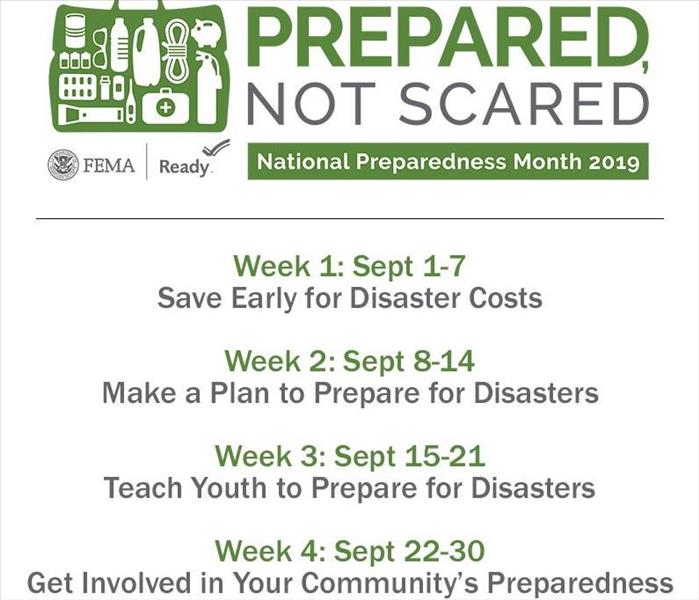 National Preparedness Month
National Preparedness Month
As a business owner, insurer, or property manager, you are a leader in your community and have the opportunity to set an example for your employees, customers and community to follow.
This year for National Preparedness Month (NPM), join your community in preparing for emergencies and disasters of all types, and lead efforts to encourage the community as a whole to become more prepared. “Disasters happen” and not only devastate individuals and neighborhoods, but entire communities, including businesses of all sizes.
The 2019 theme for National Preparedness Month is Prepared, Not Scared. Be Ready for Disasters. You can become prepared for a disaster by taking three simple steps:
- Have a plan to stay in business
- Encourage your employees to become ready
- Protect your investment
We must work together as a team to ensure that our families, businesses, places of worship, and neighborhoods are ready for any type of disaster that can potentially affect your local community. At Ready.gov/business, companies like yours can find vital information on how to begin preparing their organization and addressing their unique needs during an emergency situation.
The SERVPRO of Beaumont can help your business be ready for when disaster strikes with the SERVPRO Emergency READY Program.
Preparing for a Flood
7/26/2019 (Permalink)
Flooding can happen fast in many environments. The American Red Cross recommends having the following list of items packed and ready to go in the event of an evacuation due to flooding.
- Water—3+ day supply; one gallon per person per day
- Food—3+ day supply of non-perishable, easy to prepare food
- Flashlight
- Battery powered radio
- Extra batteries
- First Aid Kit
- Medications (7-day supply) and medical items
- Multi-purpose tool
- Sanitation/personal hygiene items
- Copies of personal documents
- Cell phones with chargers
- Family & Emergency contact information
- Extra Cash
- Emergency blanket
- Map(s) of the area
- Baby supplies (bottles, formula, baby food, diapers, etc.)
- Pet supplies
- Tools/supplies for securing your home
- Extra set of car keys & house keys
- Extra clothing, hat and sturdy shoes
- Rain gear
- Insect repellent and sunscreen
- Camera for photos of damage
Smoke Alarms & Fire Safety
6/26/2019 (Permalink)
In the event of a fire, a working smoke alarm increases your chances of surviving a fire. Here are some smoke alarm tips to help keep you and your family safe:
- Install a dual sensor smoke alarm. These contain both ionization and photoelectric smoke sensors. Ionization smoke alarms are more responsive to flaming fires while photoelectric smoke alarms are more responsive to fires that begin with a long smoldering period.
- Test batteries monthly.
- Replace the batteries in a battery-powered and hard-wired smoke alarms at least once a year.
- Install smoke alarms on every level of your home. Also, place them inside and outside sleeping areas.
- Replace the actual smoke alarm unit every 8-10 years or according to the manufacturer’s instructions.
- Never disable a smoke alarm while cooking.
Source:www.ready.gov/home-fires
Be Flood Smart
6/25/2019 (Permalink)
Floods are one of the most common and widespread natural disasters in the United States. Whether your home or business is near a coastline, along city streets, in the mountains, near a river or even in the desert-there is always the potential for flood damage. Floodsmart.gov reports, in the last five years, all 50 states have experienced floods or flash floods.
According to the American Red Cross (ARC), floods cause more damage in the U.S. every year that any other weather-related disaster. The ARC offers the following flood safety tips:
- Stay away from floodwaters. If you come up on a flowing stream where water is above your ankles, stop, turn around and go another way. Six inches of swiftly moving water can sweet you off of your feet.
- If you approach a flooded road while driving, turn around and go another way. If you are caught on a flooded road and waters are rising rapidly around you, get out of the car and quickly move to higher ground. Most cars can be swept away by less than two feet of moving water.
- Keep children out of the water. They are curious and often lack judgment about running water or contaminated water.
If a flood does strike your home or business, contact the SERVPRO of Beaumont/Orange/Nederland/Lumberton!
Even minor floods have the potential to cause major damage to a structure when not treated quickly and properly, and the cleanup is often an overwhelming task. The SERVPRO system is prepared to handle any size disaster.
Understanding Water Types
6/25/2019 (Permalink)
When your home or business suffers a water damage, understanding what type of water you are dealing with is critical to ensuring proper cleanup.
There are three types of water. Clean water is water from a broken pipe, or other water source; rainwater is also considered clean. The term gray water is used to classify slightly contaminated water. Clean water becomes gray water when it is left untreated allowing bacteria and other contaminant to begin growing, making the water hazardous. Black water is highly contaminated and filled with fungi, bacteria, chemicals and more. Black water is typically caused by sewage damage, flooding or any type of natural disaster. Black water should always be handled by trained professionals.
If you have water damage in your home, contact the SERVPRO of Beaumont/Orange/Nederland/Lumberton—(409) 212-1977!
Be Prepared with an ERP
6/25/2019 (Permalink)
The SERVPRO Emergency READY Profile (ERP) will help ensure that you are “Ready for whatever happens.” In the event of an emergency, the ERP can help minimize business interruption by having an immediate plan of action in place for your facility. The ERP is a comprehensive document containing critical information about your business, including emergency contacts, shut-off valve locations, utility services contact information, insurance information and also priority areas. The SERVPRO READY Profile can be easily accessed from your smartphone in a simple app. An ERP can be easily set up in fifteen minutes and can help minimize damage in a matter of seconds in the event of a disaster!
Call the SERVPRO of Beaumont/Orange/Nederland/Lumberton today to establish your FREE Emergency READY Profile!
Facts about Lightning
5/31/2019 (Permalink)
Lightning is one of the leading causes of weather-related fatalities. Though the odds of being struck by lightning in a given year are only around 1 in 500,000, some factors can put you at greater risk for being struck.
Here are a few lightning safety tips:
- Be aware. Check the forecast before participating in outdoor activities. If it calls for thunderstorms, postpone your trip or activity, or make sure adequate safe shelter is available.
- Go indoors. Remember the phrase, “When thunder roars, go indoors.” Find a safe enclosed shelter when you hear thunder. Safe shelters include homes, offices, shopping centers, and hard-top vehicles with the windows rolled up.
- Avoid windows, doors, porches and concrete. Do not lie on concrete floors and avoid leaning on concrete walls. Lighting can travel through any metal wires or bars in concrete walls or flooring.
- Avoid water. Do not bathe, shower, wash dishes, or have any other contact with water during a thunderstorm because lightning can travel through a building’s plumbing.
Water Damage
5/31/2019 (Permalink)
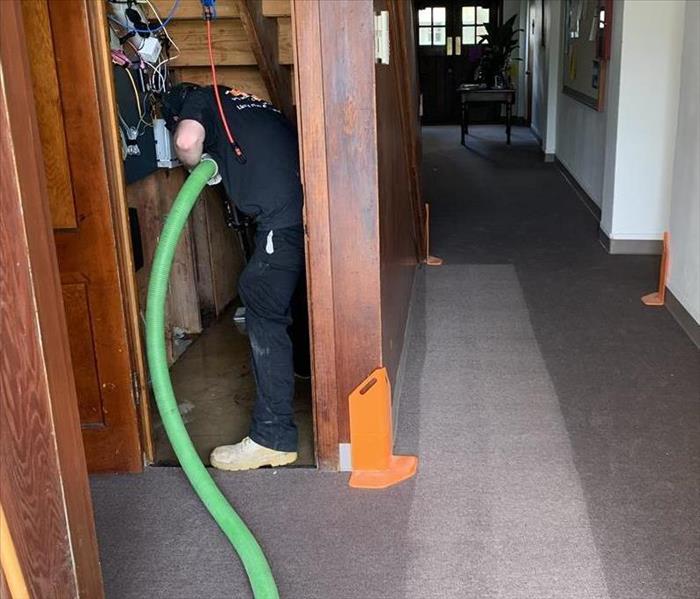 Emergency water extraction after a busted pipe.
Emergency water extraction after a busted pipe.
Water damage can happen at any time. The SERVPRO of Beaumont handles water damage every day and realizes that prompt action is key in the event of any disaster. Our SERVPRO technicians are trained in the proper techniques to inspect a home or business and assess the damage after a disaster. We use technology that is designed to determine the amount of moisture in an affected area, iPads to document the findings, and the proper placement of air movers and dehumidifiers to ensure proper drying. Our SERVPRO Professionals understand water damage and have the proper training and equipment to take care of all of your water damage needs 24/7, 365 days a year!
Have questions about water damage? Contact the SERVPRO of Beaumont today—(409) 212-1977!
2019 Hurricane Season
5/30/2019 (Permalink)
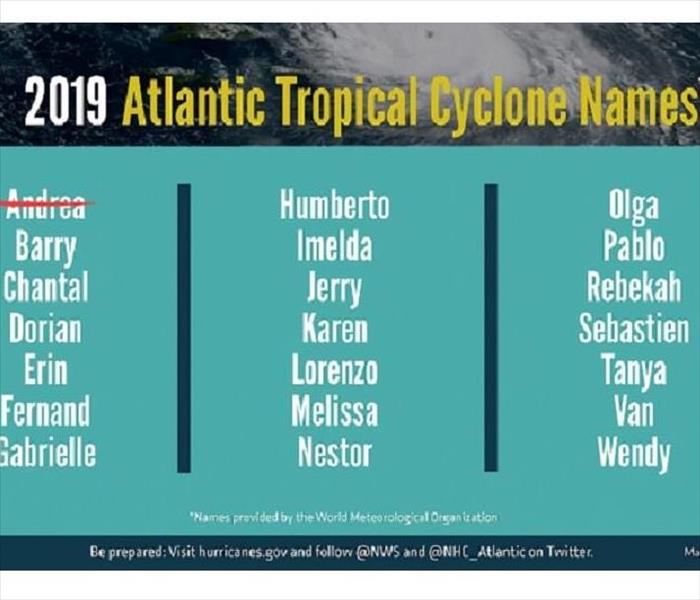 Did your name make this years' list?
Did your name make this years' list?
As many of you know the 2019 Hurricane Season starts this weekend on June 1st. The National Oceanic and Atmospheric Administration (NOAA) is predicting a near normal Atlantic hurricane season. They are predicting a likely range of 9-15 names storms and out of those storms 4-8 could become a hurricane. The NOAA is using cutting edge tools to help secure Americans against the threats that are posed by hurricanes and tropical storms. The NOAA factors in the current climate and the ongoing El Nino. The NOAA are doing all that they can to ensure that they are creating a more Weather-Ready Nation by providing the public with the information needed to take actions before, during and after a hurricane.
Source: www.noaa.gov
In the event of a hurricane the SERVPRO of Beaumont is here to help 24/7!
SERVPRO of Beaumont is Faster to ANY Disaster
5/30/2019 (Permalink)
Flooding and water emergencies don’t have to wait for regular business hours and neither do we. SERVPRO of Beaumont provides emergency cleaning and restoration services 24 hours a day, 7 days a week—including all holidays.
Faster to Any Size Disaster
Flooding and water damage is very invasive. Water quickly spreads throughout your home and gets absorbed into floors, walls, furniture and more. SERVPRO of Beaumont arrives quickly and starts the water extraction process almost immediately. This immediate response helps to minimize the damage and the cleaning and restoration costs.
Need Emergency Service? Call us 24/7—(409) 212-1977
Water Damage Timeline
Within Minutes:
- Water quickly spreads throughout your property, saturating everything in its path.
- Water is absorbed into walls, floors, upholstery and belongings.
- Furniture finishes may bleed, causing permanent staining on carpets.
- Photographs, books, and other paper goods start to swell and warp.
Hours 1-24:
- Drywall begins to swell and break down.
- Metal surfaces begin to tarnish.
- Furniture begins to swell and crack.
- Dyes and inks from cloth and paper goods spread and stain.
- A musty odor appears.
48 Hours to 1 Week:
- Mold and mildew may grow and spread.
- Doors, windows, and studs swell and warp.
- Metal begins to rust and corrode.
- Furniture warps and shows signs of mold.
- Paint begins to blister.
- Wood flooring swells and warps.
- Serious biohazard contamination is possible.
More than 1 Week:
- Restoration time and cost increases dramatically; replacing contaminated materials and structure rebuilding may be extensive.
- Structural safety, mold growth, and biohazard contaminants pose serious risks to occupants.
Commercial Document Restoration
5/22/2019 (Permalink)
Did you know that the SERVPRO of Beaumont can help restore documents after a water or fire loss at your place of business?
SERVPRO provides document restoration services. We can dry, clean, sterilize, deodorize, destroy and offer digitization services of all your important documents. The SERVPRO document restoration team members are trained and certified in HIPPA compliance. This certification protects the privacy and security of certain health information.
- Drying-Process in which an item containing moisture is frozen and dried using vacuums and pressures to achieve sublimation.
- Cleaning- Onsite cleaning. This is cleaning each document front and back to remove debris and any surface particulates.
- Sterilization- Gamma Irradiation is a process that is used for disinfecting and decontamination documents or other consumer goods.
- Deodorization- Once paper has been wet, an odor can begin to form. By letting SERVPRO deodorize your documents, the odor can be reduced and sometimes eliminated completely.
- Destruction- We offer certified destruction of documents.
- Digitization- Digitizing documents makes them easier to access as well as making storage of these files easier. We use state of the art equipment to turn paper copies into digital files.
Have questions about SERVPRO’s document restoration? Contact us today!—(409) 212-1977
Soot Webs
5/22/2019 (Permalink)
 This is a soot web caused by a kitchen fire.
This is a soot web caused by a kitchen fire.
Many times we walk into a customer’s home to assess the extent of the damage in their home after a fire loss. They begin to assure us that their home has “never been this dirty.” In most cases after a fire has occurred, customers notice “dirty cobwebs” throughout their home. However, they aren’t indicative of your cleaning skills. They are actually due to the fire!
These “dirty cobwebs” are called soot webs. Soot webs are formed when smoke from rubber or plastics may have ionized the soot particles that then bind together to form what looks like cobwebs.
If you do have soot webs in your home, do not try to clean them yourself! Any time you try to clean soot without the proper chemicals, tools and experience, you’ll likely cause further damage in your home.
If you have soot webs, call the SERVPRO of Beaumont at (409) 212-1977!
Improving Air Quality in Your Business
5/20/2019 (Permalink)
The ventilation system is often the biggest culprit in poor indoor air quality, but you can help change that! Inspecting the ductwork in your facility should be a high priority. In most cases, the HVAC system has been operating for some time without much attention. Dirty ducts can circulate odors, contaminants such as mold, and irritating dust throughout your building.
A routine part of SERVPRO of Beaumont’s service is inspecting the HVAC and ductwork. Keeping the HVAC and ductwork clean can potentially extend the life-span of the equipment by allowing it to operate at peak condition, which may help you save money. Duct cleaning may not always be necessary. SERVPRO of Beaumont will inspect your ductwork and make recommendations about the best way to address an indoor air quality concerns. This inspection can help you save money and provide peace of mind on the health of your HVAC system and ductwork.
For more information on commercial duct cleaning, contact SERVPRO of Beaumont today!
Proper Drying and Dehumidifcation
5/20/2019 (Permalink)
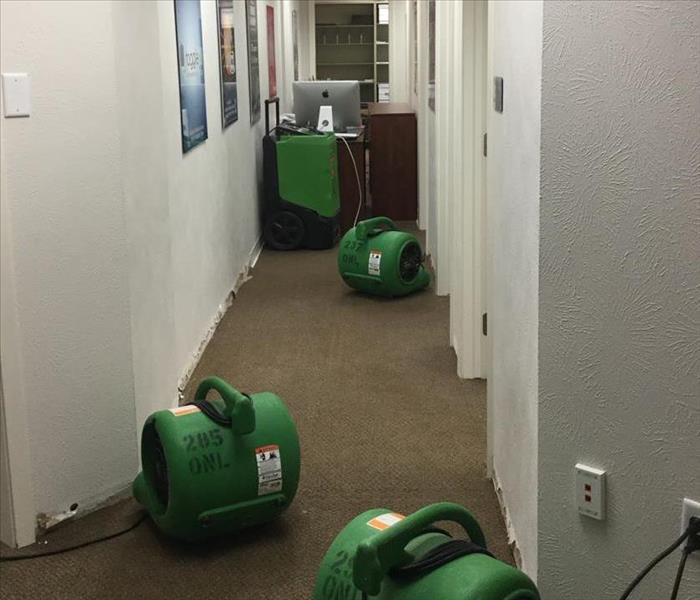 Drying after water damage in a commercial building.
Drying after water damage in a commercial building.
The first step to any water damage is removing the standing water. Even though your floors and walls may look dry at first glance; they are still wet to the touch. Most building materials, like drywall and wood, are porous and will retain significant water. The retained water will cause these materials to warp, swell, or break down and can also cause damage.
SERVPRO of Beaumont will manipulate the temperature and relative humidity to remove the remaining moisture. We use specialized equipment, including industrial air movers and dehumidifiers, to remove water retained by building materials and other hard-to-access moisture. Our SERVPRO professionals carefully monitor the progress using moisture meters until the materials return to acceptable drying goals.
Our SERVPRO of Beaumont professionals are trained and certified according to the Institute of Inspection Cleaning and Restoration Certification (IICRC) guidelines specifically in Water Restoration. SERVPRO also encorporates its own Employee Certification Trainings in Water Damage as well. Our SERVPRO team members are highly trained and ultimately Here to Help!
Water Damage Do's & Don'ts
3/27/2019 (Permalink)
Many of us do not know the first steps to take in the event of water damage in our homes. SERVPRO has over 40 years of leadership and training in cleanup and restoration services. SERVPRO has put together a few Do’s and Don’ts to help in the event of water damage in your home.
Water Damage from Clean Water
DO:
- Shut off the source of the water as quickly as possible.
- Turn off any circuit breakers for wet areas of the building when access to the breaker box is safe from electrical shock.
- Remove as much excess water as possible by mopping & blotting.
- Wipe excess water from wood furniture after removing lamps and tabletop items.
- Place aluminum foil or wood blocks between furniture legs and wet carpet.
- Remove any documents, computers and other materials that are valuable or sensitive to moisture.
DON’T:
- Enter rooms with standing water where electrical shock hazards are at risk.
- Enter affected areas if electrical outlets, switches or circuit breakers are exposed to water/
- Leave books, newspapers. Magazines or other colored items on wet carpets or floors to cause staining.
- Leave oriental rugs or other colored rugs on wet wall-to-wall carpets to cause staining.
- Use your household vacuum cleaner to remove excess water. This could cause electrical shock or damage the vacuum cleaner.
- Use TVs or other appliances while standing on wet carpets or floors.
- Turn on ceiling fixtures if the ceilings are wet or enter rooms where ceilings are sagging from retained water.
Mold in Southeast Texas
3/13/2019 (Permalink)
It’s estimated that more than 1 million types of mold exist, yet less than 10 percent have actually been named. This means mold is very common in both indoor and outdoor environments. While mold and humans can sometimes co-exist without issue, there are certain species of mold that can cause health effects for some people.
If the right conditions exist, mold will grow. Those conditions include:
- Water - Different mold types require varying amounts of liquid before growth begins.
- Temperature - Normal indoor temperatures will promote mold growth.
- Time - Initial mold colonizers can take hold within one day after being exposed to an adequate water supply.
Mold growth can occur in any home, so it’s important to keep an eye out for situations that might promote mold activity. Roof/chimney leaks, wet basements, or condensation from ducts that dampen surrounding insulation are just a few examples of issues that make a house a prime target for mold growth.
If you suspect mold in your home, call SERVPRO of Beaumont to assess the situation. We have the knowledge, tools and track record to effectively remediate mold in your home or business.
Disaster Recovery Team
3/13/2019 (Permalink)
Did you know that SERVPRO has a specialized storm team and large loss response network to provide the resources to your property when others can’t? In the event of a disaster, SERVPRO professionals have the resources to relocate crews with equipment to take care of all of our customer’s needs. SERVPRO strategically places mobilization teams across the country to travel when needed to support in recovery after large storm events such as hurricanes. Our job as water damage restoration professionals is to limit the amount of business interruption. We understand that fast mitigation is key to getting your business back up and running. SERVPRO provides the resources in the event of a large storm event to make sure that the right equipment, procedures and training are in place to ensure that the structure is dry the first time and saves you time and money.
Do you have questions about how SERVPRO of Beaumont can help you prepare for a disaster? Contact us today at (409) 212-1977!
Ready for Whatever Happens
3/8/2019 (Permalink)
The Best Way to Reduce Business Interruption Following a Disaster is to Plan for it NOW.
As many as 50% of businesses close down following a disaster, according to the latest research. Of the businesses that survive, the overwhelming majority of them had a preparedness plan in place. Pre-planning can serve as an insurance policy aimed at peace of mind. And knowing you are “Ready for whatever happens” speaks trust to your clients and employees that in the event your business is affected by a disaster, they don’t necessarily have to be.
By developing a SERVPRO® Emergency Ready Profile® for your business, you minimize business interruption by having an immediate plan of action. Knowing what to do and what to expect in advance is the key to timely mitigation and can help minimize how water and fire damage can affect your business.
The SERVPRO® Emergency Ready Profile® Advantage
- A no cost assessment of your facility.
-This means there is no need to allocate funds, giving you a great value at no cost.
- A concise Profile Document that contains only the critical information needed in the event of an emergency.
-It will only take a little time to complete and will not take you away from current projects. But will save a lot of time if ever needed.
- A guide to help you get back into your building following a disaster.
-This can help minimize the amount of time your business in active by having an immediate plan of action.
- Established your local SERVPRO® Franchise Professional as your disaster mitigation and restoration provider.
-You have a provider that is recognized as an industry leader and is close by.
- Identification of the line of command for authorizing work to begin.
-This saves time so we can begin the work of mitigating the damage which can save you time and money.
- Provides facility details such as shut-off valve locations, priority areas and priority contact information.
-Having a quick reference of what to do, how to do it and who to call provides solutions in advance of an emergency so that during the emergency you are “Ready for whatever happens.”
Jacey Woods is SERVPRO® of Beaumont's Ready Profile specialist. Call our office today to schedule your 15 minute appointment!
“Thanks to SERVPRO® our office only assumed partial water damage due to a busted pipe. Why? Because I was able to locate the shut-off valve straight from the Ready Plan app. My boss what out of reach and we didn’t panic. Thank you SERVPRO® for making us “Ready for whatever happens.” –Tracy T.
Understanding Smoke
3/8/2019 (Permalink)
The damage to your property following a fire can often be complicated due to the unique behavior of smoke. There are two different types of smoke-wet and dry. As a result, there are different types of soot residue after a fire. SERVPRO of Beaumont is thoroughly trained in fire cleanup and restoration and know the different types of smoke and their behavior patterns. Knowing this information is vital to proper restoration.
Before restoration begins, SERVPRO of Beaumont will survey the loss to determine the extent of impact from fire, smoke, heat, and moisture on the building materials and contents. The soot will then be tested to determine which type of smoke damage occurred. Pretesting determines the proper cleaning method and allows SERVPRO to focus on saving your precious items.
SERVPRO of Beaumont knows that smoke can penetrate various cavities within the structure, causing hidden damage and odor. Their knowledge of building systems helps them investigate how far smoke damage may have spread. The following are additional facts you may not know about smoke.
- Hot smoke migrates to cooler areas and upper levels of a structure.
- Smoke flows around plumbing systems, seeping through the holes used by pipes to go from floor to floor.
- The type of smoke may greatly affect the restoration process.
Different types of Smoke
- Wet Smoke (Plastic and Rubber) - Low heat, smoldering, pungent odor, sticky, smeary. Smoke webs are more difficult to clean
- Dry Smoke (Paper and Wood) – Fast burning, high temperatures, heat rises therefore smoke rises.
- Protein Fire Residue (Produced by evaporation of material rather than from a fire) – Virtually invisible, discolors paints and varnishes, extreme pungent odor.
- Fuel Oil Soot (Furnace Puff Backs) – While “puff backs” can create havoc for homeowners, SERVPRO can, in most cases, restore the contents and structure quickly.
- Other Types (Tear gas, fingerprint powder and fire extinguisher residue) – Special loss situations require special care.
SERVPRO of Beaumont is trained to handle even the toughest losses.
If your home or business suffers fire or smoke damage, contact the SERVPRO of Beaumont to help make it “Like it never even happened.”
Do you have dirty ducts?
3/8/2019 (Permalink)
Improve your indoor air quality with duct cleaning
Did you know your ventilation system is often the biggest culprit in poor indoor air quality? Inspecting the ductwork in your facility or home should be a high priority. In most cases, the HVAC system has been operating for some time without much attention. Dirty ducts can circulate odors, contaminants such as mold, and irritating dust throughout your building or home.
A routine part of your local SERVPRO Franchise Professional’s service is inspecting the heating, ventilation, and air conditioning unit (HVAC). Keeping the HVAC and ductwork clean can potentially extend the life-span of the equipment by allowing it to operate at peak condition, which may not always be necessary. SERVPRO Franchise Professionals will inspect your HVAC system and ductwork and make recommendations about the best way to address any indoor air quality concerns. This inspection can help save you money and provide peace of mind on the health of your HVAC system and ductwork.
In some circumstances, such as after a fire, smoke, or suspected mold growth, duct cleaning becomes an essential part of the cleanup process. In these cases your SERVPRO Franchise Professional can often restore the HVAC system and ductwork to pre-damage condition.
If you have a fuel-burning furnace, stove, or fireplace, the U.S. Environmental Protection Agency (EPA) recommends they be inspected for proper functioning and be serviced before each heating season to protect against carbon monoxide poisoning.
The SERVPRO duct cleaning system is proven and cost-efficient. Unlike the majority of duct cleaning services, your SERVPRO Franchise Professional uses a portable ventilation and air duct cleaning system to examine ductwork and make a clean sweep, removing years of dust and grime.
- The process begins by using patented equipment, including a roto-scraper, which automatically adapts to the duct’s shape and diameter while traveling through the duct, removing debris and filth before vacuuming begins.
- Next, a powerful push-pull air delivery and collection system transfers the debris from the ducting to a 16-gallon container.
- Air is filtered through a HEPA filtration system, removing 99.97 percent of the particles in the airstream. HEPA filters capture debris and keep the indoor environment clean.
- As an optional process, a sealant or coating product may be sprayed to address odor or microbial concerns.
- Filters will either be cleaned or replaced to remove odor and dirt.
For more information on duct cleaning, or to schedule an appointment, contact SERVPRO of Beaumont today at 409-212-1977.
Faster to Any Size Disaster
3/8/2019 (Permalink)
Flooding and water emergencies don’t have to wait for regular business hours and neither do we. SERVPRO of Beaumont provides emergency cleaning and restoration services 24 hours a day, 7 days a week—including all holidays.
Faster to Any Size Disaster
Flooding and water damage is very invasive. Water quickly spreads throughout your home and gets absorbed into floors, walls, furniture and more. SERVPRO of Beaumont arrives quickly and starts the water extraction process almost immediately. This immediate response helps to minimize the damage and the cleaning and restoration costs.
Need Emergency Service? Call us 24/7—(409) 212-1977
Water Damage Timeline
Within Minutes:
- Water quickly spreads throughout your property, saturating everything in its path.
- Water is absorbed into walls, floors, upholstery and belongings.
- Furniture finishes may bleed, causing permanent staining on carpets.
- Photographs, books, and other paper goods start to swell and warp.
Hours 1-24:
- Drywall begins to swell and break down.
- Metal surfaces begin to tarnish.
- Furniture begins to swell and crack.
- Dyes and inks from cloth and paper goods spread and stain.
- A musty odor appears.
48 Hours to 1 Week:
- Mold and mildew may grow and spread.
- Doors, windows, and studs swell and warp.
- Metal begins to rust and corrode.
- Furniture warps and shows signs of mold.
- Paint begins to blister.
- Wood flooring swells and warps.
- Serious biohazard contamination is possible.
More than 1 Week:
- Restoration time and cost increases dramatically; replacing contaminated materials and structure rebuilding may be extensive.
- Structural safety, mold growth, and biohazard contaminants pose serious risks to occupants.
Portable Fire Extinguishers
3/1/2019 (Permalink)
As a business owner, it is required to have portable fire extinguishers throughout your business. These are handy in the event of a small fire in your business. However, in the event a fire arises; do you know how to use one?
Portable fire extinguishers can be life and property saving tools when used correctly. In order to operate an extinguisher, the National Fire Protection Association (NFPA) suggests remembering the word PASS:
Pull the pin. Hold the nozzle pointing away from you and release the locking mechanism.
Aim low. Point the extinguisher at the base of the fire.
Squeeze the lever slowly and evenly.
Sweep the nozzle from side to side.
Be sure to read the instructions on the fire extinguisher and become familiar with them before a fire breaks out. Remember, extinguishers do have limitations. It is also important to ensure that you have the correct type of extinguisher for your facility.
To find more information on choosing the appropriate class of extinguisher, please visit the NFPA website at nfpa.org.
Different Types of Smoke Damage
3/1/2019 (Permalink)
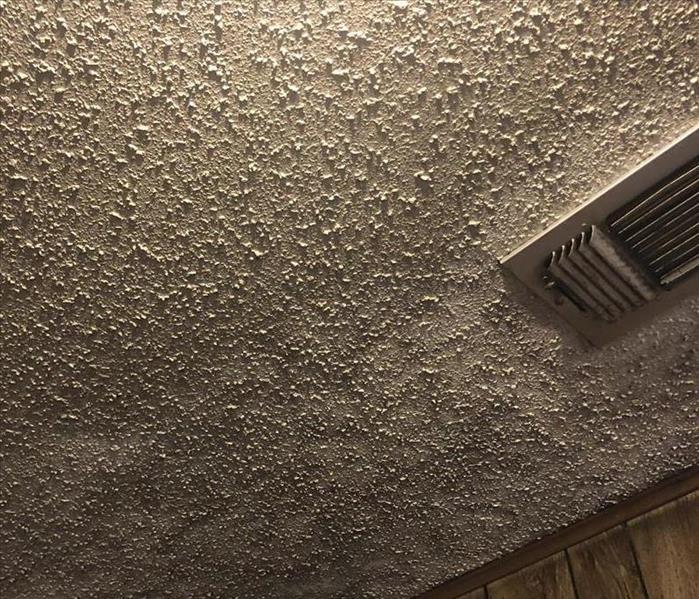 Smoke damage from a protein fire.
Smoke damage from a protein fire.
Did you know that there are different types of smoke? Each type of smoke can cause a wide array of damages to your home in the event of a fire. The damage resulting from a fire can be complicated due to the different types of smoke.
- Wet Smoke (Plastic and Rubber): Low heat, smoldering, pungent odor, sticky, smeary. Smoke webs are more difficult to clean.
- Dry Smoke (Paper and Wood): Fast-burning, high temperatures; heat rises, therefore smoke rises.
- Protein Fire Residue (Produced by the evaporation of material rather than from a fire): Virtually invisible, discolors paints and varnishes, extreme pungent odor.
- Fuel Oil Soot (Furnace Puff Backs): While “puff backs” can create havoc for homeowners, SERVPRO of Beaumont can, in most cases, restore the contents and structure quickly.
- Other Types (Tear gas, fingerprint powder, and fire extinguisher residue): Special loss situations require special care.
SERVPRO of Beaumont is trained and certified in Fire & Smoke Damage Restoration. Our knowledge helps restore your home back to preloss condition.
Tips to Minimize Water Damage
3/1/2019 (Permalink)
In the event that your home or business has a water loss, here are some steps to help minimize damage.
- Shut off the water source if possible or contact a qualified party to stop the water source.
- Turn off circuit breakers for wet areas of the building when access to the power distribution panel is safe from electrical shock.
- Remove as much excess water as possible by mopping and blotting.
- Place aluminum foil or wood blocks between furniture legs and wet carpet.
- Move any paintings, art objects, computers, documents, and other sensitive valuables to a dry place.
- Don’t enter affected areas if electrical outlets, switches, circuit breakers, or electrical equipment are exposed to water. Always avoid shock hazards.
- Don’t use your household vacuum cleaning to remove water; this could cause electrical shock or damage the vacuum cleaner.
- Don’t turn on ceiling fixtures if ceiling is wet or enter rooms where ceilings are sagging from retained water.
Facts about Fires
12/21/2018 (Permalink)
Fire: Just the Facts
-Between 2011 and 2015 fires caused: over 12,300 civilian injuries, 2,510 civilian deaths and $6.7 billion in property damage.
-Three out of five home fire deaths are caused by fires in homes with no smoke alarms or not working alarms.
-Working smoke alarms cut the risk of dying in reported home fires in half.
-In fires considered large enough to activate the smoke alarm, hardwired alarms operated 94 percent of the time, while battery powered alarms operated 80 percent of the time.
-When smoke alarms fail to operate, it is usually because batteries are missing, disconnected, or dead.
-One quarter of home fire deaths are caused by fires that start in the bedroom. Another quarter result from fires in the living room, family room or den.
-One-third of survey respondents who made an estimate thought they would have at least 6 minutes before a fire in their home would become life-threatening. The time available is often much less. Only 8 percent said their first thought on hearing a smoke alarm would be to get out.
Facts provided by National Fire Protection Association, nfpa.org
WHAT TO DO UNTIL HELP ARRIVES
DO:
- Limit movement in the home to prevent soot particles from being embedded into upholstery and carpet.
- Keep hands clean. Soot on hands can further soil upholstery, walls and woodwork.
- Place dry, colorfast towels or old linens on rugs, upholstery and carpet traffic areas
- If electricity is off, empty freezer/refrigerator completely and prop doors open to help prevent odor.
- Wipe soot from chrome kitchen/bathroom faucets, trim and appliances, then protect these surfaces with a light coating of lubricant.
- If heat is off during winter, pour RV antifreeze in sinks, toilet bowls, holding tanks and tubs to avoid freezing pipes and fixtures.
- Change HVAC filters; leave system off until a trained professional can check the system.
- Tape double layers of cheesecloth over air registers to stop particles of soot from getting in or out of the HVAC system.
DON’T:
- Don’t attempt to wash any walls or painted surfaces without first contacting your SERVPRO® Franchise Professional.
- Don’t attempt to shampoo carpet or upholstered furniture without first consulting your SERVPRO® Franchise Professional.
- Do not attempt to clean any electrical appliances (TV sets, radios, etc.) that may have been close to fire, heat, or water without first consulting an authorized repair service.
- Do not consume any food or beverages that may have been stored close to fire, heat or water, as they may be contaminated.
- If ceiling is wet, do not turn on ceiling fans. Wiring may be wet or damaged and cause electrical shock, and air movement may create secondary damage.
- Don’t send garments to the dry cleaner. Improper cleaning may set in smoke odor.
Air Duct Cleaning
12/17/2018 (Permalink)
 Technicians cleaning commercial air ducts.
Technicians cleaning commercial air ducts.
Did you know that the SERVPRO of Beaumont can clean residential and commercial air ducts? Having your air ducts cleaned can sweep away years of dust and dirt and can help reduce the potential for damage and health risks.
Your ventilation system is most often the biggest culprit in poor indoor air quality. In most cases, the HVAC system has been operating for some time without much attention. Dirty air ducts can circulate odors and contaminants such as mold and irritating dust throughout your building or home.
Keeping your ductwork clean can potentially extend the life span of the equipment by allowing it to operate at peak condition. In some circumstances, such as after fire, smoke or suspected mold growth, duct cleaning may be an essential part of the cleanup process.
SERVPRO of Beaumont is a member of NADCA. NADCA is the National Air Duct Cleaners Association. We are also Air Systems Cleaning Specialist (ASCS) certified as well.
If you have questions in regards to air duct cleaning or would like to schedule services, call (409) 212-1977 today!
Does your home have a mold problem?
12/12/2018 (Permalink)
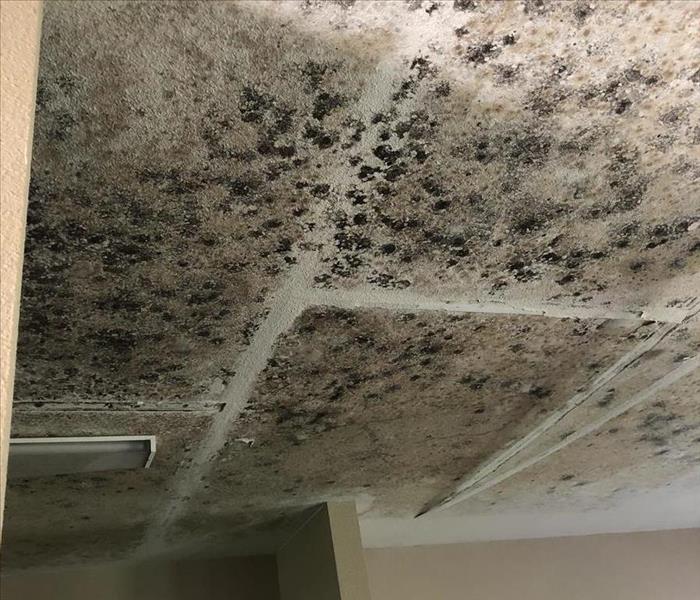 Mold problem in home due to water damage.
Mold problem in home due to water damage.
Microscopic mold spores naturally occur almost everywhere, both outdoors and indoors. This makes it impossible to remove all mold from a home or business. Therefore, mold remediation reduces the mold spore count back to its natural or baseline level. Some restoration businesses advertise “mold removal” and even guarantee to remove all mold, which is a fallacy. Consider the following mold facts:
- Mold is present almost everywhere, indoors and outdoors.
- Mold spores are microscopic and float along in the air and may enter your home through windows, doors, or AC/heating systems or even hitch a ride indoors on your clothing or a pet.
- Mold spores thrive on moisture. Mold spores can quickly grow into colonies when exposed to water. These colonies may produce allergens and irritants.
- Before mold remediation can begin, any sources of water or moisture must be addressed. Otherwise, the mold may return.
- Mold often produces a strong, musty odor and can lead you to possible mold problem areas.
- Even higher-than-normal indoor humidity can support mold growth. Keep indoor humidity below 45 percent.
If You See Signs of Mold, Call Us Today – (409) 212-1977
Biohazard Cleanup
10/9/2018 (Permalink)
Exposure to biological and chemical contaminants can pose serious health consequences for building occupants, employees, customers and owners. Failure to properly handle and safely remove such substances can contribute to unhealthy and even dangerous environments. The SERVPRO of Beaumont is trained to safely and effectively remove hazardous biological substances and prepare waster for proper disposal according to OSHA, EPA, and state and local health regulations. We are equipped with the necessary equipment and cleaning products. SERVPRO of Beaumont can help turn unsafe environments into clean, safe homes and businesses.
SERVPRO of Beaumont can help with:
- Bloodborne Pathogens
- Sewage Backups
- Black Water Intrusions
- Methamphetamine Labs
Have questions about biohazard cleanup and remediation services? Contact the SERVPRO of Beaumont today at (409) 212-1977 or visit our website for more information www.SERVPRObeaumont.com
SERVPRO First Responder Bowl
10/6/2018 (Permalink)
In a joint effort to honor the service and sacrifice of America’s First Responders, the annual college football game played at Cotton Bowl Stadium in Dallas, TX has been renamed the SERVPRO® First Responder Bowl. Kickoff for the SERVPRO® First Responder Bowl is set for December 26, 2018 at 12:30 p.m. CST and will be televised by ESPN.
The 2018 SERVPRO® First Responder Bowl is the ninth edition of the bowl game, formerly known as the Heart of Dallas Bowl, and part of the 89-year history of games being played at Cotton Bowl Stadium. The Cotton Bowl Stadium is on the grounds of Dallas’ Fair Park, which features 227 acres of museums, attractions, history, art and performances located in the heart of the ninth largest city in the United States.
First responders to be honored include police officers, firefighters, EMS workers, correctional officers, search and rescue, dispatchers, security guards, federal agents, border patrol agents, and military personnel who have specialized training and are the first to arrive and provide assistance at the scene of an emergency.
Tickets will go on sale in September. Anyone wanting more information on the bowl game can visit www.firstresponderbowl.com.
IICRC Certified Firm
9/24/2018 (Permalink)
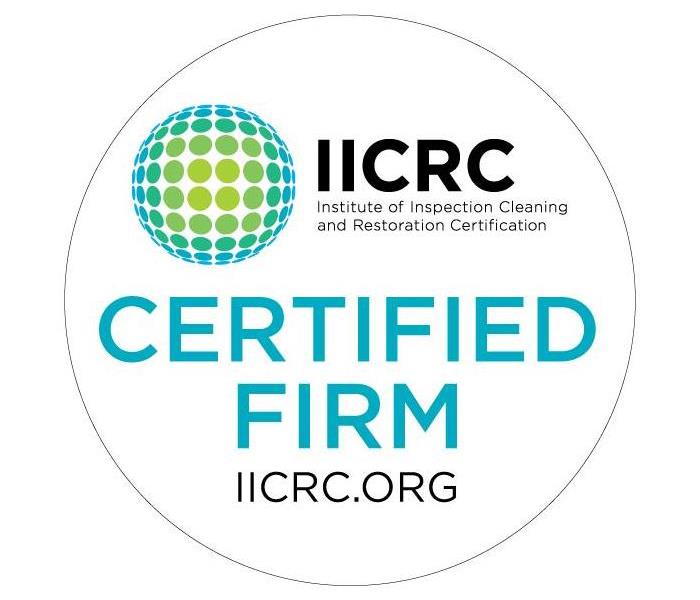 We are an IICRC Certified Firm
We are an IICRC Certified Firm
SERVPRO of Beaumont is an IICRC firm. The Institute of Inspection, Cleaning and Restoration Certification (IICRC) creates the standards for the restoration industry and provides training and certification to restoration companies. IICRC Certified Firms have the right to display the IICRC Certified Logo.
IICRC Certified Firms must:
- Present accurate information to consumers and conduct business with honesty and integrity.
- Require a technician on all jobs who has been formally trained and passed all required tests.
- Require a continuing education program to keep technicians up-to-date on the latest changes in the industry.
- Maintain liability insurance to protect all parties in the event of an accident.
- Maintain a written compliant policy and agree to Better Business Bureau or similar arbitration to resolve disputes, and accept the conclusions and recommendations of arbitration.
The IICRC Develops the Standards for the Restoration Industry
The IICRC has been the driving force in establishing the main industry standards and reference guides for professional carpet cleaning, water damage restoration and mold remediation. There IICRC standards take years to develop and require the coordination of experts in the field: manufacturers, industry organizations, insurance professionals, training schools, contractors and public health professionals.
Every five years, the standards are reviewed and updated. The water damage restoration field changes rapidly with advancements in technology and science, and therefore the standards must evolve to keep pace.
Preparing for a Flood
9/10/2018 (Permalink)
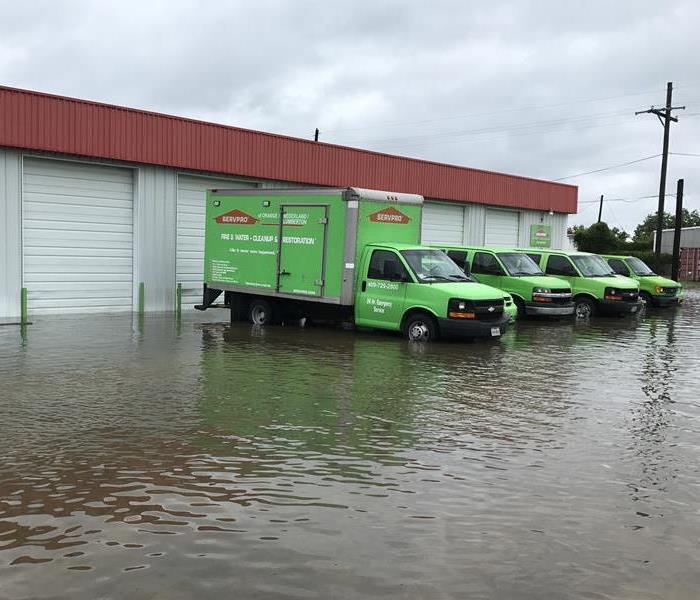 Flooding at our office after Hurricane Harvey.
Flooding at our office after Hurricane Harvey.
- Know the types of flood risk in your area. Visit FEMA’s Flood Map Service Center for more information
- Sign up for your community’s warning system. The Emergency Alert System (EAS) and National Oceanic and Atmospheric Administration (NOAA) Weather Radio also provide emergency alerts.
- If flash flooding is a risk in your location, then monitor potential signs, such as heavy rains.
- Learn and Practice evacuation routes, shelter plans, and flash flood response.
- Gather supplies in case you have to leave immediately, or if services are cut off. Keep in mind each person’s specific needs, including medication. Don’t forget the needs of your pets as well. Obtain extra batteries and charging devices for phones and other critical equipment.
- Purchase or renew a flood insurance policy. It typically takes up to 30 days for a policy to go into effect and can protect the life you’ve built. Homeowner’s policies do not cover flooding.
- Keep important documents in a waterproof container. Create password-protected digital copies.
- Protect your property. Move valuables to higher levels. Declutter drains and gutters. Install check valves. Consider a sump pump with a battery.
For more information on how to stay safe when a flood threatens, visit www.ready.gov/floods.
Smoke Alarms: Life Savers
9/7/2018 (Permalink)
Smoke alarms save lives when properly installed and maintained, according to the National fire Protection Association (NFPA). In homes, smoke alarms should be in every bedroom and on every level including the basement. In office and commercial environments, check your state requirements or contact your local Fire Marshall to help ensure all codes are met.
Test smoke alarms monthly using the test button. Smoke alarms with non-replaceable batteries need the entire smoke alarm unit replaced every ten years. Other alarms need batteries replaced every year, and the unit replaced every ten years. If the alarm chirps signaling low battery, take the proper steps to replace the unit or the batteries immediately. Never disable or remove the battery from an alarm. Almost half of fires where smoke alarms were present but did not activate has missing or disconnected batteries (NFPA).
In larger commercial facilities, hard wired or wireless smoke alarms offer benefits such as not needing to be tested as often and activating throughout the entire building if smoke is detected in just one area (NFPA).
If you need help installing, testing or changing batteries in your smoke alarms, contact your local fire department, an electrician or the American Red Cross.
Be sure your home or workplace has a fire emergency plan in place and conduct regular fire drills. For more information on emergency preparedness, contact the SERVPRO of Beaumont today.
National Preparedness Month
9/5/2018 (Permalink)
National Preparedness Month 2018
As a business owner, insurer or property manager you are a leader in your community and have the opportunity to set an example for your employees, customers and community to follow.
This year for National Preparedness Month, join your community in preparing for emergencies and disasters of all types, and leading efforts to encourage the community as a whole to become more prepared. “Disasters happen” and not only devastate individuals and neighborhoods, but entire communities, including businesses of all sizes.
As an employer in your community, having a business continuity plan can help protect your company, its employees and its infrastructure, and maximizes your chances of recovery after an emergency or disaster. You can do this by taking three simple steps:
- Plan to stay in business
- Encourage your employees to become ready
- Protect your investment
We must work together as a team to ensure that our families, businesses, places of worship and neighborhoods are ready. At Ready.gov/business, companies can find vital information on how to begin preparing their organization and address their unique needs during an emergency. You can also contact the SERVPRO of Beaumont to find out more on how to be ready when disaster strikes with the Emergency READY program.
Hurricane Season Is Here
7/25/2018 (Permalink)
It may seem early, but hurricane season is currently underway. For the Atlantic, the season begins June 1st and runs through November 30th. The Eastern Pacific hurricane season began in mid-May and will continue through November 30th as well. Hurricanes can be life-threatening as well as cause serious property-threatening hazards such as flooding, storm surge, high winds, and tornadoes. While the primary threat is in the coastal areas, many inland areas can also be affected by these hazards, as well as by secondary events such as power outages as a result of the high winds and landslides due to rainfall.
Preparation is the best protection against the dangers of a hurricane. Plan an evacuation route and your emergency plan, take inventory of your property, and take steps to protect your home or business. For more information and preparation tips, visit the Ready campaign website at www.ready.gov/hurricanes.
Questions to Consider Before Mold Remediation
6/1/2018 (Permalink)
Mold can be found almost anywhere. It can grow virtually on any substance, providing that moisture is present. Listed below are questions to help determine if remediation services may be needed:
- Is there an existing moisture problem in the building?
- Have building materials been wet more than 48 hours?
- Is there a hidden source of water or is the humidity too high (high enough to cause condensation)?
- Are building occupants reporting musty or moldy odors?
- Are building occupants reporting health problems?
- Are building materials or furnishing visibly damaged?
- Has the building been recently remodeled or has building use changed?
If you have answered yes to majority of these questions, contact the SERVPRO of Beaumont today for a mold inspection (409) 212-1977.
Source: www.epa.gov
2018 Hurricane Season
5/25/2018 (Permalink)
The National Oceanic and Atmospheric Administration is predicting a near or above normal 2018 Atlantic hurricane season. They’re predicting anywhere from 10-16 named storms. In the range of 5-9 becoming hurricanes and out of those 1-4 becoming major hurricanes. The NOAA states that the possibility of a weak El Nino developing and near-average sea surface temperatures across the tropical Atlantic Ocean and Caribbean Sea are two of the factors that are driving this outlook.
With all of the sophisticated technology, next-generation models and satellite data; this helps decision makers and the general public the ability to take action before, during and after hurricanes. After the 2017 Hurricane season, specifically Hurricane Harvey, Southeast Texas can use this information to be better prepared for the upcoming 2018 season.
Source: www.noaa.gov
Determining the Category of Water Damage
5/25/2018 (Permalink)
IICRC S500 Standard Reference Guide for Professional Water Damage Restoration defines three categories of water. Category refers to the type of water affecting the structure.
A Category I loss is where water originates from a sanitary water source and does not pose substantial risk from dermal, ingestions or inhalation exposure. A Category II loss is when water contains a significant contamination and has the potential to cause discomfort or sickness if contacted or consumed by humans. Category II water can contain potentially unsafe levels of microorganisms or nutrients for microorganisms. Examples of Category II are: Discharge from dishwashers or washing machines, overflows from washing machines, overflows from toilet bowls on the room side of the trap with some urine. Category III water is grossly contaminated and can contain pathogenic, toxigenic or other harmful agents and can cause significant adverse reactions to humans if contacted or consumed. Examples of Category III water are: Sewage, Flood water, and other contaminated water entering or affecting the indoor environment, such as wind-driven rain from hurricanes, tropical storms or other weather-related events.
Have questions about water damage? Contact the SERVPRO of Beaumont today at (409) 212-1977.
Improving Air Quality
5/17/2018 (Permalink)
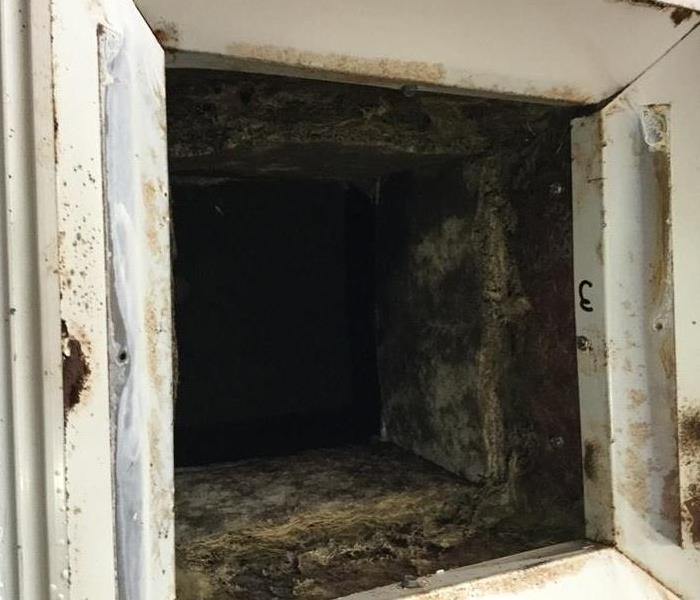 Inside dirty ductwork
Inside dirty ductwork
The ventilation system is often the biggest culprit in poor indoor air quality, but you can help change that! Inspecting the ductwork in your facility should be a high priority. In most cases, the HVAC system has been operating for some time without much attention. Dirty ducts can circulate odors, contaminants such as mold, and irritating dust throughout your building.
A routine part of SERVPRO of Beaumont’s service is inspecting the HVAC and ductwork. Keeping the HVAC and ductwork clean can potentially extend the life-span of the equipment by allowing it to operate at peak condition, which may help you save money. Duct cleaning may not always be necessary. SERVPRO will inspect your ductwork and make recommendations about the best way to address an indoor air quality concerns. This inspection can help you save money and provide peace of mind on the health of your HVAC system and ductwork.
For more information on commercial duct cleaning, contact SERVPRO of Beaumont today!
Drying and Dehumidification
5/17/2018 (Permalink)
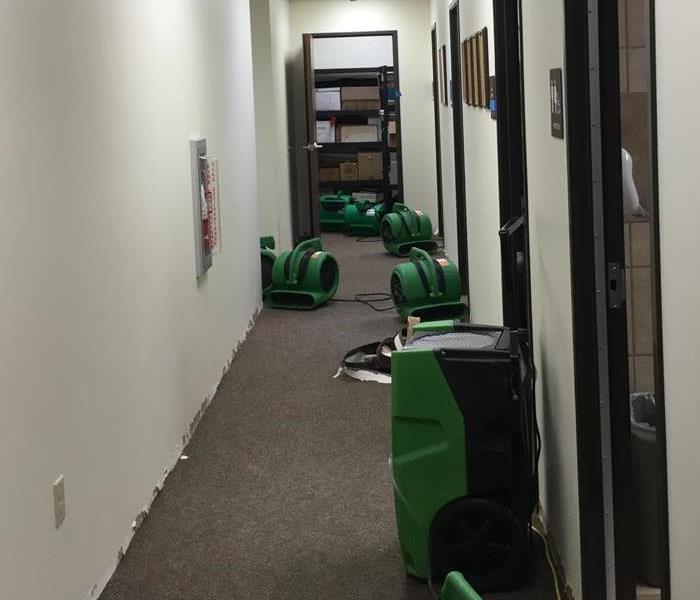 SERVPRO helping properly dry a commercial building.
SERVPRO helping properly dry a commercial building.
The first step to any water damage is removing the standing water. Even though your floors and walls may look dry at first glance; they are still wet to the touch. Most building materials, like drywall and wood, are porous and will retain significant water. The retained water will cause these materials to warp, swell, or break down and can also cause damage.
SERVPRO of Beaumont will manipulate the temperature and relative humidity to remove the remaining moisture. We use specialized equipment, including industrial air movers and dehumidifiers, to remove water retained by building materials and other hard-to-access moisture. Our SERVPRO professionals carefully monitor the progress using moisture meters until the materials return to acceptable drying goals.
Our SERVPRO of Beaumont professionals are trained and certified according to the Institute of Inspection Cleaning and Restoration Certification (IICRC) guidelines specifically in Water Restoration. SERVPRO also encorporates its own Employee Certification Trainings in Water Damage as well. Our SERVPRO team members are highly trained and ultimately Here to Help!
Mold
5/11/2018 (Permalink)
Fungi and mold occur naturally in our environment. In fact, there are over 100,000 kinds of fungi have been identified. Even though some forms of mold can add value to our lives, other forms can be harmful. Excessive amounts of mold, different types of mold, and/or exposure to molds may present health concerns for some people. Mold spores can colonize within 72 hours and multiply within just a few hours. Moisture is the foremost factor that causes mold growth. Physically removing the mold contamination is the primary means of remediation.
If you would like more information on mold and mold remediation, contact SERVPRO of Beaumont at (409) 212-1977 today. It’s a dirty job, but your local SERVPRO professionals are here to help when you encounter mold!
Being Prepared
5/10/2018 (Permalink)
April showers bring May flowers! May is always a very busy month as school is coming to an end and summer is just around the corner. And before we know it we will be back to Hurricane Season!
The same is true for preparedness planning in May. The following preparedness events take place this month and offer a great chance to educate yourself!
- Wildfire Community Preparedness Day (May 5, 2018)
- National Hurricane Preparedness Week (May 6-12, 2018)
- National Dam Safety Awareness Day (May 31, 2018)
- National Building Safety Month
May also brings two weeks to show appreciation for our first responders.
- National Police Week (May 13-19, 2018)
- National Emergency Medical Services (EMS) Week (May 20-26, 2018)
Be sure to visit ready.gov for more information and resources to be prepared!
National Building Safety Month
5/10/2018 (Permalink)
May is National Building Safety Month. Building safety month is its 38th year and is an initiative of the International Code Council (ICC) and their 64,000 members across the world, as well as their partners in building construction and design and the safety community. Building Safety Month is an opportunity to educate insurance and commercial property professionals, as well as the general public, on “what it takes to create safe, resilient, affordable, and energy efficient homes and buildings,” according to the ICC website.
The theme for 2018 is Building Codes Save Lives with a focus on safer communities over the five weeks in May. One of the topics highlighted during the third week of the month is Protecting Communities from Disasters. The general public may not be aware how codes and code officials “improve and protect the places where we live, learn, work, worship, and play,” and this month can certainly improve that awareness and educate communities on this topic!
Smoke Alarm Tips
4/24/2018 (Permalink)
- Install smoke alarms in every bedroom. They should be outside each sleeping areas and on every level of the home.
- Large homes may need extra smoke alarms.
- It is best to use interconnected smoke alarms. When on smoke alarm sounds, they all sound.
- Test all smoke alarms at least once a month. Press the test button to be sure that the alarm is working.
- Current alarms on the market employ different types of technology including multi-sensing, which could include smoke and carbon monoxide combined.
- Today's smoke alarms alarms will be more technologically advanced to respond to a multitude of fire conditions, yet mitigate false alarms.
- A smoke alarm should be on the ceiling or high on a wall. Keep smoke alarms away from the kitchen to reduce false alarms.
- People who are hard of hearing or deaf can use special alarms. These alarms have strobe lights and bed shakers.
- Replace all smoke alarms when they are 10 years old.
*Source: NFPA-Nation Fire Protection Association
The Importance of Cleaning Dryer Vents
4/23/2018 (Permalink)
According to FEMA, failure to clean home dryers causes 34% of home dryer fires. Home dryer fires cause $35 million in property loss and can even cause injury or death.
To reduce the risk of these fires happening in your home or business, SERVPRO of Beaumont can help clean dryer vents and ducts that may have lint buildup. Other tips for keeping your dryer vents clean from the National Fire Protection Agency include cleaning the lint filter before and after each load and making sure the outdoor vent flap will open and is not restricted by snow, a bird’s nest, or other potential obstacles.
For more information about cleaning dryer vents and other safety tips, contact the SERVPRO of Beaumont today at (409) 212-1977!
FEMA App
4/4/2018 (Permalink)
Be prepared to weather the storm with the FEMA App. This app allows you to get National Weather Service alerts for up to five locations to keep you informed on-the-go. It also has information on what to do before, during, and after different disasters. In the midst of an emergency, the app can give you directions to open shelters nearby, help you locate someone to talk to at a Disaster Recovery Center, and let you share images of damage and recovery efforts to help first responders and emergency managers.
This app is available to download for free for iOS and Android at the Apple Store and on Google Play.
Have other questions on how to prepare for a storm? Contact SERVPRO of Beaumont (409) 212-1977 on how to plan for an emergency!
Source: www.fema.gov/mobile-app
Faster to Any Disaster
3/16/2018 (Permalink)
 SERVPRO of Beaumont provides 24 hour fire and water damage restoration services.
SERVPRO of Beaumont provides 24 hour fire and water damage restoration services.
Flooding and water emergencies don’t have to wait for regular business hours and neither do we. SERVPRO of Beaumont provides emergency cleaning and restoration services 24 hours a day, 7 days a week—including all holidays.
Faster to Any Size Disaster
Flooding and water damage is very invasive. Water quickly spreads throughout your home and gets absorbed into floors, walls, furniture and more. SERVPRO of Beaumont arrives quickly and starts the water extraction process almost immediately. This immediate response helps to minimize the damage and the cleaning and restoration costs.
Need Emergency Service? Call us 24/7—(409) 212-1977
Water Damage Timeline
Within Minutes:
- Water quickly spreads throughout your property, saturating everything in its path.
- Water is absorbed into walls, floors, upholstery and belongings.
- Furniture finishes may bleed, causing permanent staining on carpets.
- Photographs, books, and other paper goods start to swell and warp.
Hours 1-24:
- Drywall begins to swell and break down.
- Metal surfaces begin to tarnish.
- Furniture begins to swell and crack.
- Dyes and inks from cloth and paper goods spread and stain.
- A musty odor appears.
48 Hours to 1 Week:
- Mold and mildew may grow and spread.
- Doors, windows, and studs swell and warp.
- Metal begins to rust and corrode.
- Furniture warps and shows signs of mold.
- Paint begins to blister.
- Wood flooring swells and warps.
- Serious biohazard contamination is possible.
More than 1 Week:
- Restoration time and cost increases dramatically; replacing contaminated materials and structure rebuilding may be extensive.
- Structural safety, mold growth, and biohazard contaminants pose serious risks to occupants.
How Do I Know If I Have Mold?
3/14/2018 (Permalink)
One of the many questions SERVPRO of Beaumont gets on a regular basis is “How do I know if I have mold?” Mold requires moisture and a food source to grow such as wallpaper, drywall or other organic building materials. In most cases, mold grows from having high humidity in your home or business, a non-ventilated bathroom or a recent water loss. However, if you believe that you do have mold growing in your home or business it is best to have a qualified environmental lab take samples. An environmental lab will be able to explain the testing process and provide results based off of the samples taken from your home. Based off of those results, they provide recommendations on how the mold would need remediation. Then, SERVPRO can take those results and recommendations to properly remediate the home or business of any microbial growth.
SERVPRO Disaster Recovery Team
3/12/2018 (Permalink)
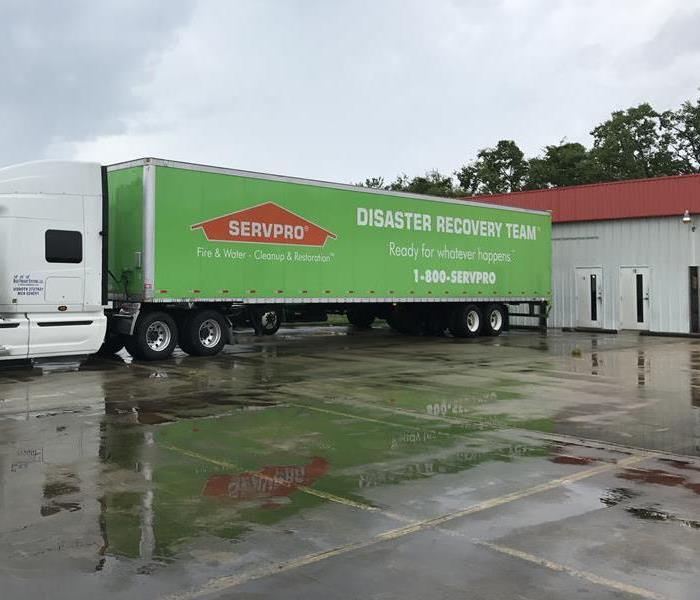 SERVPRO Disaster Recovery Team stationed at our office during Hurricane Harvey.
SERVPRO Disaster Recovery Team stationed at our office during Hurricane Harvey.
Did you know that SERVPRO has a specialized storm team and large loss response network to provide the resources to your property when others can’t? In the event of a disaster, SERVPRO professionals have the resources to relocate crews with equipment to take care of all of our customer’s needs. SERVPRO strategically places mobilization teams across the country to travel when needed to support in recovery after large storm events such as hurricanes. Our job as water damage restoration professionals is to limit the amount of business interruption. We understand that fast mitigation is key to getting your business back up and running. SERVPRO provides the resources in the event of a large storm event to make sure that the right equipment, procedures and training are in place to ensure that the structure is dry the first time and saves you time and money.
Do you have questions about how SERVPRO of Beaumont can help you prepare for a disaster? Contact us today at (409) 212-1977!
Document Drying
3/12/2018 (Permalink)
SERVPRO is a leader in the much overlooked market of document drying. In the event of a commercial water loss—it’s imperative that important documents such as legal documents, medical records and government documents are not overlooked.
SERVPRO has the capability in the event of a disaster to restore these documents. Listed below are just a few techniques that are used to help commercial clients and their pertinent documents.
• Vacuum Freeze Drying—Process in which an item containing moisture is frozen and dried using various vacuums and pressures to achieve sublimation.
• Digitizing—Ability to digitize records and documents eliminating the need to have massive file rooms.
• Gamma Irradiation—is a process that is used for cleaning/disinfecting decontaminated documents. In sewage or flood water (CAT 3) situations, documents are not only deteriorating, but they are infested with all types of bacteria.
• Certified Destruction
If you have any questions about SERVPRO’s document drying services, contact us today at (409) 212-1977!
What To Do Until Help Arrives
3/7/2018 (Permalink)
Many of us do not know the first steps to take in the event of water damage in our homes. SERVPRO has over 40 years of leadership and training in cleanup and restoration services. SERVPRO has put together a few Do’s and Don’ts to help in the event of water damage in your home.
Water Damage from Clean Water
DO:
- Shut off the source of the water as quickly as possible.
- Turn off any circuit breakers for wet areas of the building when access to the breaker box is safe from electrical shock.
- Remove as much excess water as possible by mopping & blotting.
- Wipe excess water from wood furniture after removing lamps and tabletop items.
- Place aluminum foil or wood blocks between furniture legs and wet carpet.
- Remove any documents, computers and other materials that are valuable or sensitive to moisture.
DON’T:
- Enter rooms with standing water where electrical shock hazards are at risk.
- Enter affected areas if electrical outlets, switches or circuit breakers are exposed to water/
- Leave books, newspapers. Magazines or other colored items on wet carpets or floors to cause staining.
- Leave oriental rugs or other colored rugs on wet wall-to-wall carpets to cause staining.
- Use your household vacuum cleaner to remove excess water. This could cause electrical shock or damage the vacuum cleaner.
- Use TVs or other appliances while standing on wet carpets or floors.
- Turn on ceiling fixtures if the ceilings are wet or enter rooms where ceilings are sagging from retained water.
Smoke Alarms
3/6/2018 (Permalink)
In the event of a fire, a working smoke alarm increases your chances of surviving the fire. Here are some smoke alarm tips to help keep you and your family safe:
- Install a dual sensor smoke alarm. These contain both ionization and photoelectric smoke sensors. Ionization smoke alarms are more responsive to flaming fires while photoelectric smoke alarms are more responsive to fires that begin with a long smoldering period.
- Test batteries monthly.
- Replace the batteries in a battery-powered and hard-wired smoke alarms at least once a year.
- Install smoke alarms on every level of your home. Also, place them inside and outside sleeping areas.
- Replace the actual smoke alarm unit every 8-10 years or according to the manufacturer’s instructions.
- Never disable a smoke alarm while cooking.
Source: www.ready.gov
Carpet Cleaning Tips for Your Business
3/5/2018 (Permalink)
Stains in your carpet can happen at any time. If you have the right tools, you can get some nice results on your carpet at home or business. Keep these tips in mind the next time disaster strikes!
- Always blot spills and liquid stains. NEVER scrub. Scrubbing just pushes the stain particles further in the carpet fibers, making the stain harder to remove and accelerates deterioration. Blot the stain starting from the edges and much of the stain can be removed without other cleaning supplies.
- Club soda works wonders in the event someone spills beer or wine on your carpet. Blot club soda on the stain. If club soda does not do the trick, mix it with a bit of white vinegar and spray the solution on the stain. Let sit for 15 minutes and then blot it up.
- Scrape off stuck on debris. Families with kids need the best arsenal of carpet cleaning tips because children can do a lot of damage in a short period of time. When candy or gum are stuck to the floor, try scraping it off with a knife before applying any moisture.
The best carpet cleaning tip, is to call SERVPRO of Beaumont for regular deep cleaning. This can help protect the integrity of the flooring and ensure that any stains or soil will not cause any permanent issues.
Preventing Water Damage
3/2/2018 (Permalink)
A small amount of water soaking into your floors, walls or cabinets is all it takes to cause damage in your home or business. A study of closed water damage insurance claims identified plumbing pipes and drain systems as the leading cause of interior water damage. The following tips can help you minimize the risk in your home or business.
- Proper Maintenance—majority of insurance claims were caused by corroded, rusty, or frozen pipes. Maintaining these in your home or business can help prevent any future damage.
- Look for an increase in your monthly water bill—pipes with leaks can cause your water to bill to increase.
- Rust stains, moisture in the walls or on the floor are all potential indicators of plumbing issues.
- If you are on a sewer system or you are located below street level—contact a plumbing professional to install a backflow prevention into your sewer system.
- Make sure to plant trees away from lateral drain lines to prevent roots from damaging pipes.
- NEVER pour grease down the drain.
Source: www.disastersafety.org
SERVPRO ERP Advantage
3/1/2018 (Permalink)
Do you own a business or businesses? In Southeast Texas, we know we can’t prevent disasters from happening, but we can prepare for them. What if I told you SERVPRO of Beaumont could help provide peace of mind to your businesses in the event of a disaster? With an Emergency Ready Profile (ERP), you can prepare your business and minimize work interruption by creating an immediate plan of action in the event of a disaster. An ERP is at no cost to you and/or your business. It places all important information in a smart phone app at the palm of your hand. It also provides shut-off valve locations, priority areas and priority contact information—creating a quick reference of what to do, how to do it and who to contact in the event of a disaster. Finally, it establishes SERVPRO of Beaumont as your local disaster mitigation and restoration provider.
Contact us today (409) 212-1977 for your no cost assessment of you facility preparing you for the next disaster!
Conditions in Southeast Texas Might Be Right for Mold
3/1/2018 (Permalink)
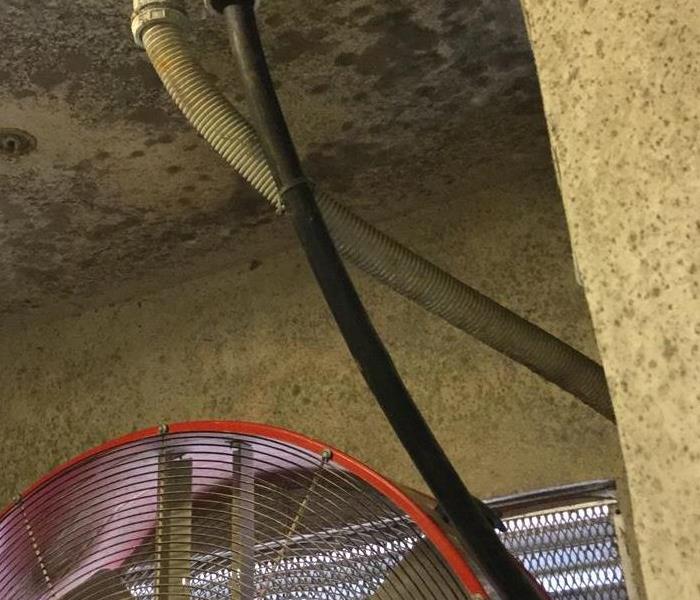 If you suspect mold in your home or business, call us at (409) 212-1977.
If you suspect mold in your home or business, call us at (409) 212-1977.
It’s estimated that more than 1 million types of mold exist, yet less than 10 percent have actually been named. This means mold is very common in both indoor and outdoor environments. While mold and humans can sometimes co-exist without issue, there are certain species of mold that can cause health effects for some people.
If the right conditions exist, mold will grow. Those conditions include:
- Water - Different mold types require varying amounts of liquid before growth begins.
- Temperature - Normal indoor temperatures will promote mold growth.
- Time - Initial mold colonizers can take hold within one day after being exposed to an adequate water supply.
Mold growth can occur in any home, so it’s important to keep an eye out for situations that might promote mold activity. Roof/chimney leaks, wet basements, or condensation from ducts that dampen surrounding insulation are just a few examples of issues that make a house a prime target for mold growth.
If you suspect mold in your home, call SERVPRO of Beaumont to assess the situation. We have the knowledge, tools and track record to effectively remediate mold in your home or business.
Home Fires
2/28/2018 (Permalink)
Did you know that each year more than 12,600 people are injured in home fires in the United States? It is important to be prepared and know the facts about home fires.
- Home fires can be prevented.
- Fire is fast. In two minutes, a fire could kill you. In only five minutes, a whole house can be engulfed in flames.
- Fire is very hot! However, heat and smoke have the potential to be more dangerous than the flames.
- Hot air can burn your lungs and fire produces poisonous gas that can make you sleepy and unable to escape.
- Fire is very dark. This can make it difficult to find your way out of your house during a fire.
- Fire is deadly! Fire uses up oxygen you need to breathe.
You can always be prepared to prevent deadly fires in your home. Just taking a few precautions can help save you and your family.
These fire facts were found on www.ready.gov!
The Science Behind Drying
2/22/2018 (Permalink)
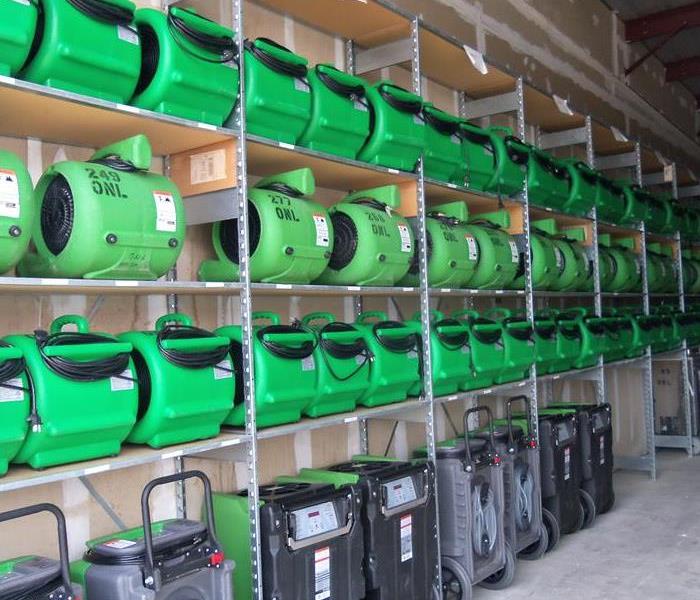 Warehouse full of state of the art drying equipment,
Warehouse full of state of the art drying equipment,
Most people do not know that there is a process behind the science of drying. One of SERVPRO’s goals is to help restore a water damaged structure back to its preloss condition. The knowledge of psychrometrics is a vital part of the restoration process. Here at SERVPRO, we understand the first reaction during any water loss is to grab a towel and to try and clean the mess up. SERVPRO of Beaumont is trained in the science of drying and follow strict industry guidelines to help lower the chances of any secondary damage to your home. Allowing your home to dry on your own is possible. However, drying naturally make take too long and the moisture may can cause more damage to areas in your home. Our team is trained to help speed up the natural drying process, including equipment to help dry hardwood floors, difficult to reach areas, and spaces inside walls. Our team uses state of the art monitoring equipment and a proven scientific process to help speed up the drying process. This process helps our customers get back to normal in no time!
How to Prevent Mold Growth in Your Home
2/21/2018 (Permalink)
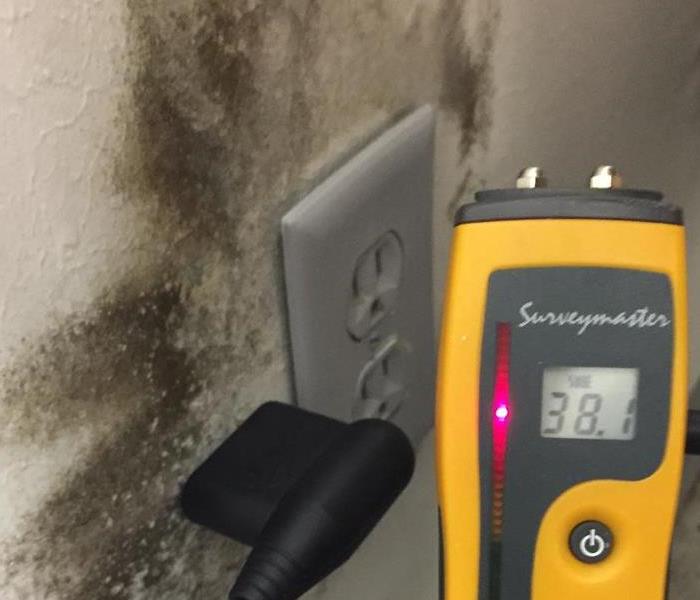 This wall shows mold growth due to a water loss that was not dried properly.
This wall shows mold growth due to a water loss that was not dried properly.
- Keep humidity levels in your home relatively low–no higher than 50%. Keeping your A/C running or using a dehumidifier will help keep the humidity level low.
- Make sure there is air flow throughout the home. Use exhaust fans that vent outside the home in kitchen and bathroom areas.
- Fix any leaks that may be in the roof, walls or plumbing so mold does not have a moisture source to grow.
- Clean up and dry out your home fully and as quickly as possible in the event of a water loss or flooding.
- Clean areas with an antimicrobial to prevent any future mold or mildew growth
- Remove or replace carpet and upholstery that have been saturated with water and were not dried properly and/or right away.
Source: www.cdc.gov/mold
If mold causes damage to your home, SERVPRO of Beaumont is only a phone call away!
Severe Weather Safety
2/20/2018 (Permalink)
Severe weather can happen at any time, anywhere. Each year, Americans cope with an average of the following intense storms:
- 10,000 severe thunderstorms
- 5,000 floods or flash floods
- 1,300 tornadoes
- 2 land falling deadly hurricanes
Knowing your risk of severe weather, taking action, and being an example are just a few steps you can take to be better prepared to save your life and assist in saving the lives of others.
Know Your Risk. The first step to becoming weather-ready is to understand the type of hazardous weather that can affect where you live and work, and how the weather could impact you, your business and your family. Check the weather forecast regularly, obtain NOAA Weather Radio, and learn about Wireless Emergency Alerts. Severe weather comes in many forms, and your shelter plan should include all types of local hazards.
Take Action. Take the next step in severe weather preparedness by creating a communications plan for your home and business. Keep important papers and valuables in a safe place.
Be an Example. Once you have taken action to prepare for a severe weather, share your story with co-workers, family, and friends on Facebook or Twitter. Your preparedness story will inspire others to do the same.
Emergency Water Damage Tips
2/19/2018 (Permalink)
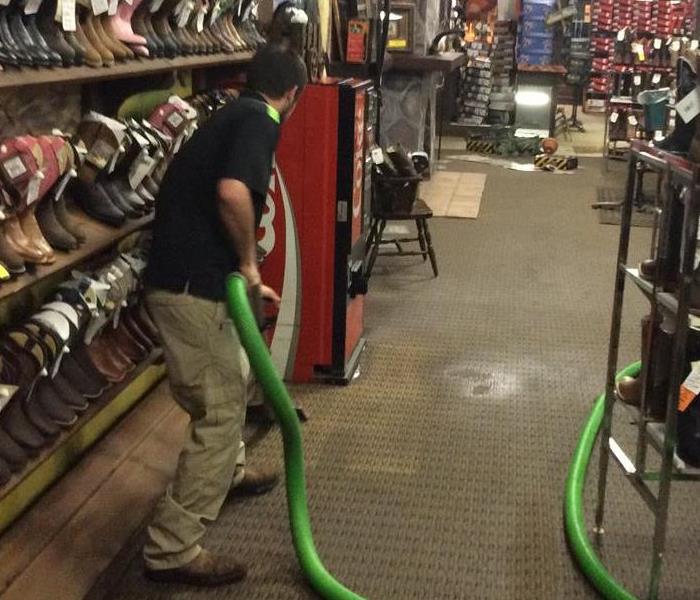 Extracting water from commercial water loss.
Extracting water from commercial water loss.
In the event that your business has a water loss; here are some steps to help minimize damage and get you back in business.
- Shut off the water source if possible or contact a qualified party to stop the water source.
- Turn off circuit breakers for wet areas of the building when access to the power distribution panel is safe from electrical shock.
- Remove as much excess water as possible by mopping and blotting.
- Place aluminum foil or wood blocks between furniture legs and wet carpet.
- Move any paintings, art objects, computers, documents, and other sensitive valuables to a dry place.
- Don’t enter affected areas if electrical outlets, switches, circuit breakers, or electrical equipment are exposed to water. Always avoid shock hazards.
- Don’t use your household vacuum cleaning to remove water; this could cause electrical shock or damage the vacuum cleaner.
- Don’t turn on ceiling fixtures if ceiling is wet or enter rooms where ceilings are sagging from retained water.
Be Prepared
2/15/2018 (Permalink)
Is your business prepared in the event of an emergency or a disaster? As many as 40% of businesses may never reopen after suffering a disaster. Here are a few helpful tips to prepare your business for the unexpected.
Technology is a vital tool for most businesses. Many of us use technology on a day to day basis already. Did you know that this same technology can help prepare your business in the event of a disaster?
Store Information Online:
There are many places to store important information securely online. Services like Google Drive and Dropbox offer free ways to store different types of files all at the touch of one button. Ready.gov suggests saving an electronic version of insurance policies, identification documents, medical records, etc.
Mark Yourself Safe:
The American Red Cross offers a Safe & Well check-in site to list yourself safe or find family and friends in situations where communication is difficult to establish. Facebook also has a check in feature that is activated after natural disasters or a crisis.
Get an Emergency Ready Profile:
SERVPRO of Beaumont is proud to offer free Emergency Ready Profiles (ERP) to help prepare you, your property, and your business for an emergency. By setting up and appointment with SERVPRO, our team helps set up your ERP to minimize business interruption by developing this immediate plan of action.
Contact us at (409) 729-2800 for more information about your FREE ERP!
Hurricane Harvey
2/14/2018 (Permalink)
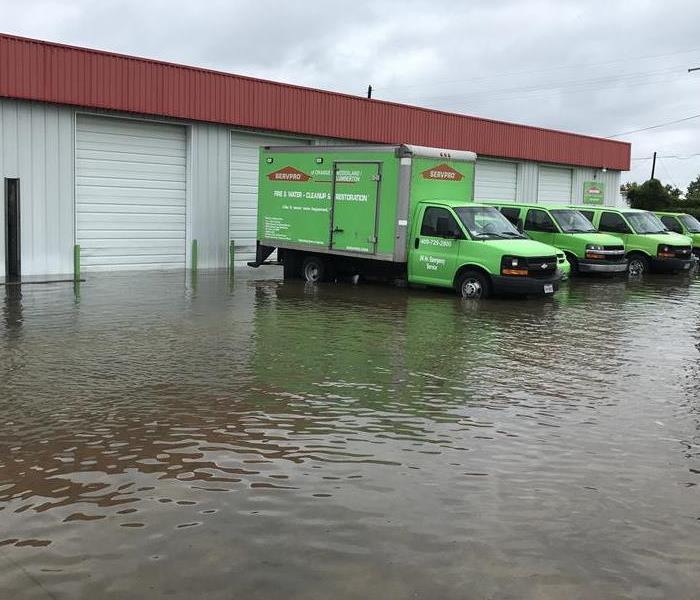 Our flooded office due to Hurricane Harvey.
Our flooded office due to Hurricane Harvey.
Here we are 6 months after the biggest storm event our community has endured in the many years. Hurricane Harvey affected our SERVPRO office in many ways. Our office flooded alongside with the rest of Southeast Texas. Our SERVPRO team strived to service as many of the affected community members as possible. With the help of our SERVPRO Storm Team, we were able to touch so many of those affected during this disastrous event. It has been truly amazing to see Southeast Texas come together; as many experienced loss on such a significant scale. Southeast Texas has done a wonderful job restoring the community and help place a sense of normalcy for our area. Our SERVPRO family is blessed to be a part of such a strong and united community!
Types of Smoke
12/21/2017 (Permalink)
Did you know that there are different types of smoke? Each type of smoke can cause a wide array of damages to your home in the event of a fire. The damage resulting from a fire can be complicated due to the different types of smoke.
- Wet Smoke (Plastic and Rubber): Low heat, smoldering, pungent odor, sticky, smeary. Smoke webs are more difficult to clean.
- Dry Smoke (Paper and Wood): Fast-burning, high temperatures; heat rises, therefore smoke rises.
- Protein Fire Residue (Produced by the evaporation of material rather than from a fire): Virtually invisible, discolors paints and varnishes, extreme pungent odor.
- Fuel Oil Soot (Furnace Puff Backs): While “puff backs” can create havoc for homeowners, SERVPRO of Beaumont can, in most cases, restore the contents and structure quickly.
- Other Types (Tear gas, fingerprint powder, and fire extinguisher residue): Special loss situations require special care.
SERVPRO of Beaumont is trained and certified in Fire & Smoke Damage Restoration. Our knowledge helps restore your home back to preloss condition.
Kitchen Cautions
12/19/2017 (Permalink)
November and December families are brought together to celebrate the holiday season by preparing a delicious feast, but if you don’t practice safe cooking habits, your holidays could become hazardous very quickly. According to the National Fire Protection Association, cooking fires are the number one cause of home fires and home injuries. The leading cause of fires in the kitchen is unattended cooking. It’s important to be alert to prevent cooking fires.
- Be on alert! If you are sleepy or have consumed alcohol don’t use the stove or stovetop.
- Stay in the kitchen while you are frying, grilling, boiling, or broiling food.
- If you are simmering, baking, or roasting food, check it regularly. Remain in the kitchen while food is cooking and use a timer to remind you that you are cooking.
- Keep anything that can catch on fire—oven mitts, wooden utensils, food packaging, towels, or curtains—away from the stovetop.
If you have a cooking fire, consider the following safety protocols to help keep you and your family safe.
- Just get out! When you leave close the door behind you to help contain the fire.
- Call 9-1-1 or the local emergency number after you leave.
- For an oven fire, turn off the heat and keep the door closed.
- If you try to fight the fire, be sure others are getting out and you have a clear way out.
- Keep a lid nearby when you’re cooking to smother small grease fires. Smother the fire by sliding the lid over the pan and turn off the stove top. Leave the pan covered until it is completely cooled.
Mold Remediation
12/6/2017 (Permalink)
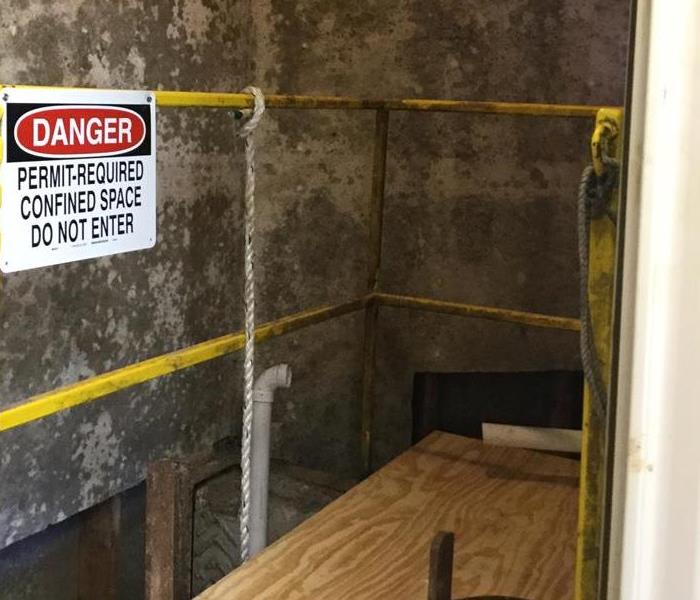 Mold growth in a storage closet after recent flooding.
Mold growth in a storage closet after recent flooding.
Fungi and Mold can naturally occur in our environment. In fact over 100,000 type of fungi have been identified. Moisture is the foremost factor that causes mold growth. It only takes a little bit of excess water or humidity for mold to form in your home or business. After all of the recent flooding throughout Southeast Texas, mold is a huge concern for homeowners and businesses.
If you think you may have a mold problem, contact a SERVPRO Professional and be alert for the following:
- The presence of visible mold
- Strong musty odors which may indicate mold is present
- Any evidence of past moisture problems that might have caused undetected mold growth
- Excessive humidity
Mold spores can colonize within 72 hours and multiply within just a few hours. Physically removing mold contamination is the primary means of remediation. In most water damage situations, excessive mold growth is not a problem and we can safely remediate your home or business to preloss condition. The need to address the presence of mold can only be determined by an on-site, indoor environmental specialist.
Call SERVPRO of Beaumont with any questions that you may have. We are locally owned and operated, which means when you call us, we can respond quickly with the help that you need. Don’t try to tackle a mold situation yourself. Call the pros at SERVPRO (409) 729-2800.
Light the Night Safely
12/5/2017 (Permalink)
Pretty lights, candles, and decorations are just a few of the items bringing charm and cheer to the holiday season—however, if they are not used carefully your holidays may go from festive to frightening.
The American Red Cross offers the following safety tips to help greatly reduce the fire risk in your home or business this holiday season.
- Place Christmas trees, candles, and other holiday decorations at least three feet away from heat sources like fireplaces, portable heaters, radiators, and heat vents.
- Make sure that light strings and other holiday decorations are in good condition. Do not use anything with frayed electrical cords and always follow the manufacturer’s instructions.
- Always unplug the tree and holiday lights before leaving the property or going to bed.
- Never use lit candles to decorate a tree. Always extinguish candles before leaving the room or going to bed.
SERVPRO® of Orange/Nederland/Lumberton wishes you and your family a safe & happy holiday season!
Every Second Counts
12/5/2017 (Permalink)
Every second counts during a fire. Fire experts agree; people have as little as two minutes to escape a burning home before it’s too late to get out. In a matter of moments, a small flame can become a major fire, making it critical to be prepared and have an escape plan in place. The American Red Cross suggests that families have a developed and practice a home fire escape plan. Here are a few suggestions to help you and your family to develop an emergency escape plan:
- Draw a map of each level—Show all doors and windows. Find two ways to get out of each room. Make sure that all doors and windows that lead outside open easily.
- Consider escape ladders—This is something to consider for sleeping areas on the second and third floors. Only purchase collapsible escape ladders evaluated by a recognized testing laboratory. Store them near the window where they will be used.
- Choose an outdoor meeting place—Make sure the meeting place is a safe distance in front of your home, where everyone can meet after they’ve escaped. Make sure to mark the location of the meeting place on your escape plan.
- Teach children—Teach them how to escape on their own in case you cannot help them. Plan for everyone in your home, with special considerations for elderly or disabled individuals.
- Practice makes perfect—Practice your fire escape plan during the day and at nighttime, at least twice a year.
Celebrate Summer Safety
7/18/2017 (Permalink)
 A fire on the beach enjoying the summer
A fire on the beach enjoying the summer
SERVPRO is “Ready for whatever happens.”
You Can Be Too This Summer
Each year, families and friends across the country enjoy the summer months with barbecues, camping trips, or by cooling off in a pool or lake. To enjoy these occasions, it is important to keep safety top of mind to ensure you have fun in the sun.
According to a recent study by the U.S. Consumer Product Safety Commission, nearly 11,900 Americans are injured by fireworks in 2015, with the majority happening in the month surrounding the Fourth of July. Another 8,700 are injured by charcoal/wood-burning and propane grill fires. A grill should always be supervised when in use. Keep children and pets a safe distance from the grilling area to prevent accidental burns or tipping of the grill.
Grills also cause an average of 8,900 home structure or outdoor fires. “These fires caused an annual average of 50 civilian injuries and $2 million in direct property damage,” according to the National Fire Protection Association (NFPA).
If you enjoy lounging by the pool or going for a boat ride to cool off from the summer sun, make sure you exercise caution, especially when children are present. Only swim in the approved areas and supervise children at all times when near the water.
The summer season should be a time to make memories and enjoy the great outdoors. Don’t become a statistic. Take precautions to prevent these events from putting a damper on the your summer months.
CELEBRATE SUMMER SAFETY
Summer is a time to enjoy the great outdoors, but it is also important to keep safety in mind. Consider the following tips, provided by the Nation Fire Protection Association, to keep you and your family safe all summer long.
- When using a charcoal grill, only use starter fluids designed for barbecue grills; do not add fluid after the coals have been lit.
- When using a gas grill, ensure the hose connection is tight; check hoses for leaks. Applying soapy water to the hoses will easily and safely reveal any leaks.
- When camping, always use a flame-retardant tent and set up camp far away from the campfire.
- Always build a campfire downwind from the tent area. Clear vegetation and dig a pit before building your fire. Extinguish the fire before going to sleep or leaving the campsite.
- Store liquid fire starter (not gasoline) away from your tent and campfire and only use dry kindling to freshen a campfire.
Your local SERVPRO Franchise Professionals wish you a safe and happy summer.
Extreme Heat
6/1/2017 (Permalink)
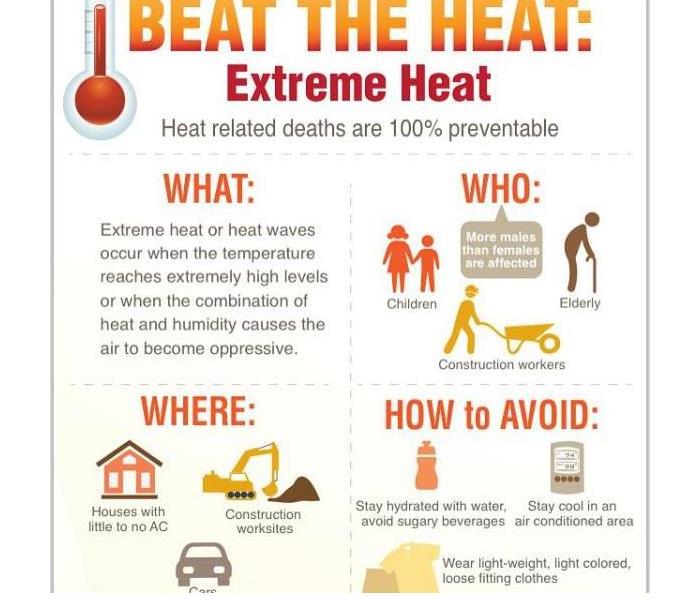 Helpful tips on how to stay safe
Helpful tips on how to stay safe
Extreme Heat
As summer approaches, it is time to consider safety precautions for extreme heat in the coming months. Heat affects all people, but especially the young, elderly, sick, and overweight. Urban area residents also have a greater chance of being affected than those who live in rural areas due to the heat island effect.
According to the EPA, “the sun can heat dry, exposed urban surfaces, such as roofs and pavement, to temperatures 50-90 degree F hotter than the air, while shaded or moist surfaces-often in more rural surroundings-remain close to air temperatures.” These surface heat islands are strongest during the day when the sun is shining, while the atmospheric heat islands are more likely after sunset “due to the slow release of heat from urban infrastructure.”
Whether you are in an urban or rural area, there are several things you can do to prepare for and prevent extreme heat from affecting you. If possible, stay indoors in air conditioning. Be sure to check on your pets that may be outdoors or bring them inside. Stay hydrated and limit alcohol and caffeine intake.
If you must go outside, wear loose-fitting, light-colored clothing, and be sure to apply sunscreen often. Pay attention to signs of heat exhaustion, which are heavy sweating; weakness; cold, pale and clammy skin; nausea or vomiting; and fainting, according to the Center for Disease Control and Prevention (CDC). Heat exhaustion can lead to heat stroke, which is life-threatening. Signs of heat stroke are a high body temperature (103 degree F), rapid and strong pulse, and possible unconsciousness. If you think someone has heat stroke, call 911 immediately and move the person somewhere cool, wet clothes or a bath. Do not give a person with heat stroke fluids, and treat the situation as a serious medical emergency (CDC).
If you live in a humid climate, be aware of the heat index. The heat index factors in the humidity, which can make the temperature fell 15 degrees hotter.
Extreme heat is a serious danger. For more information on preparation and prevention, visit ready.gov or cdc.gov.
Extreme Heat Safety tips to Prepare Your Home
- Install window air conditioners snugly; insulate if necessary.
- Check air-conditioning ducts for proper insulation.
- Install temporary window reflectors (for use between windows and drapes) such as aluminum foil-covered cardboard, to reflect heat back outside.
- Weather-strip doors and sills to keep cool air in.
- Cover windows that receive morning or afternoon sun with drapes, shades, awnings, or louvers. (Outdoor awnings or lovers can reduce the heat that enters a home by up to 80 percent.)
- Keep storm windows up all year.
Biohazard, Crime Scene, and Vandalism Clean up
5/2/2017 (Permalink)
 This is a biohazard loss that SERVPRO was called into help and cleanup.
This is a biohazard loss that SERVPRO was called into help and cleanup.
Biohazard, Crime Scene, and Vandalism Cleanup
Recognized as a leading fire and water cleanup and restoration provider by hundreds of insurance companies, SERVPRO Professionals also offer fast, reliable biohazard and crime scene cleanup and restoration services to residential and commercial property owners.
Exposure to biological and chemical contaminants can pose serious health consequences for building occupants, employees, customers, and owners. A failure to properly handle and safely remove such hazardous substances can contribute to unhealthy and even dangerous environments.
The SERVPRO of Beaumont professionals are trained to safely and effectively remove biohazardous substances and prepare waste for proper disposal according to OSHA, EPA, and state and local health regulations.
Equipped with the necessary safety equipment and cleaning products, the SERVPRO of Beaumont professionals help turn unsafe environments into clean, safe homes, and offices.
SERVPRO of Beaumont professionals can help with the following issues:
- Bloodborne Pathogens
- Methamphetamine Labs
- Crime Scene Residues
- Arson
- Vandalism
- Sewage Backups
- Black Water Intrusions
- Mold Mitigation and Remediation
Bloodborne Pathogens
SERVPRO of Beaumont professionals remove and dispose of bodily fluids, tissue, and other potentially pathogenic substances resulting from accident, trauma, crime, or death. Trained SERVPRO technicians thoroughly clean, disinfect, and deodorize, the structure.
Methamphetamine Labs
Many of the chemicals used in the production of illegal drugs, such as methamphetamine, are volatile and can leave harmful residues throughout a structure. SERVPRO of Beaumont professionals follow federal and state guidelines to properly clean all surfaces.
Crime Scene Residues
From fingerprint power and evidence-gathering chemicals to tear gas and pepper spray residues, SERVPRO of Beaumont professionals can clean and restore your property and contents.
Arson and Vandalism
SERVPRO of Beaumont professionals are recognized as leaders at helping property owners recover quickly from fire and water damage. SERVPRO of Beaumont also provides general cleaning and deodorization services for situations resulting from vandalism including graffiti, egg, spoiled foods, and human or animal waste.
Do You Have Dirty Ducts?
3/24/2017 (Permalink)
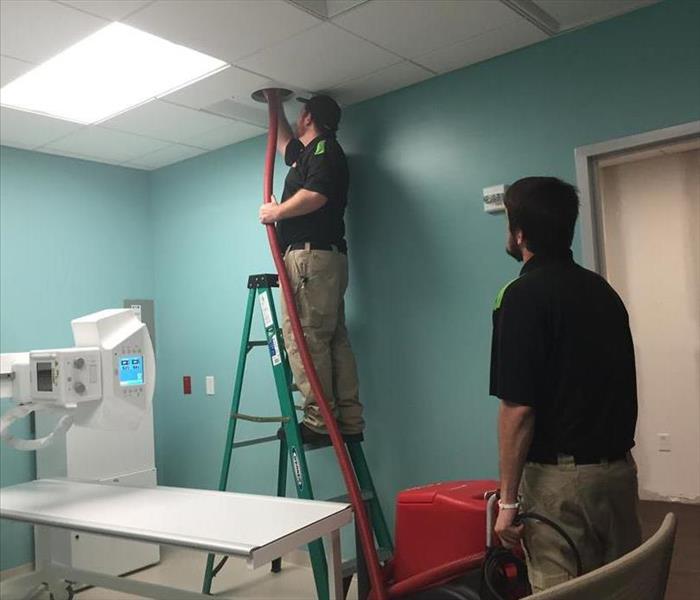 This is a picture of a commercial duct clean at a medical facility.
This is a picture of a commercial duct clean at a medical facility.
Do You Have Dirty Ducts?
Improve your indoor air quality with duct cleaning
Did you know your ventilation system is often the biggest culprit in poor indoor air quality? Inspecting the ductwork in your facility or home should be a high priority. In most cases, the HVAC system has been operating for some time without much attention. Dirty ducts can circulate odors, contaminants such as mold, and irritating dust throughout your building or home.
A routine part of your local SERVPRO Franchise Professional’s service is inspecting the heating, ventilation, and air conditioning unit (HVAC). Keeping the HVAC and ductwork clean can potentially extend the life-span of the equipment by allowing it to operate at peak condition, which may not always be necessary. SERVPRO Franchise Professionals will inspect your HVAC system and ductwork and make recommendations about the best way to address any indoor air quality concerns. This inspection can help save you money and provide peace of mind on the health of your HVAC system and ductwork.
In some circumstances, such as after a fire, smoke, or suspected mold growth, duct cleaning becomes an essential part of the cleanup process. In these cases your SERVPRO Franchise Professional can often restore the HVAC system and ductwork to pre-damage condition.
If you have a fuel-burning furnace, stove, or fireplace, the U.S. Environmental Protection Agency (EPA) recommends they be inspected for proper functioning and be serviced before each heating season to protect against carbon monoxide poisoning.
The SERVPRO duct cleaning system is proven and cost-efficient. Unlike the majority of duct cleaning services, your SERVPRO Franchise Professional uses a portable ventilation and air duct cleaning system to examine ductwork and make a clean sweep, removing years of dust and grime.
- The process begins by using patented equipment, including a roto-scraper, which automatically adapts to the duct’s shape and diameter while traveling through the duct, removing debris and filth before vacuuming begins.
- Next, a powerful push-pull air delivery and collection system transfers the debris from the ducting to a 16-gallon container.
- Air is filtered through a HEPA filtration system, removing 99.97 percent of the particles in the airstream. HEPA filters capture debris and keep the indoor environment clean.
- As an optional process, a sealant or coating product may be sprayed to address odor or microbial concerns.
- Filters will either be cleaned or replaced to remove odor and dirt.
For more information on duct cleaning, or to schedule an appointment, contact SERVPRO of Beaumont today at 409-212-1977.
Understanding Water Types
3/9/2017 (Permalink)
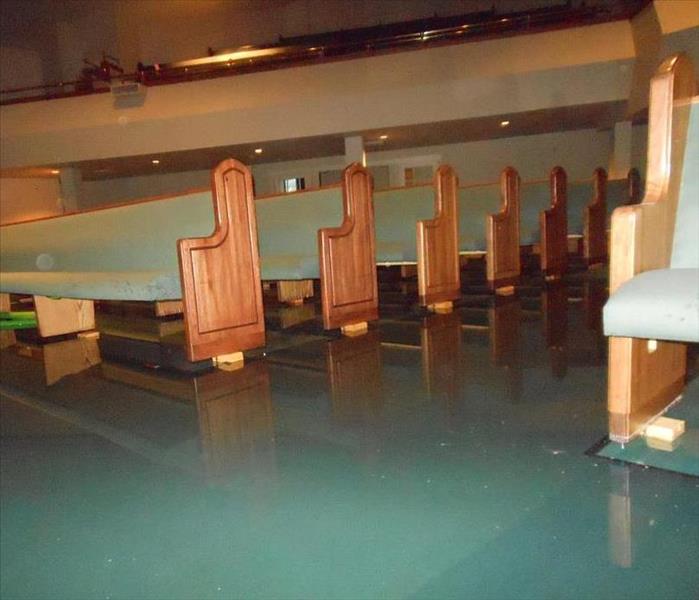 This is a picture of a commercial water loss that occurred at a church. Notice the blocking of the pews.
This is a picture of a commercial water loss that occurred at a church. Notice the blocking of the pews.
Understanding Water Types
When your home or business suffers a water damage, understanding what type of water you are dealing with is critical to ensuring proper cleanup.
There are three types of water. Clean water is water from a broken pipe, or other water source; rainwater is also considered clean. The term gray water is used to classify slightly contaminated water. Clean water becomes gray water when it is left untreated allowing bacteria and other contaminants to begin growing, making the water hazardous. Black water is highly contaminated and filled with fungi, bacteria, chemicals and more. Black water is typically caused by sewage damage, flooding or any type of natural disaster. Black water should always be handled by trained professionals.
Consider taking the following precautions to help minimize damage or prevent further damage while waiting for help to arrive.
Damage from Clean Water
- Shut off the water source if possible or contact a qualified professional to do so.
- Turn off circuit breakers for wet areas of the building if access to the power distribution panel is safe from potential electrical shock. Do not enter rooms with standing water, as electrical shock hazards may exist.
- Remove as much excess water as possible by mopping and blotting. Wipe excess water from wood furniture after removing lamps and tabletop items.
- Remove and prop up wet upholstery cushions to allow more even drying.
- Move any paintings, are objects, computers, documents and other valuable items that may be sensitive to moisture to a safe place.
- Do not leave books, newspapers, magazines or other colored items on wet carpets or floors as they may cause staining.
- Do not use your household vacuum cleaner to remove water as there is potential for electrical shock or causing damage to the vacuum cleaner.
- Do not turn on ceiling fixtures if ceiling is wet; do not enter rooms where ceilings are sagging from retained water.
-
Damage from Contaminated Water
- Avoid all contact with sewage and items contaminated by sewage. Wash your hands thoroughly if you come in contact with contaminated items.
- Do not walk through contaminated areas, as you could spread damage to unaffected areas.
- Do not turn on the HVAC system if there is a possibility of spreading contaminated air.
- Do not use household fans to dry the structure, air flow could spread contaminants.
- Discard any food and/or products for personal hygiene and cleanliness if exposed to the contaminated areas.SERVPRO’s network of more than 1,700 Franchises is ready to help in the event a fire, water, or mold loss occurs
- Call on a restoration system serving insurance companies and their insureds, as well as thousands of commercial property owners in North America. Don’t leave your property to chance.
Halt Winter Heating Hazards
1/23/2017 (Permalink)
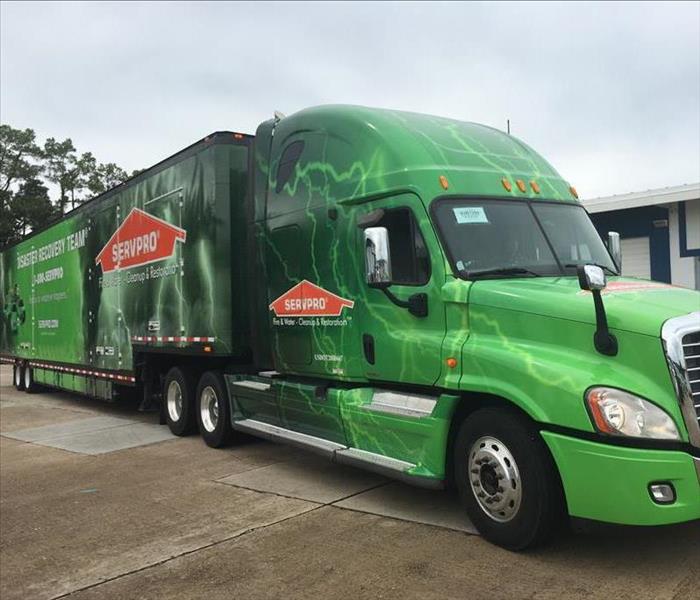 SERVPRO is ready for any size disaster. This is one of our trucks that is ready to go at a moments notice.
SERVPRO is ready for any size disaster. This is one of our trucks that is ready to go at a moments notice.
Halt Winter Heating Hazards
The winter season is here and with it comes shorter days and lower temperatures. No matter where you live, winter brings a change in the weather. In a effort to keep our homes and workplaces cozy, many people use alternative hear sources like fireplaces, portable space heaters, and wood burning stoves. Did you know, heating equipment is a leading cause of home fire deaths? According to the National Fire Protection Association, heating equipment fires cause an estimated $1 billion in direct property damage annually. Keep the following safety tips in mind to help reduce your risk of heating-related fire.
- Keep anything flammable at least three feet away from heating equipment, like the furnace, fireplace, wood stove, or a portable space heater. Have a three foot “kid friendly zone” around open fires and space heaters.
- Make sure the fireplace has a sturdy screen to stop sparks from flying into the room. Ashes should be cool before putting them in a metal container. Keep the container a safe distance away from your home.
- Remember to turn portable heaters off when leaving the room or going to bed.
- Always use the right kind of fuel, specified by the manufacturer, for fuel burning space heaters.
- Have heating equipment and chimneys cleaned and inspected every year by a qualified professional.
- Have a qualified professional install stationary space heating equipment, water heaters or central heating equipment according to the local codes and manufacturer’s instructions.
- Test smoke alarms monthly.
50% of all residential heating-related fires are reported during the months of December, January, and February.
If your property does suffer fire damage, contact the SERVPRO of Beaumont Professionals to help make it “like it never even happened.”
SERVPRO is quietly taking to the streets, every hour of every day, proving that whenever there is a house full of water or an office full of smoke, there is also a van full of clean.
Winter Ready
11/28/2016 (Permalink)
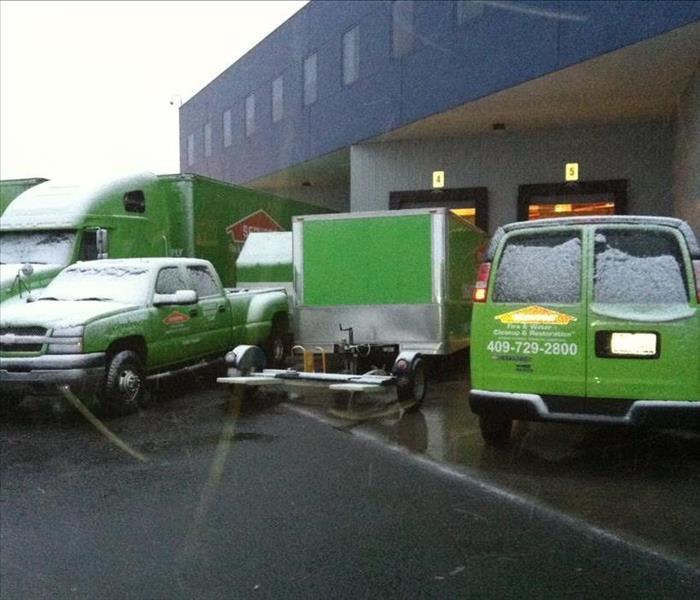 This is a picture of SERVPRO of Beaumont helping out a commercial building after a major water loss.
This is a picture of SERVPRO of Beaumont helping out a commercial building after a major water loss.
Is Your Property Winter Ready?
Cold weather can have a huge impact on your home or business if you are not properly prepared. Whether it is heavy rain, freezing temperatures, damaging winds, sleet or snow, all can cause serious and costly property damage. While you cannot control the weather, you can take steps to be prepared and help take the sting out of winter weather.
To help prevent costly damages due to weather, consider taking the following precautions to protect your property before colder weather hits.
- Check your business property for downed tree limbs and branches. Weather, such as wind, heavy rain, ice and snow, can cause branches to fall, which could cause damage to the property and potentially cause personal injuries.
- Roofs, water pipes and gutters should all be inspected to ensure they are in proper order. Gutter downspouts should be directed away from your home or building. Clear gutters of debris that may have gathered during the fall. Leaves and other obstructions can lead to a damming effect, that can lead to roof damage and interior water problems.
- Inspect property, especially walkways and parking lots, for proper drainage to alleviate flood hazard potential.
- Inspect all handrails, stairwells and entryways to address and correct potential slippery or hazardous areas. Install mats or non-slip surfaces and post caution signs where water could be present.
- Protect water pipes from freezing by simply allowing water to drip when temperatures dip below freezing. If pipes are under a cabinet, leave the cabinet doors open allowing warm inside air to circulate around the pipes. If the building has outdoor faucets, consider shutting water off at the main valve in the basement or crawl space. Once the valve is off, open the outdoor faucet to ensure it drains, preventing any remaining water from freezing in the pipe.
- Ask the SERVPRO of Beaumont franchise business professionals about completing an Emergency READY Profile (ERP) for your business. The ERP is a no cost assessment to your facility, and provides you with a plan to get back in business fast following a disaster.
When winter weather strikes, call The SERVPRO of Beaumont professionals to strike back.
Understanding The Behavior of Smoke
11/2/2016 (Permalink)
 This is a picture of a half cleaned dishwasher that was affect due to a kitchen fire.
This is a picture of a half cleaned dishwasher that was affect due to a kitchen fire.
Understanding the Behavior of SMOKE
The damage to your property following a fire can often be complicated due to the unique behavior of smoke. There are two different types of smoke-wet and dry. As a result, there are different types of soot residue after a fire. The SERVPRO of Beaumont Professionals are thoroughly trained in fire cleanup and restoration and know the different types of smoke and their behavior patterns. Knowing this information is vital to proper restoration. Before restoration begins, The SERVPRO of Beaumont Professionals will survey the loss to determine the extent of impact from fire, smoke, heat, and moisture on the building materials and contents. The soot will then be tested to determine which type of smoke damage occurred. Pretesting determines the proper cleaning method and allows the SERVPRO of Beaumont Professionals to focus on saving your precious items.
The SERVPRO of Beaumont Professionals know smoke can penetrate various cavities within the structure, causing hidden damage and odor. Their knowledge of building systems helps them investigate how far smoke damage may have spread. The following are additional facts you may not know about smoke.
- Hot smoke migrates to cooler areas and upper levels of a structure.
- Smoke flows around plumbing systems, seeping through the holes used by pipes to go from floor to floor.
- The type of smoke may greatly affect the restoration process.
Different types of Smoke
- Wet Smoke (Plastic and Rubber) - Low heat, smoldering, pungent odor, sticky, smeary. Smoke webs are more difficult to clean
- Dry Smoke (Paper and Wood) – Fast burning, high temperatures, heat rises therefore smoke rises.
- Protein Fire Residue (Produced by evaporation of material rather than from a fire) – Virtually invisible, discolors paints and varnishes, extreme pungent odor.
- Fuel Oil Soot (Furnace Puff Backs) – While “puff backs” can create havoc for homeowners, SERVPRO Franchise Professionals can, in most cases, restore the contents and structure quickly.
- Other Types (Tear gas, fingerprint powder and fire extinguisher residue) – Special loss situations require special care.
The SERVPRO of Beaumont Professionals are trained to handle even the toughest losses. If your home or business suffers fire or smoke damage, contact the SERVPRO of Beaumont Franchise Professionals to help make it “Like it never even happened.”
Ready for whatever happens, SERVPRO Storm Team
10/4/2016 (Permalink)
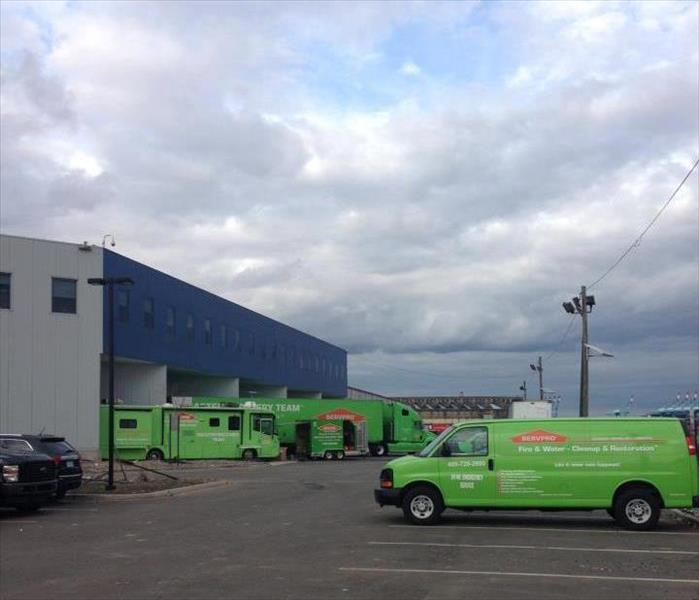 SERVPRO of Beaumont, in Elizabethtown, New Jersey helping with the clean up efforts after 2012 Hurricane Sandy.
SERVPRO of Beaumont, in Elizabethtown, New Jersey helping with the clean up efforts after 2012 Hurricane Sandy.
Ready For Whatever Happens
SERVPRO Storm
When a storm or disaster strikes, SERVPRO’s Disaster Recovery Team is poised and “Ready for whatever happens.” With a network of more than 1,700 Franchises, the SERVPRO System strives to be faster to any size disaster. Strategically located throughout the United States, SERVPRO’s Disaster Recovery Team, is trained and equipped to handle the largest storms and highest flood waters. Providing experience, manpower, equipment and other resources, the Disaster Recovery Team assists your local SERVPRO Franchise Professionals. SERVPRO’s Disaster Recovery Team has responded to hundreds of disaster events. In the aftermath of a disaster, there is only one objective, to help you make it “Like it never even happened.”
- 2016 Houston, TX Flooding- In April, a nearly stationary mesoscale convective system developed over Houston resulting in widespread rainfall rates of 2-4 inches per hour. This was a historic flooding event for Harris County which saw a total of nearly 18 inches per hour. The Storm Team dispatched 81 crews to over 360 jobs mitigation over $3 million in damages.
- 2015 Siberian Express: Record sub-zero temperatures caused major problems for a large portion of the country stretching from Florida to Maine. The Midwest also experienced record breaking low temperature3s resulting in frozen pipes and ice dams causing major problems for residents. The Strom Team dispatched a total of 257 crews from 108 Franchises to assist local SERVPRO Franchises completing nearly 2000 jobs.
- 2014 Mid-Atlantic Flooding: Rainfall rates up to 2 inches per hour caused major flash flooding stretching from Northeast Ohio all the way up to Portland, Maine. Eastern Michigan and Baltimore, Maryland were also impacted creating over 1381 jobs for the Strom team to produce. A total of 82 SERVPRO Franchises and 173 crews mitigated over $4.3 million in damages while assisting the local Franchises.
- 2014 Polar Vortex: Record low temperatures caused by a break in the North Pole’s polar vortex resulted in an unprecedented freezing event, spanning from east of the Rocky Mountains to as far south as Central Florida, effecting all or part of 39 states and 70 % of the SERVPRO Franchise System.
- 2013 Colorado Floods: Heavy rainfall, with amounts up to 17 inches in some areas, resulted in the widespread flooding in Fort Collins, Boulder and surrounding Colorado mountain communities. The Disaster Recovery Team responded with 109 crews and 48 Franchises to assist the local SERVPRO Franchises in the emergency response.
- 2012 Hurricane Sandy: Affecting more than 20 states, Sandy left widespread damage and flooding from Florida stretching the entire eastern seaboard to Maine. The Disaster Recovery Team placed nearly 1000 crews in affected areas, representing over 300 SERVPRO Franchises from across the country. Teams traveled from as far as Arizona, California, Oregon and Washington.
Fire, The Facts
9/23/2016 (Permalink)
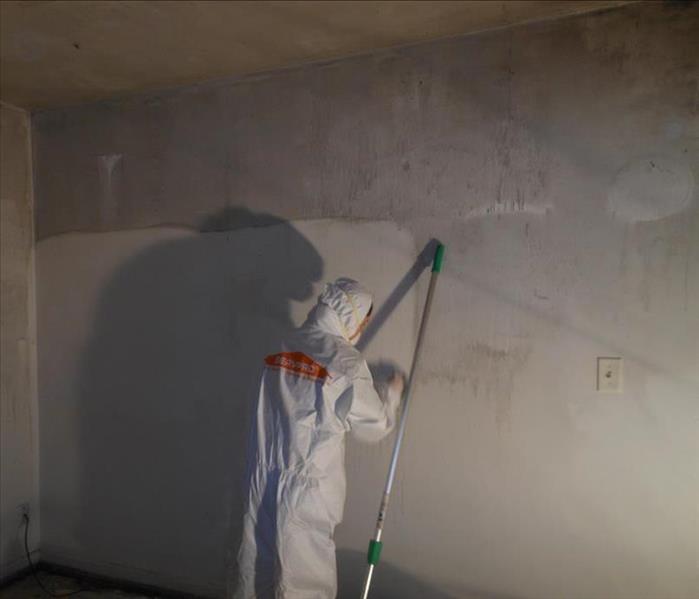 SERVPRO of Beaumont cleaning up a fire loss.
SERVPRO of Beaumont cleaning up a fire loss.
JUST THE FACTS
ABOUT FIRE
In 2014, fires caused 2745 deaths, 11,825 injuries, and $6.8 Billion in property damage.
Three out of five home fire deaths are caused by fires in homes with no smoke alarms or not working alarms.
Working smoke alarms cut the risk of dying in reported home fires in half.
In fires considered large enough to activate the smoke alarm, hardwired alarms operated 94 percent of the time, while battery powered alarms operated 80 percent of the time.
When smoke alarms fail to operate, it is usually because batteries are missing, disconnected, or dead.
One quarter of home fire deaths are caused by fires that start in the bedroom. Another quarter result from fires in the living room, family room or den.
One-third of survey respondents who made an estimate thought they would have at least 6 minutes before a fire in their home would become life-threatening. The time available is often much less. Only 8 percent said their first thought on hearing a smoke alarm would be to get out.
Facts provided by National Fire Protection Association, nfpa.org
WHAT TO DO UNTIL HELP ARRIVES
DO:
- Limit movement in the home to prevent soot particles from being embedded into upholstery and carpet.
- Keep hands clean. Soot on hands can further soil upholstery, walls and woodwork.
- Place dry, colorfast towels or old linens on rugs, upholstery and carpet traffic areas
- If electricity is off, empty freezer/refrigerator completely and prop doors open to help prevent odor.
- Wipe soot from chrome kitchen/bathroom faucets, trim and appliances, then protect these surfaces with a light coating of lubricant.
- If heat is off during winter, pour RV antifreeze in sinks, toilet bowls, holding tanks and tubs to avoid freezing pipes and fixtures.
- Change HVAC filters; leave system off until a trained professional can check the system.
- Tape double layers of cheesecloth over air registers to stop particles of soot from getting in or out of the HVAC system.
DON’T:
- Don’t attempt to wash any walls or painted surfaces without first contacting your SERVPRO® Franchise Professional.
- Don’t attempt to shampoo carpet or upholstered furniture without first consulting your SERVPRO® Franchise Professional.
- Do not attempt to clean any electrical appliances (TV sets, radios, etc.) that may have been close to fire, heat, or water without first consulting an authorized repair service.
- Do not consume any food or beverages that may have been stored close to fire, heat or water, as they may be contaminated.
- If ceiling is wet, do not turn on ceiling fans. Wiring may be wet or damaged and cause electrical shock, and air movement may create secondary damage.
- Don’t send garments to the dry cleaner. Improper cleaning may set in smoke odor.
The SERVPRO Emergency Ready Profile
5/16/2016 (Permalink)
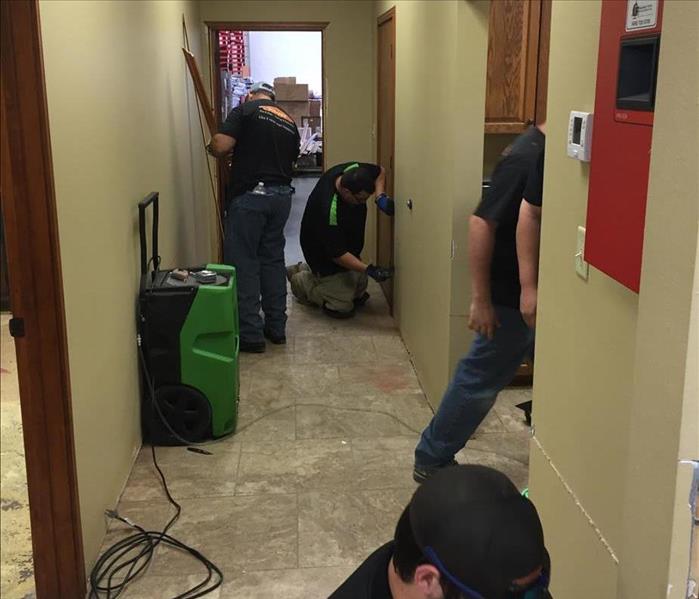 This is a picture of the SERVPRO of Beaumont helping out a flooded commercial building that had an ERP.
This is a picture of the SERVPRO of Beaumont helping out a flooded commercial building that had an ERP.
“Ready for Whatever Happens”
The Best Way to Reduce Business Interruption Following a Disaster is to Plan for it NOW.
As many as 50% of businesses close down following a disaster, according to the latest research. Of the businesses that survive, the overwhelming majority of them had a preparedness plan in place. Pre-planning can serve as an insurance policy aimed at peace of mind. And knowing you are “Ready for whatever happens” speaks trust to your clients and employees that in the event your business is affected by a disaster, they don’t necessarily have to be.
By developing a SERVPRO® Emergency Ready Profile® for your business, you minimize business interruption by having an immediate plan of action. Knowing what to do and what to expect in advance is the key to timely mitigation and can help minimize how water and fire damage can affect your business.
The SERVPRO® Emergency Ready Profile® Advantage
A no cost assessment of your facility.
-This means there is no need to allocate funds, giving you a great value at no cost.
A concise Profile Document that contains only the critical information needed in the event of an emergency.
-It will only take a little time to complete and will not take you away from current projects. But will save a lot of time if ever needed.
A guide to help you get back into your building following a disaster.
-This can help minimize the amount of time your business in active by having an immediate plan of action.
Established your local SERVPRO® Franchise Professional as your disaster mitigation and restoration provider.
-You have a provider that is recognized as an industry leader and is close by.
Identification of the lind of command for authorizing work to begin.
-This saves time so we can begin the work of mitigating the damage which can save you time and money.
Provides facility details such as shut-off valve locations, priority areas and priority contact information.
-Having a quick reference of what to do, how to do it and who to call provides solutions in advance of an emergency so that during the emergency you are “Ready for whatever happens.”
Courtney Cropper and Jacey Ingham are SERVPRO® of Beaumont and SERVPRO® of Orange/Nederland/Lumberton Emergency Ready Profile specialists. Call our office today to schedule your 15 minute appointment!
“Thanks to SERVPRO® our office only assumed partial water damage due to a busted pipe. Why? Because I was able to locate the shut-off valve straight from the Ready Plan app. My boss what out of reach and we didn’t panic. Thank you SERVPRO® for making us “Ready for whatever happens.” –Tracy T.
Flooding is never nice
4/22/2016 (Permalink)
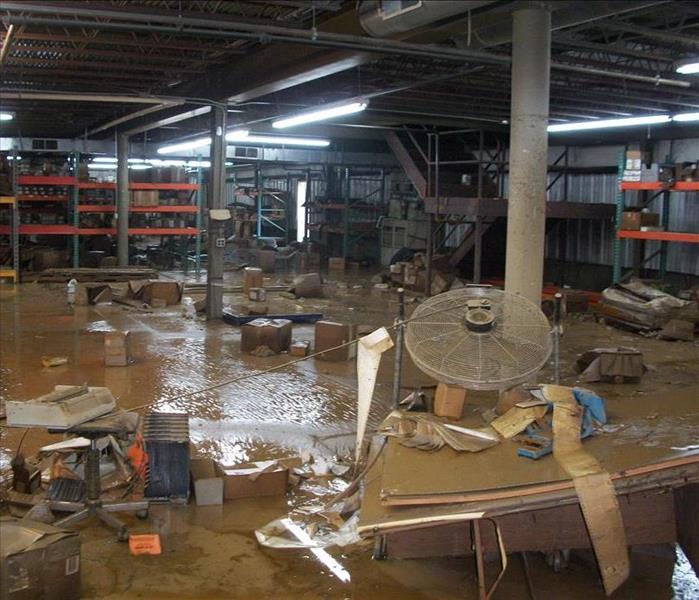 This is a picture of a commercial flood loss SERVPRO of Beaumont helped get back on their feet and back into business.
This is a picture of a commercial flood loss SERVPRO of Beaumont helped get back on their feet and back into business.
Whether you live on the coast, near a lake, or riverside, the flood will find you. And when it does, it can leave you with years’ worth of damage, not to mention credit card bills and bankruptcy.
Various news stories of commercial and residential properties drowning in murky waters, or sitting empty a year later look abandoned and still reeking with ‘remnants of saturated insulation and mold hanging from the beams’ as one homeowner described it…will inject fear into anyone’s heart.
For that reason, the Federal Emergency Management Agency (hhtp://www.fema.gov/) (FEMA) has published a guide stating which materials are best used in certain situations.
It’s interesting because even safe materials, when combined with unsafe products such as adhesives, become undesirable. For instance, vinyl tile is an acceptable surface but if it’s applied over plywood it becomes unacceptable because there’s no way for the plywood to dry after a flood. Even oil-based paint can inhibit drying of a wooden wall.
That’s when you call the professionals at SERVPRO® of Beaumont, to make sure the situation is handled so there are no surprises and no adverse effects on the occupants’ health or safety.
SERVPRO® Cleans Up the Mess after a Flood
FEMA says the following are not permitted in flood-prone areas:
· Normal adhesives which are water soluble or not resistant to alkali or acid in water
· Materials containing wood or paper products, or other materials that lose structural integrity when exposed to water
· Sheet-type floor or wall coverings (linoleum, rubber tile, wallpaper) that inhibit drying of the materials they cover
· Materials that are ‘dimensionally unstable’-for instance, a door jamb that swells and does not return to its original size
· Materials that retain excessive water after they’ve been submerged.
We have so much more to lose…
Homeowners tell us there is no greater devastation than seeing the house they’ve made a home destroyed by a quick-moving flood. The fact that the flood could have been caused by something as innocuous as a leaking pipe behind the washing machine makes the destruction seem even more senseless.
FEMA’s classification was based on the fact that a home constructed with the vulnerable materials may harbor mold, other fungi or allergens; that materials may absorb chemicals and continue to exude them even after the house has been thoroughly dried. In addition, water renders some materials more susceptible to rot. These are just a few of the many aftereffects of a flood.
SERVPRO® of Beaumont Should Be On Speed-Dial
The SERVPRO® of Beaumont team has been trained to respond, swiftly and knowledgably. There’s a reason why FEMA and the EPA recommend consulting with professionals in the wake of water damage.
Back in the day (as they say), houses were made of straw, stone, or brick. If they weren’t blown down or burned up, they were abandoned by the time the children were grown. Today, the American home is our castle. It reflects our lives, interests, and loves, travels, hopes, memories and the most important people we share it with.
Let’s hope you are not victim of a home-destroying event. But if it happens, don’t panic. Keep our number handy: 409.212-1977. We’re here 24/7 to answer the call…and make your loss Like It Never Even Happened.
New Ownership
3/7/2016 (Permalink)
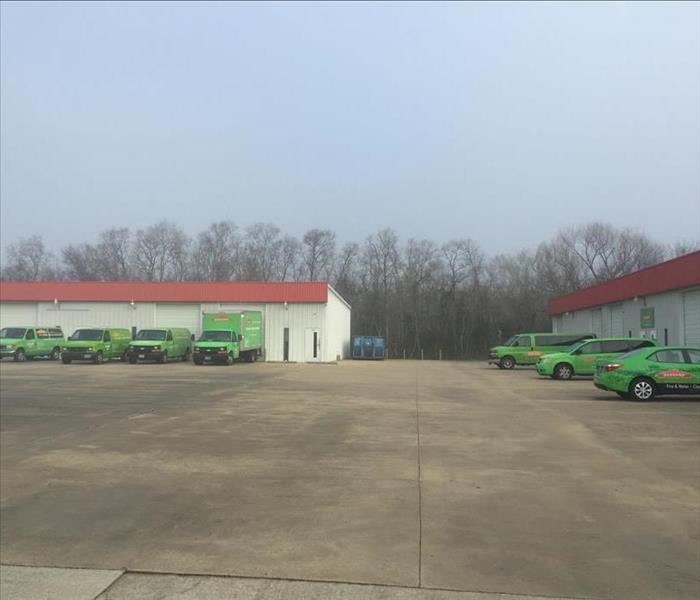 This is a picture of the facility and some of the vehicles.
This is a picture of the facility and some of the vehicles.
The SERVPRO of Beaumont was recently bought by Bill Callahan and Lucas Bell. Before the acquistion Bill and Lucas owned the SERVPRO of Orange/Nederland/Lumberton. The new owners have combined both businesses under one roof which is located in Beaumont, Texas. The SERVPRO of Beaumont is a full service fire and water restorartion and build back company. The company is locally owned which both owners have lived in Southeast Texas for over thirty five years each. SERVPRO of Beaumont is here to help twenty four hours a day three hunderd sixty five days a year.




 24/7 Emergency Service
24/7 Emergency Service




